![]()
Vincent van Gogh, Olive Trees, June/September 1889
| Artist | Vincent van Gogh, Dutch, 1853–90 |
| Title | Olive Trees |
| Object Date | June/September 1889 |
| Alternate and Variant Titles | Oliviers; Les Oliviers, effet du matin; Olive Orchard |
| Medium | Oil on canvas |
| Dimensions (Unframed) | 28 3/4 x 36 1/4 in. (73 x 92.1 cm) |
| Credit Line | The Nelson-Atkins Museum of Art. Purchase: William Rockhill Nelson Trust, 32-2 |
Catalogue Entry
Citation
Chicago:
Aimee Marcereau DeGalan, “Vincent van Gogh, Olive Trees, June/September 1889,” catalogue entry in ed. Aimee Marcereau DeGalan French Paintings and Pastels, 1600–1945: The Collections of the Nelson-Atkins Museum of Art (Kansas City: The Nelson-Atkins Museum of Art, 2021), https://doi.org/10.37764/78973.5.738.5407
MLA:
Marcereau DeGalan, Aimee. “Vincent van Gogh, Olive Trees, June/September 1889,” catalogue entry. French Paintings and Pastels, 1600–1945: The Collections of the Nelson-Atkins Museum of Art, edited by Aimee Marcereau DeGalan, The Nelson-Atkins Museum of Art, 2021. doi: 10.37764/78973.5.738.5407.
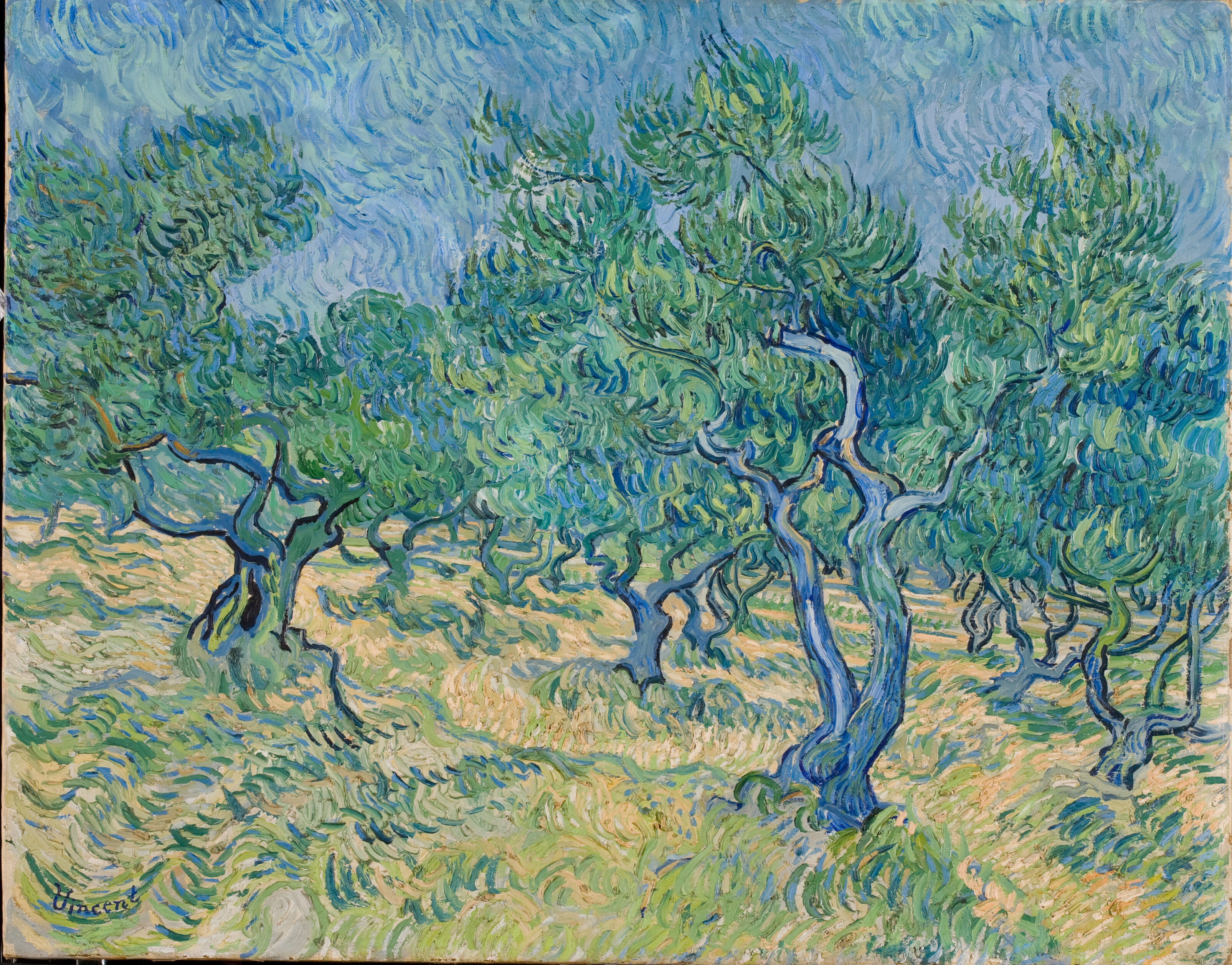 Fig. 1. Vincent van Gogh, Olive Grove, July 1889, oil on canvas, 28 1/2 x 35 15/16 in. (72.4 x 91.9 cm), Collection Kröller-Müller Museum, Otterlo, the Netherlands, KM 104.278. Photo by Rik Klein Gotink
Fig. 1. Vincent van Gogh, Olive Grove, July 1889, oil on canvas, 28 1/2 x 35 15/16 in. (72.4 x 91.9 cm), Collection Kröller-Müller Museum, Otterlo, the Netherlands, KM 104.278. Photo by Rik Klein Gotink
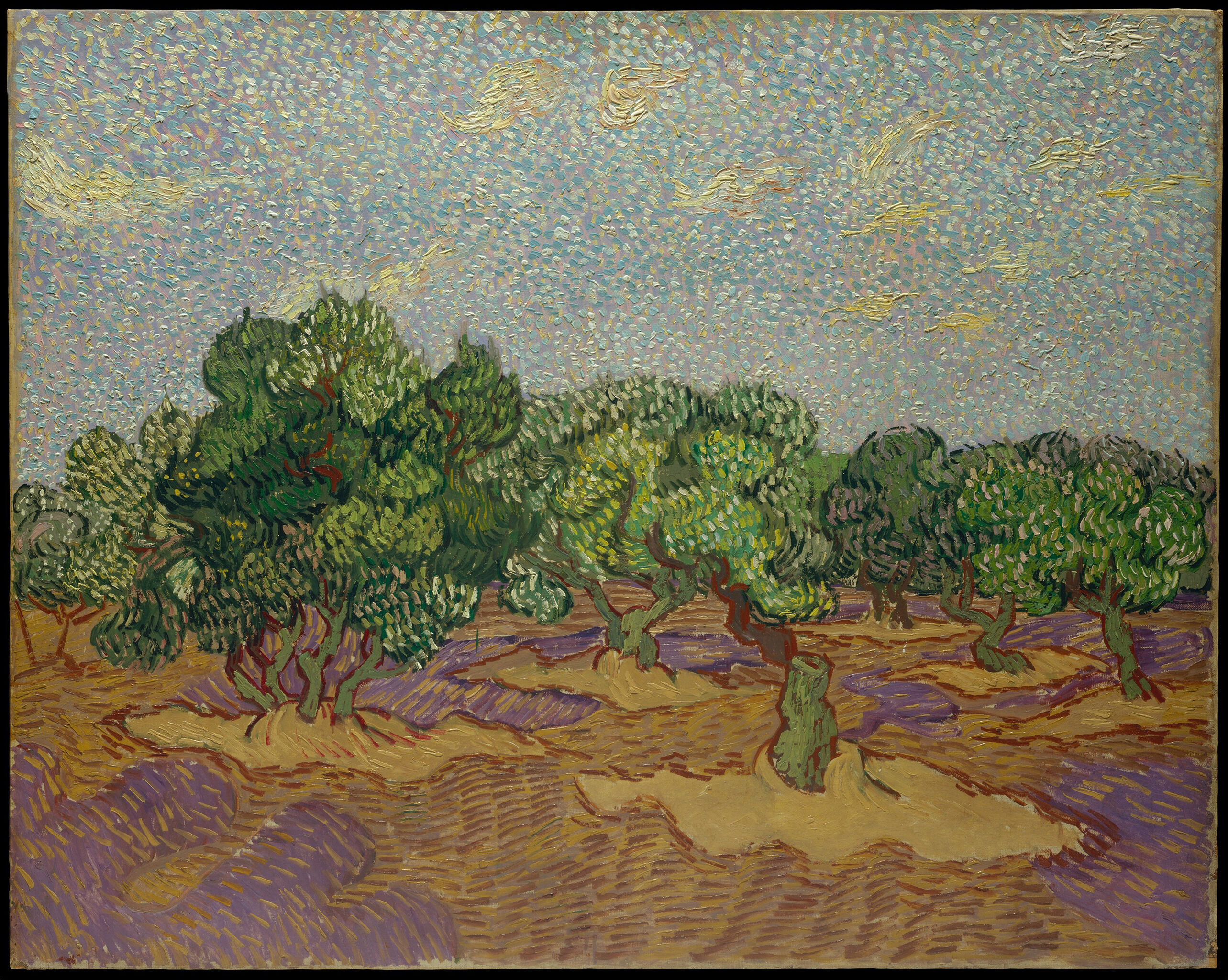 Fig. 2. Vincent van Gogh, The Olive Trees, November 1889, oil on canvas, 28 5/8 x 36 in. (72.6 x 91.4 cm), The Metropolitan Museum of Art, New York, 1998.325.1. The Walter H. and Leonore Annenberg Collection, Gift of Walter H. and Leonore Annenberg, 1998, Bequest of Walter H. Annenberg, 2002
Fig. 2. Vincent van Gogh, The Olive Trees, November 1889, oil on canvas, 28 5/8 x 36 in. (72.6 x 91.4 cm), The Metropolitan Museum of Art, New York, 1998.325.1. The Walter H. and Leonore Annenberg Collection, Gift of Walter H. and Leonore Annenberg, 1998, Bequest of Walter H. Annenberg, 2002
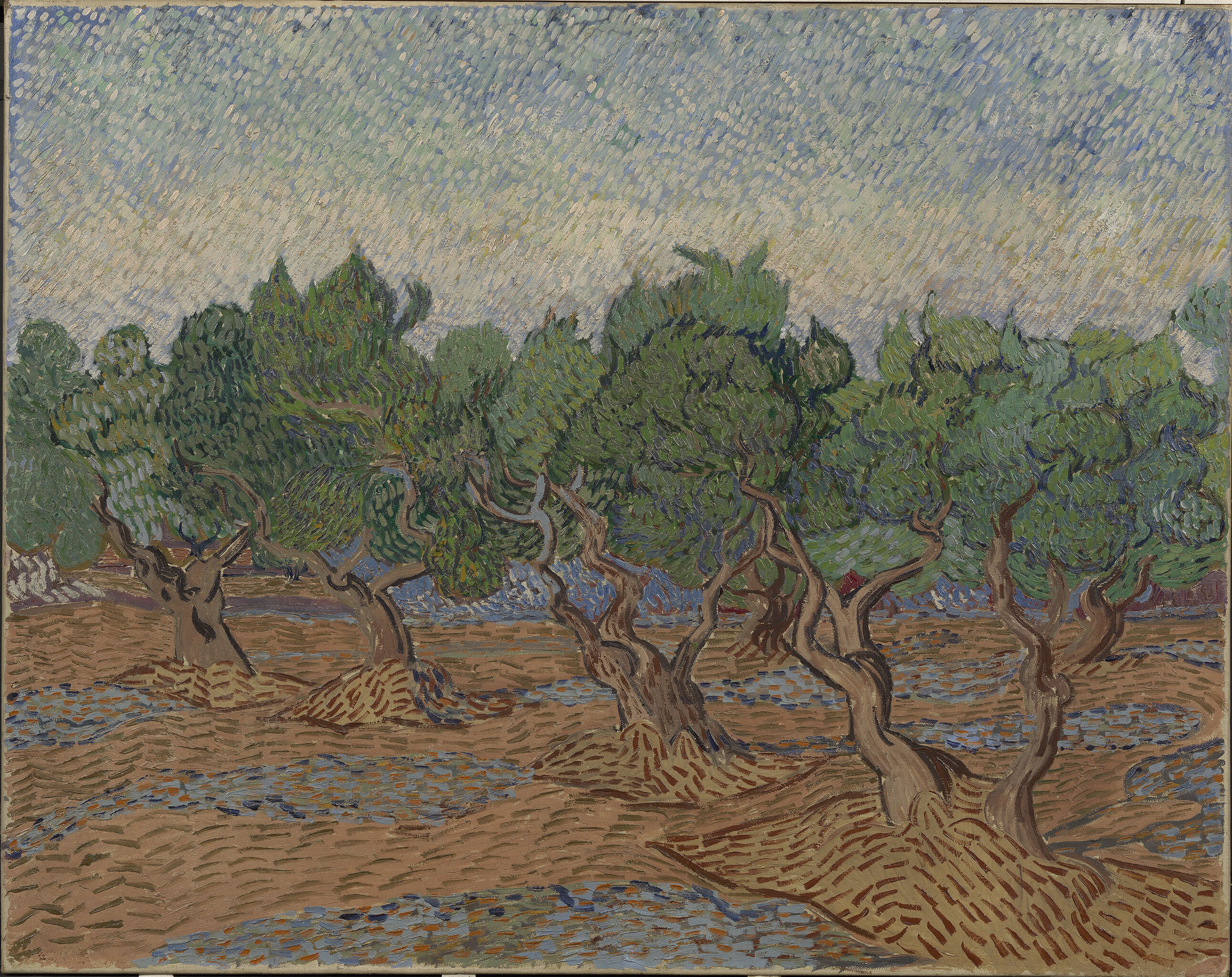
While at Saint-Rémy, Van Gogh was under the care of Dr. Théophile Peyron, a former naval doctor. For the first month of the artist’s stay, Peyron insisted he remain inside to rest, so Van Gogh looked out his window to the garden and painted the irises, butterflies, and poppies he saw there.8See Vincent van Gogh, Irises, 1889, oil on canvas, 29 1/4 x 37 1/8 in. (74.3 x 94.3 cm), J. Paul Getty Museum, Los Angeles; and Vincent van Gogh, Butterflies and Poppies, May–June 1889, oil on canvas, 13 3/4 x 10 in. (35 cm x 25.5 cm), Van Gogh Museum, Amsterdam. For him, budding flowers symbolized the cycle of life; he saw trees, the landscape, caterpillars, and the emergent cicadas as representative of transformation, something he hoped would happen to him while recuperating.9One year before checking himself in at Saint-Rémy, Van Gogh referenced Émile Zola’s La Faute de l’Abbé Mouret, an 1875 novel about a monk who finds solace in an overgrown garden where a young woman nurses him back to health. This sheds light onto his interest in gardens and his belief in their restorative effect. Jennifer Helvey, Irises: Vincent van Gogh in the Garden (Los Angeles: J. Paul Getty Publications, 2009), 96. Van Gogh longed to paint outside, beyond the confines of the facility’s enclosed courtyard. By the first week of June, Peyron lifted the restrictions, and Van Gogh got his wish.
With a fresh supply of materials from his brother, Theo, Van Gogh started at least five paintings featuring olive trees in or around June 1889, including the Nelson-Atkins picture, which he painted on a commercially pre-primed, standard size 30 canvas.10See the accompanying technical entry by Schafer and Twilley. Verdant olive trees and a meandering path rendered in long, curving brushstrokes of gray-green and yellow are bordered by a brilliant row of red poppies. These elements invite viewers into the composition. The vertical wet-into-wet brushstrokes of the path are met by horizontal brushstrokes that articulate the ruggedness of the terrain beneath the trees (Fig. 11 in Conservation Technical Entry). In other areas of the composition, in particular at the far right in the trees (Fig. 17 in Conservation Technical Entry), Van Gogh applied short dabs of fresh yellow paint over longer strokes which had already dried. This is one indication that he painted the composition in two distinct sessions.11For further information on this aspect of Van Gogh’s painting, see the accompanying technical entry by Schafer and Twilley. Dappled spots of sunlight shine between the olive trees, making the heat of southern France feel almost palpable. Without painting the sun, Van Gogh transmitted its energy to his canvas.
The relationships between colors, and how they interact to intensify tones and create harmony, mood, and emotion, were essential to Van Gogh; he was particularly interested in the juxtaposition of complementary colors (red/green, blue/orange, violet/yellow). He learned about these pairings by looking at the work of Eugène Delacroix (1798–1863) and reading Charles Blanc’s Grammaire des arts du dessin (1867).12The first color of each pair is a primary: red, yellow, and blue. Mixing them produces a secondary color: for example, red and blue make purple. That secondary color is complementary to the primary color that was not used in the mixture. Those primary and secondary colors, such as red and green, reinforce each other when juxtaposed. This phenomenon, known as the law of “simultaneous contrast,” was first described by the physicist Michel Eugène Chevreul in 1839 and practiced by the artist Eugène Delacroix. It had a tremendous impact on Van Gogh’s palette. See Charles Blanc, The Grammar of Painting and Engraving, trans. Kate Newell Doggett, 3rd ed. (1867; repr., New York, Hurd and Houghton, 1879). See also Michel Eugène Chevreul, The Principles of Harmony and Contrast of Colours and their Applications to the Arts, trans. Charles Martel (1839; repr., London: Bell, 1916). Van Gogh cites Delacroix numerous times throughout his letters, referencing his interest in Delacroix’s use of color. Van Gogh wrote to Theo on April 18, 1885 (Jansen et al., Letters, http://vangoghletters.org/en/let494) and copied a passage out of Charles Blanc on Delacroix that ties these interests together. The passage Van Gogh copied comes from Blanc, Les artistes de mon temps, 64-66, 69, as cited in Jansen et al., Letters, http://vangoghletters.org/en/let494, n10. Some of these color relationships appear in the Nelson-Atkins canvas: red poppies are set against or in close proximity to green foliage, and brilliant strokes of yellow/orange run alongside blue outlines of select trees.13Information on the specific pigments was obtained from Schafer and Twilley. See their accompanying technical entry for palette analysis. Seemingly missing in this group of complementary pairings, however, is violet and yellow.
Mapping Van Gogh’s palette in the Kansas City picture—tracking the locations where he used specific pigments—is essential for understanding the artist’s original intent. One of many findings through recent X-ray fluorescence spectrometry elemental mapping (MA-XRF), conducted by Mellon science advisor John Twilley and Nelson-Atkins paintings conservator Mary Schafer, revealed that the artist used a mixture of “geranium lake” and zinc white with cobalt and ultramarine blues in the shadows at the base of the olive trees. Because Van Gogh knew that geranium lake had a propensity to fade, he compensated by applying it in greater concentration.14Vincent van Gogh to Theo van Gogh, Arles, on or about Wednesday, April 11, 1888, in Jansen et al., Letters, http://vangoghletters.org/en/let595: “All the colors that Impressionism has made fashionable are unstable, all the more reason boldly to use them too raw, time will only soften them too much.” Original emphasis. This strategy, however, was not sufficient over the long term.15Geranium lake fades more completely when mixed with zinc white, as Van Gogh did at the base of the trees. See the accompanying technical entry by Schafer and Twilley. Only the blue and zinc white components remain visible, thus yielding blue shadows beneath the trees, where violet was intended to serve as a complement to the nearby yellowish orange strokes in the tree trunks.16The more extreme effect of fading occurs in the now mostly white mixtures of the foreground. These and other newly revealed complementary pairings, based on technical analyses of the painting, can be found in the accompanying technical entry by Schafer and Twilley. The discovery of the once-violet shadows connects the painting more firmly to a letter the artist wrote to his sister on June 16, 1889, about a landscape of an olive grove he had “just finished” with gray leaves, “their cast shadows violet on the sun-drenched sand.”17Ronald Pickvance was the first scholar to associate this letter with the Nelson-Atkins painting. See Ronald Pickvance, Van Gogh in Saint-Rémy and Auvers (New York: Metropolitan Museum of Art, and New York: Abrams, 1986), 293. See also the accompanying technical entry by Schafer and Twilley. Previously, many scholars believed the letter related to an olive tree study the artist painted in June of 1889 (National Gallery of Scotland) that the artist sent to his brother on consignment a month later.
The phrase “just finished” proves troubling.18Van Gogh felt the canvas was finished on June 16. He set it aside, having either rolled it or stacked it with other unstretched work while still somewhat wet, as evidenced by the presence of canvas weave impressions in the impasto. See accompanying technical entry. We know that Van Gogh was only allowed to paint outdoors in the first week of June, and this does not seem to allow enough time for him to have realized two successive campaigns of painting, with the earlier layers of paint left undisturbed and no evidence of intermixing of colors. In other words, evidence of wet-over-dry brushwork indicates that Van Gogh applied paint to the canvas again after it was dry (Fig. 14 in Conservation Technical Entry). While it is impossible to determine precisely how much time would be needed for the paint to dry between the artist’s initial campaign, begun no earlier than the first week of June, and a second campaign, it is highly unlikely this could have occurred by June 16, when he wrote the letter to his sister that he had “just finished” the picture. Determining when Van Gogh may have painted the second campaign of the Nelson-Atkins painting is critical to understanding how the picture fits within the Olive Tree series.
Many scholars argue that Van Gogh’s more stylized approach to the Olive Tree series, associated with the work he undertook in the fall of 1889, was in reaction to a group of imaginative religious paintings recently shared with him by Gauguin and Bernard.19In a letter sent to Émile Bernard on or about November 26, Van Gogh chastises him for his imaginative approach to his subject matter and advises him to start with nature. This is based on a number of religious compositions Bernard had recently shared with Van Gogh. In their respective object labels online, the Metropolitan Museum of Art and the Van Gogh Museum suggest that their fall Olive Tree paintings, with their stylized brushwork, are in response to Gauguin’s and Bernard’s recent compositions; however, these artists did not send their works to Van Gogh until well after he retouched the Nelson-Atkins composition with short, stippled brushwork. See https://www.metmuseum.org/art/collection/search/437998 (accessed August 24, 2020) and https://www.vangoghmuseum.nl/en/collection/s0045V1962 (accessed August 24, 2020). Vincent van Gogh to Émile Bernard, on or about November 26, 1889, in Jansen et al., Letters, http://vangoghletters.org/en/let822. It is this author’s contention, however, that Van Gogh’s shift in thinking about approach started earlier. Van Gogh suffered a mental relapse between the first (summer) and second (fall) group of Olive Tree pictures. From July 16 until August 22, he could neither write nor paint. By September 5–6, he still had not set foot outside, but he was back at his easel “retouching some studies from this summer . . . with renewed clarity,” as he wrote to Theo.20Vincent van Gogh to Theo van Gogh, Saint-Rémy-de-Provence, Thursday, September 5, to Friday, September 6, 1889, in Jansen et al., Letters, http://vangoghletters.org/en/let800. This timing could work for a second campaign of paint on the Nelson-Atkins composition, allowing enough drying time for him to include it in the third group of paintings he sent to Theo (his art dealer as well as his brother) on September 28.21Van Gogh sent seven consignments to Theo during his time at Saint-Rémy. The first, on July 15, did not include the Kansas City painting. Scholars including Jansen, Luijten, and Bakker contend that while Van Gogh mentions sending an olive tree composition in this first batch of paintings, it was not a size 30 canvas and therefore could not have been the Nelson-Atkins composition. See Vincent van Gogh, Saint-Rémy-de-Provence, to Theo van Gogh, Sunday, July 14, or Monday, July 15, 1889, in Jansen et al., Letters, http://vangoghletters.org/en/let789. Van Gogh sent the next two batches to Theo in short succession on September 19 and September 28. While it is possible he included the Kansas City painting in the consignment on September 19, this would have only given the canvas a little less than two weeks of drying time, making it more plausible that he included it in the September 28 shipment. See the accompanying technical entry by Schafer and Twilley. Van Gogh’s period of reinvigoration came at the same moment he received an invitation to exhibit with Bernard and Les XX, a group of twenty avant-garde artists founded by attorney Octave Maus, in their next exhibition in Brussels.22He mentions this invitation in the same September 5–6 letter in which he talks about having renewed clarity (Vincent van Gogh to Theo van Gogh, September 5–6, 1889, in Jansen et., Letters, http://vangoghletters.org/en/let800). The exhibitions of Les XX also included a number of symbolist and Neo-Impressionist painters such as Theo van Rysselberghe (Belgian, 1862–1926), Maximilien Luce (1858–1941), Henri-Edmond Cross (1856–1910), and Georges Seurat (1859–91), all of whom exhibited in the 1889 exhibition and many of whom painted in a pointillist style, with tiny dabs of pure color.23Theo van Rysselberghe met with Theo van Gogh in Paris in 1889, and Theo showed Van Rysselberghe many of Vincent’s paintings. This may have precipitated the invitation for Vincent to exhibit with Les XX the following year. See letter from Theo van Gogh to Vincent van Gogh, Paris, Tuesday, October 22, 1889, in which he mentions this meeting, in Jansen et al., Letters, http://vangoghletters.org/en/let813. In that same letter of September 5–6, Van Gogh continued, “I would really like to exhibit there, while feeling my inferiority alongside so many Belgians who have an enormous amount of talent.”24Van Gogh singles out Belgian Symbolist painter Xavier Mellery (1845–1921), who he felt had an enormous amount of talent. Vincent van Gogh to Theo van Gogh, September 5–6, 1889, in Jansen et al., Letters, http://vangoghletters.org/en/let800. A few days later, on September 10, he revealed to Theo how his newfound clarity affected his approach to painting, his brushwork in particular:
What a funny thing the touch is, the brushstroke. Out of doors, exposed to the wind, the sun, people’s curiosity, one works as one can, one fills one’s canvas regardless. Yet then one catches the true and the essential—that’s the most difficult thing. But when one returns to this study again after a time, and orders one’s brushstrokes in the direction of the objects—certainly it’s more harmonious and agreeable to see, and one adds to it whatever one has of serenity and smiles.25Vincent van Gogh, Saint-Rémy-de-Provence, to Theo van Gogh, Tuesday, September 10, 1889, in Jansen et al., Letters, http://vangoghletters.org/en/let801.
All of these ideas, along with the invitation in September to exhibit with Les XX (and his ensuing trepidation about it), were with him at the precise moment he returned to retouch the Nelson-Atkins picture, which includes many passages of short, stippled brushwork. Ordering his brushstrokes “in the direction of the objects,” while a continuation of his earlier approach that summer, became more definitive in the fall Olive Tree paintings. The final state of the Nelson-Atkins composition reflects the artist’s effort to work through these ideas well after initiating the project in early June. This positions the Kansas City picture as a transitional painting within the Olive Tree series, belonging more to the paintings he completed in the fall rather than the summer pictures.
Regardless of his approach in the Olive Trees series, Van Gogh found something eternal in the continuous rhythm of their twisted forms. His undulating brushstrokes of color make the soil come alive with the same energy that animates the branches rustling in the wind. The brushwork in the Nelson-Atkins painting, and in the Olive Tree series in general, communicates in a physical way the living force that Van Gogh found within the trees themselves.26For more on the dynamic force and spiritual essence that Van Gogh saw in trees, see Ralph Skea, Vincent’s Trees: Paintings and Drawings by Van Gogh (London: Thames and Hudson, 2013), 15; and Vincent van Gogh, Auvers-sur-Oise, to Joseph Isaäcson, May 25, 1890, in Jansen et al., Letters, http://vangoghletters.org/vg/letters/RM21/letter.html.
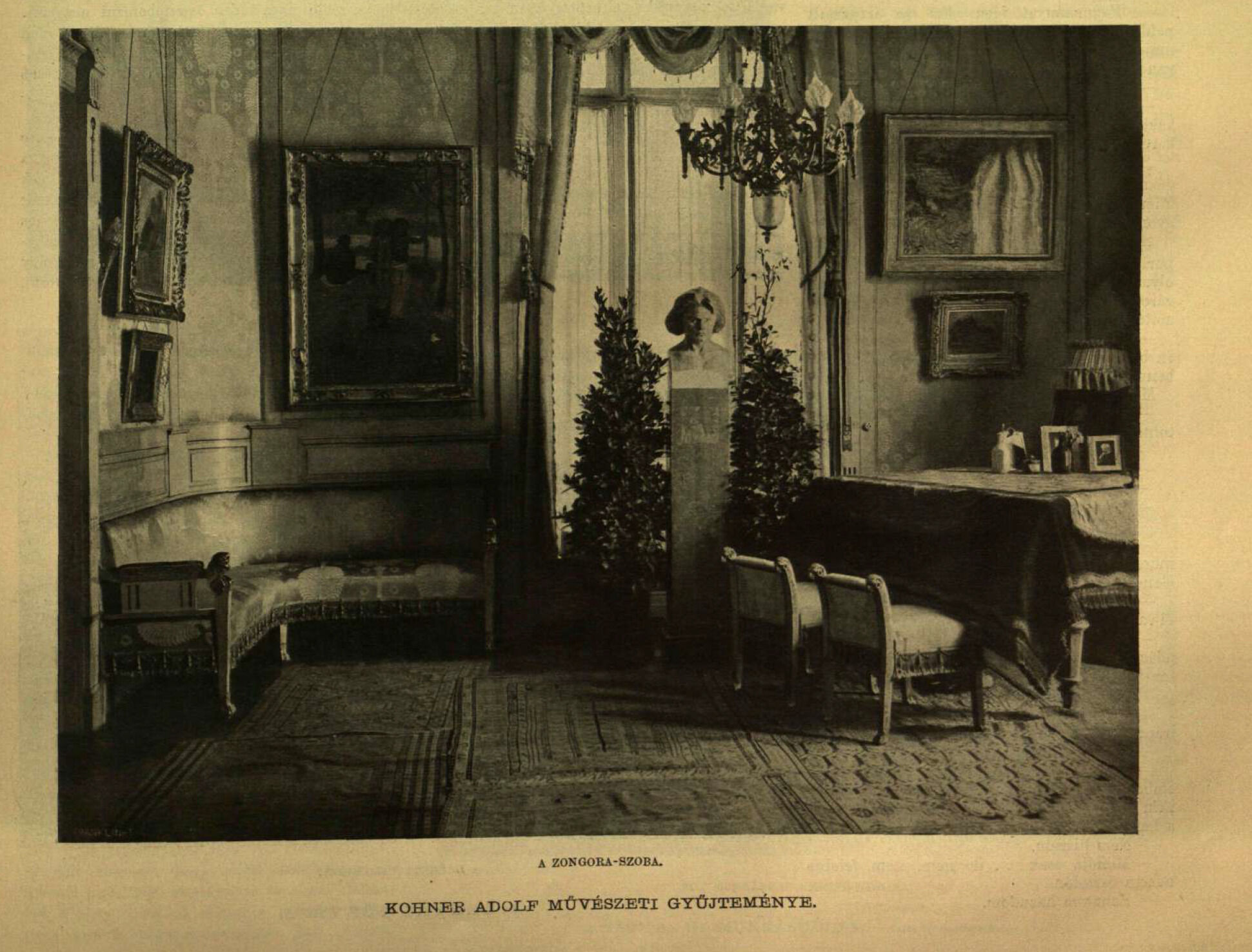
Notes
-
Vincent van Gogh to Émile Bernard, on or about Tuesday, October 8, 1889, in Van Gogh Museum, Amsterdam, no. b634 V/1962; published in Leo Jansen, Hans Luijten, and Nienke Bakker, eds., Vincent Van Gogh: The Letters, online edition (Amsterdam and The Hague: Van Gogh Museum and Huygens, 2009), http://vangoghletters.org/en/let809. All English translations are from this publication.
-
Eleven of these are on size 30 canvases, including the Nelson-Atkins painting.
-
Van Gogh read about the “ton rompu” (broken tone), the “ton vif” (strong tone) and “les tons voisins” (neighboring tones) in Charles Blanc’s essay on Delacroix: Charles Blanc, Les artistes de mon temps (Paris: Firmin-Didot, 1876), 65, 69–71, as cited in Van Gogh’s letter to his brother Theo from mid-June 1884. See Jansen et al., Letters, http://vangoghletters.org/en/let450.
-
The initial inquiries into this question began with NAMA former associate curator of European painting Nicole Myers, paintings conservator Mary Schafer, and Mellon science advisor John Twilley.
-
In a letter to Theo in April 1889, Van Gogh remarked “Oh my dear Theo, if you saw the olive trees at this time. . . . It is something completely different from one’s idea of it in the North—it’s a thing of such delicacy—so refined. It is like the looped willows of our Dutch meadows . . . , that is to say, the rustle of an olive grove has something very intimate, something tremendously old about it.” Vincent van Gogh, Arles, to Theo van Gogh, April 28, 1889, in Jansen et al., Letters, http://vangoghletters.org/en/let763.
-
Vincent van Gogh, Arles, to Theo van Gogh, September 21, 1888, in Jansen et al., Letters, http://vangoghletters.org/en/let685.
-
Vincent van Gogh to Theo van Gogh, September 21, 1888, in Jansen et al., Letters, http://vangoghletters.org/en/let685. See also Samantha Friedman, Van Gogh, Dalí, and Beyond: The World Reimagined, exh. cat. (New York: Museum of Modern Art, 2013), 15–17.
-
See Vincent van Gogh, Irises, 1889, oil on canvas, 29 1/4 x 37 1/8 in. (74.3 x 94.3 cm), J. Paul Getty Museum, Los Angeles; and Vincent van Gogh, Butterflies and Poppies, May–June 1889, oil on canvas, 13 3/4 x 10 in. (35 cm x 25.5 cm), Van Gogh Museum, Amsterdam.
-
One year before checking himself in at Saint-Rémy, Van Gogh referenced Émile Zola’s La Faute de l’Abbé Mouret, an 1875 novel about a monk who finds solace in an overgrown garden where a young woman nurses him back to health. This sheds light onto his interest in gardens and his belief in their restorative effect. Jennifer Helvey, Irises: Vincent van Gogh in the Garden (Los Angeles: J. Paul Getty Publications, 2009), 96.
-
See the accompanying technical entry by Schafer and Twilley.
-
For further information on this aspect of Van Gogh’s painting, see the accompanying technical entry by Schafer and Twilley.
-
The first color of each pair is a primary: red, yellow, and blue. Mixing them produces a secondary color: for example, red and blue make purple. That secondary color is complementary to the primary color that was not used in the mixture. Those primary and secondary colors, such as red and green, reinforce each other when juxtaposed. This phenomenon, known as the law of “simultaneous contrast,” was first described by the physicist Michel Eugène Chevreul in 1839 and practiced by the artist Eugène Delacroix. It had a tremendous impact on Van Gogh’s palette. See Charles Blanc, The Grammar of Painting and Engraving, trans. Kate Newell Doggett, 3rd ed. (1867; repr., New York, Hurd and Houghton, 1879). See also Michel Eugène Chevreul, The Principles of Harmony and Contrast of Colours and their Applications to the Arts, trans. Charles Martel (1839; repr., London: Bell, 1916). Van Gogh cites Delacroix numerous times throughout his letters, referencing his interest in Delacroix’s use of color. Van Gogh wrote to Theo on April 18, 1885 (Jansen et al., Letters, http://vangoghletters.org/en/let494) and copied a passage out of Charles Blanc on Delacroix that ties these interests together. The passage Van Gogh copied comes from Blanc, Les artistes de mon temps, 64-66, 69, as cited in Jansen et al., Letters, http://vangoghletters.org/en/let494, n10.
-
Information on the specific pigments was obtained from Schafer and Twilley. See their accompanying technical entry for palette analysis.
-
Vincent van Gogh to Theo van Gogh, Arles, on or about Wednesday, April 11, 1888, in Jansen et al., Letters, http://vangoghletters.org/en/let595: “All the colors that Impressionism has made fashionable are unstable, all the more reason boldly to use them too raw, time will only soften them too much.” Original emphasis.
-
Geranium lake fades more completely when mixed with zinc white, as Van Gogh did at the base of the trees. See the accompanying technical entry by Schafer and Twilley.
-
The more extreme effect of fading occurs in the now mostly white mixtures of the foreground. These and other newly revealed complementary pairings, based on technical analyses of the painting, can be found in the accompanying technical entry by Schafer and Twilley.
-
Ronald Pickvance was the first scholar to associate this letter with the Nelson-Atkins painting. See Ronald Pickvance, Van Gogh in Saint-Rémy and Auvers (New York: Metropolitan Museum of Art, and New York: Abrams, 1986), 293. See also the accompanying technical entry by Schafer and Twilley. Previously, many scholars believed the letter related to an olive tree study the artist painted in June of 1889 (National Gallery of Scotland) that the artist sent to his brother on consignment a month later.
-
Van Gogh felt the canvas was finished on June 16. He set it aside, having either rolled it or stacked it with other unstretched work while still somewhat wet, as evidenced by the presence of canvas weave impressions in the impasto. See accompanying technical entry.
-
In a letter sent to Émile Bernard on or about November 26, Van Gogh chastises him for his imaginative approach to his subject matter and advises him to start with nature. This is based on a number of religious compositions Bernard had recently shared with Van Gogh. In their respective object labels online, the Metropolitan Museum of Art and the Van Gogh Museum suggest that their fall Olive Tree paintings, with their stylized brushwork, are in response to Gauguin’s and Bernard’s recent compositions; however, these artists did not send their works to Van Gogh until well after he retouched the Nelson-Atkins composition with short, stippled brushwork. See https://www.metmuseum.org/art/collection/search/ 437998 (accessed August 24, 2020) and https://www.vangoghmuseum.nl/en/collection/ s0045V1962 (accessed August 24, 2020). Vincent van Gogh to Émile Bernard, on or about November 26, 1889, in Jansen et al., Letters, http://vangoghletters.org/en/let822.
-
Vincent van Gogh to Theo van Gogh, Saint-Rémy-de-Provence, Thursday, September 5, to Friday, September 6, 1889, in Jansen et al., Letters, http://vangoghletters.org/en/let800.
-
Van Gogh sent seven consignments to Theo during his time at Saint-Rémy. The first, on July 15, did not include the Kansas City painting. Scholars including Jansen, Luijten, and Bakker contend that while Van Gogh mentions sending an olive tree composition in this first batch of paintings, it was not a size 30 canvas and therefore could not have been the Nelson-Atkins composition. See Vincent van Gogh, Saint-Rémy-de-Provence, to Theo van Gogh, Sunday, July 14, or Monday, July 15, 1889, in Jansen et al., Letters, http://vangoghletters.org/en/let789. Van Gogh sent the next two batches to Theo in short succession on September 19 and September
-
While it is possible he included the Kansas City painting in the consignment on September 19, this would have only given the canvas a little less than two weeks of drying time, making it more plausible that he included it in the September 28 shipment. See the accompanying technical entry by Schafer and Twilley.
-
He mentions this invitation in the same September 5–6 letter in which he talks about having renewed clarity (Vincent van Gogh to Theo van Gogh, September 5–6, 1889, in Jansen et., Letters, http://vangoghletters.org/en/let800).
-
Theo van Rysselberghe met with Theo van Gogh in Paris in 1889, and Theo showed Van Rysselberghe many of Vincent’s paintings. This may have precipitated the invitation for Vincent to exhibit with Les XX the following year. See letter from Theo van Gogh to Vincent van Gogh, Paris, Tuesday, October 22, 1889, in which he mentions this meeting, in Jansen et al., Letters, http://vangoghletters.org/en/let813.
-
Van Gogh singles out Belgian Symbolist painter Xavier Mellery (1845–1921), who he felt had an enormous amount of talent. Vincent van Gogh to Theo van Gogh, September 5–6, 1889, in Jansen et al., Letters, http://vangoghletters.org/en/let800.
-
Vincent van Gogh, Saint-Rémy-de-Provence, to Theo van Gogh, Tuesday, September 10, 1889, in Jansen et al., Letters, http://vangoghletters.org/en/let801.
-
For more on the dynamic force and spiritual essence that Van Gogh saw in trees, see Ralph Skea, Vincent’s Trees: Paintings and Drawings by Van Gogh (London: Thames and Hudson, 2013), 15; and Vincent van Gogh, Auvers-sur-Oise, to Joseph Isaäcson, May 25, 1890, in Jansen et al., Letters, http://vangoghletters.org/vg/letters/RM21/letter.html.
-
The honor of the first goes to the Detroit Institute of Arts, with their 1922 acquisition of Van Gogh’s Self-Portrait in a Straw Hat (1887). For more on the history of the Van Gogh painting entering the Nelson-Atkins collection, see my introductory essay, “The Collecting of French Paintings in Kansas City,” in this publication.
Technical Entry
Citation
Chicago:
Mary Schafer and John Twilley, “Vincent van Gogh, Olive Trees, June/September 1889,” technical entry in ed. Aimee Marcereau DeGalan French Paintings and Pastels, 1600–1945: The Collections of the Nelson-Atkins Museum of Art (Kansas City: The Nelson-Atkins Museum of Art, 2021), https://doi.org/10.37764/78973.5.738.2088
MLA:
Schafer, Mary and John Twilley. “Vincent van Gogh, Olive Trees, June/September 1889,” technical entry. French Paintings and Pastels, 1600–1945: The Collections of the Nelson-Atkins Museum of Art, edited by Aimee Marcereau DeGalan, The Nelson-Atkins Museum of Art, 2021. doi: 10.37764/78973.5.738.2088.
Olive Trees was executed on a tightly woven, plain weaveplain weave: A basic textile weave in which one weft thread alternates over and under the warp threads. Often this structure consists of one thread in each direction, but threads can be doubled (basket weave) or tripled to create more complex plain weave. Plain weave is sometimes called tabby weave. canvas that corresponds in size to a no. 30 figure standard-format supportstandard-format supports: Commercially prepared supports available through art suppliers, which gained popularity in the nineteenth century during the industrialization of art materials. Available in three formats figure (portrait), paysage (landscape), and marine (marine), these were numbered 1 through 120 to indicate their size. For each numbered size, marine and paysage had two options available: a larger format (haute) and smaller (basse) format..1Anthea Callen, The Art of Impressionism: Painting Technique and the Making of Modernity (London: Yale University Press, 2000), 15. While painting in Saint Rémy, Vincent van Gogh (1853–90) would often cut a segment of primed canvas from a larger roll and attach it to a temporary, working frame. Any evidence for this process was removed with the tacking marginstacking margins: The outer edges of canvas that wrap around and are attached to the stretcher or strainer with tacks or staples. See also tacking edge. when the Nelson-Atkins painting was glue-linedlining: A procedure used to reinforce a weakened canvas that involves adhering a second fabric support using adhesive, most often a glue-paste mixture, wax, or synthetic adhesive., sometime prior to the 1932 acquisition. Paper now covers the outermost edges, and it is unclear if the current six-member stretcherstretcher: A wooden structure to which the painting’s canvas is attached. Unlike strainers, stretchers can be expanded slightly at the joints to improve canvas tension and avoid sagging due to humidity changes or aging. with mortise and tenon joins is original. The thin, off-white ground layerground layer: An opaque preparatory layer applied to the support, either commercially or by the artist, to prevent absorption of the paint into the canvas or panel. See also priming layer. was commercially applied using lead white containing small additions of both crushed natural barite and lithopone, colored by traces of silica and iron oxides (see Table 1).2The scientific study of Olive Trees was supported by an endowment from the Andrew W. Mellon Foundation for conservation science at The Nelson-Atkins Museum of Art.
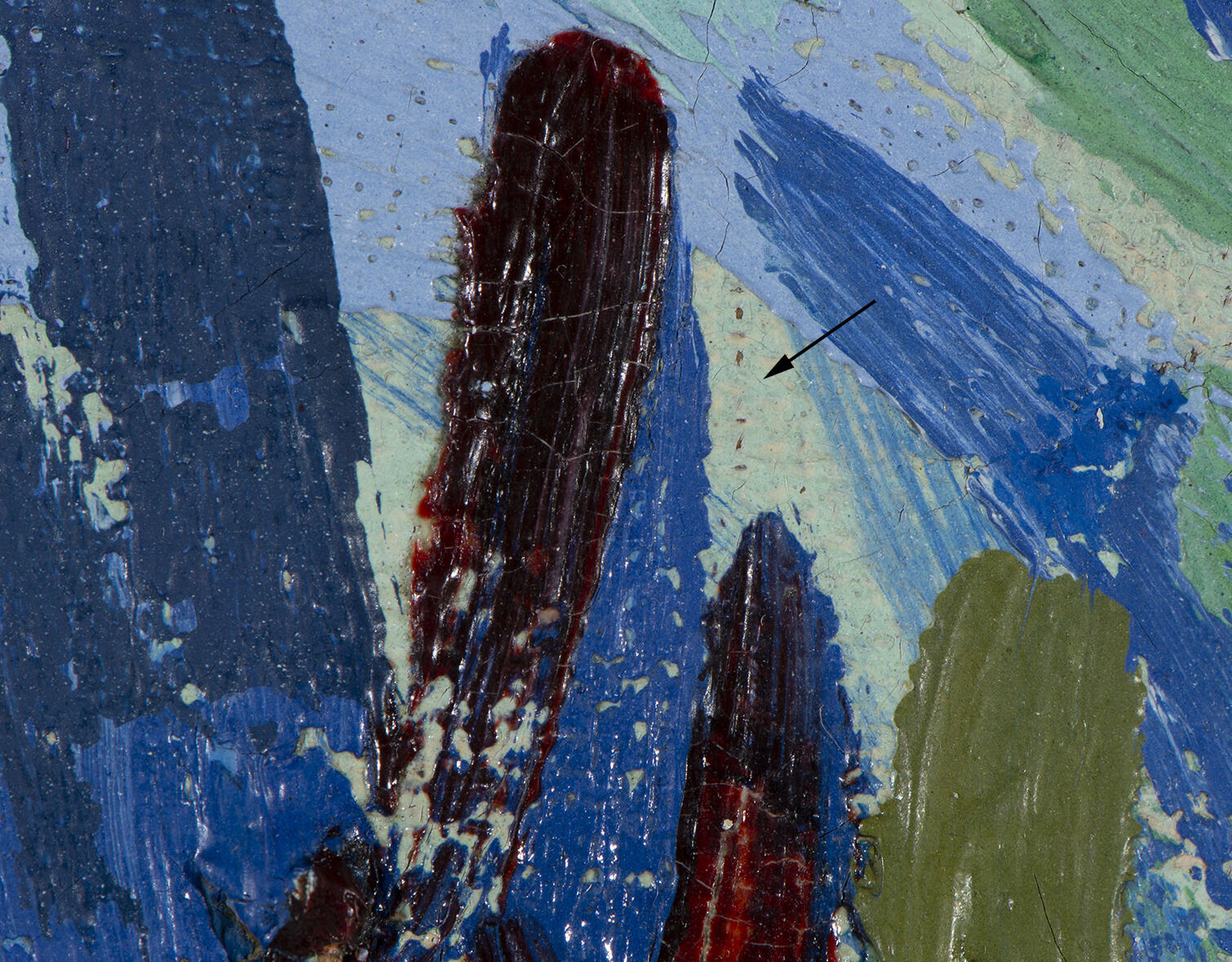 Fig. 5. Detail of pale mint green layer beneath the foliage on the center left, Olive Trees (1889). Courtesy of R. Bruce North.
Fig. 5. Detail of pale mint green layer beneath the foliage on the center left, Olive Trees (1889). Courtesy of R. Bruce North.
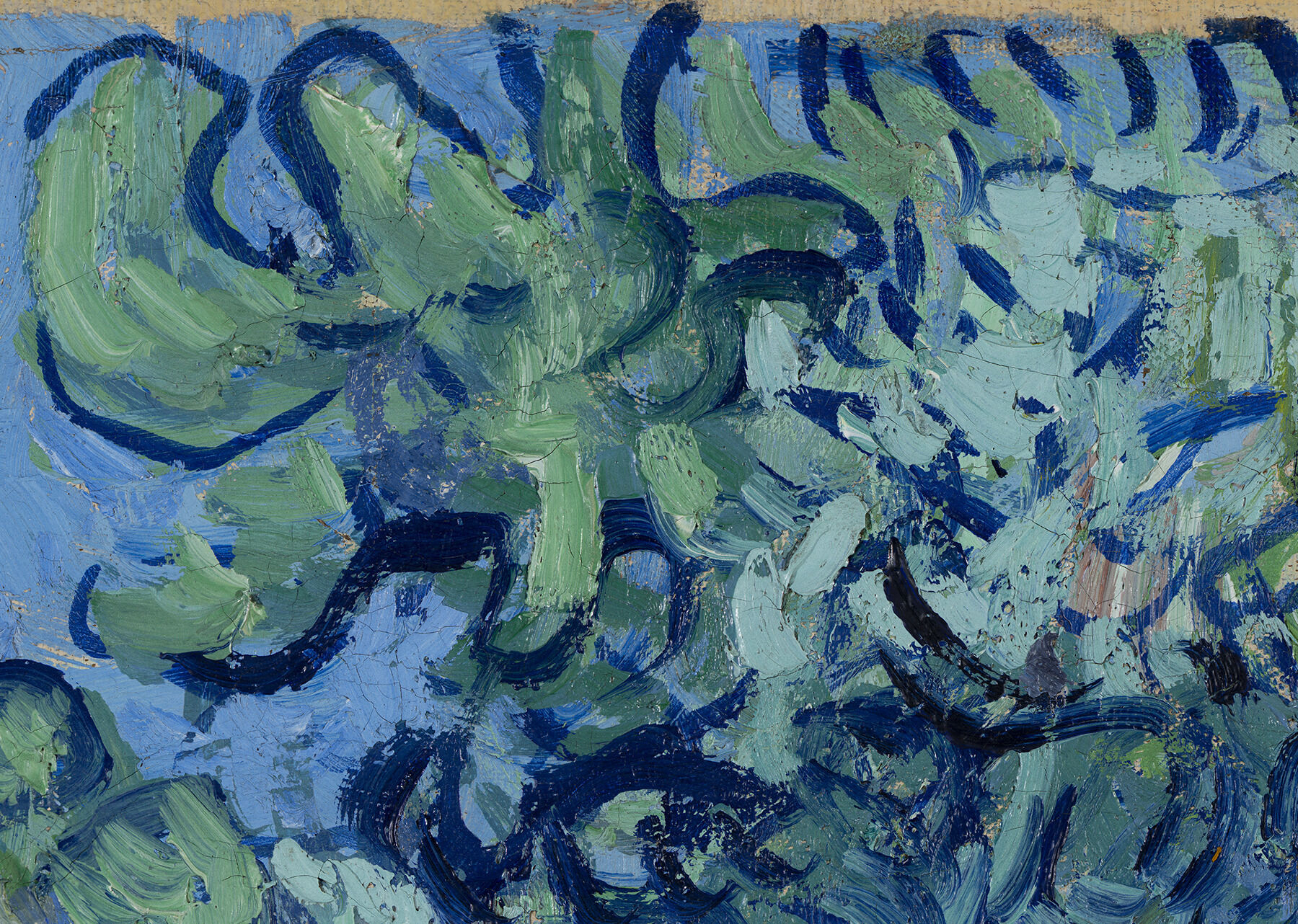 Fig. 6. Detail of blue painted outlines in the upper trees and additions of light blue paint that expand areas of sky, Olive Trees (1889). Courtesy of R. Bruce North.
Fig. 6. Detail of blue painted outlines in the upper trees and additions of light blue paint that expand areas of sky, Olive Trees (1889). Courtesy of R. Bruce North.
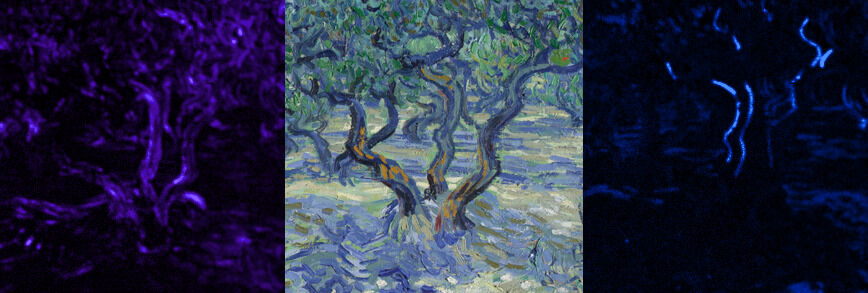 Fig. 7. Element maps for cobalt (left) and iron (right). Detail of the central tree of Olive Trees (center). The elemental maps show the use of cobalt blue to define the central and right tree trunks in the early stages of painting, followed by final outlining strokes of Prussian blue that modify the central trunk.
Fig. 7. Element maps for cobalt (left) and iron (right). Detail of the central tree of Olive Trees (center). The elemental maps show the use of cobalt blue to define the central and right tree trunks in the early stages of painting, followed by final outlining strokes of Prussian blue that modify the central trunk.
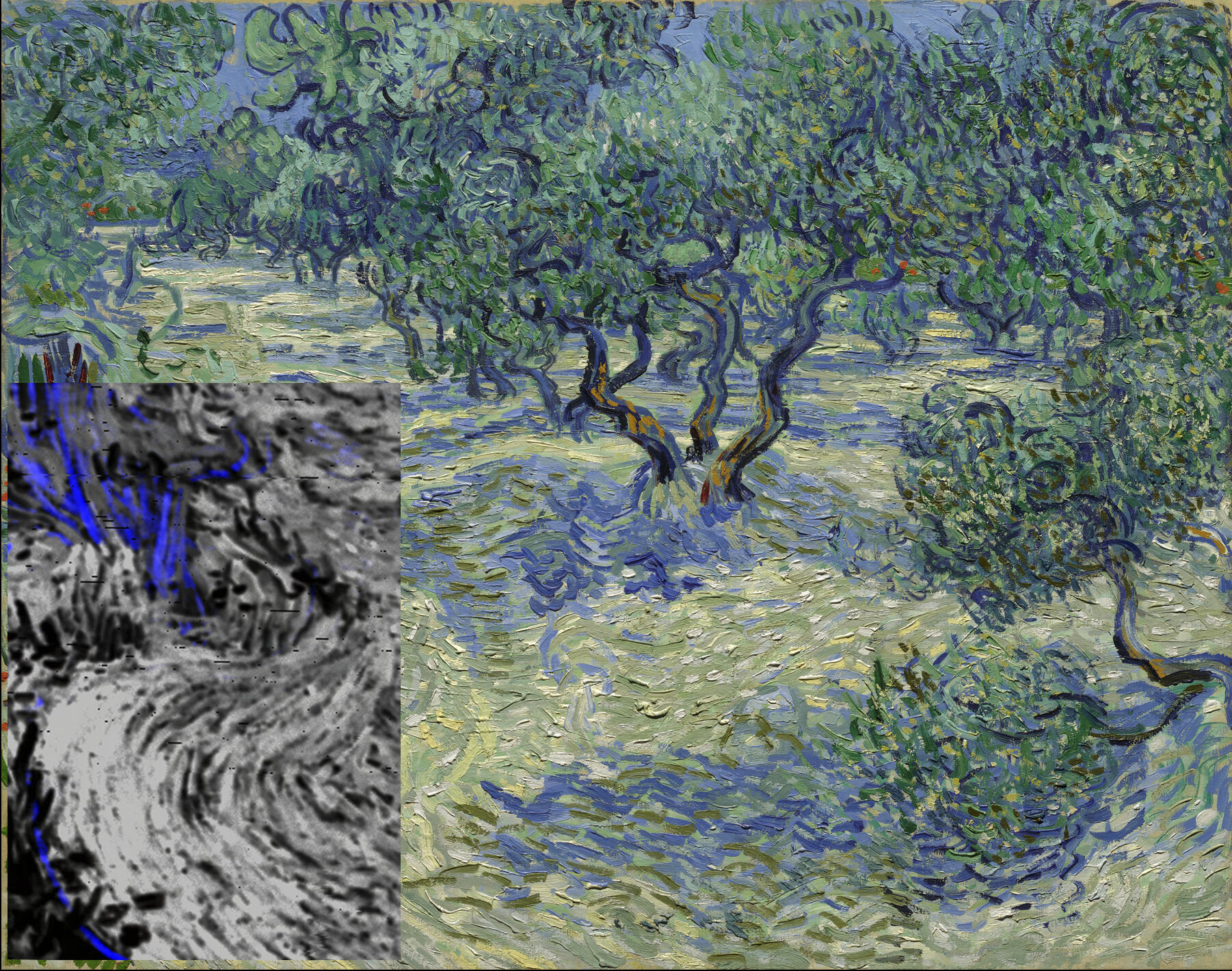 Fig. 8. Element map for cobalt superimposed on that of zinc (lower left), showing the cobalt blue stroke that marks the lower left path
Fig. 8. Element map for cobalt superimposed on that of zinc (lower left), showing the cobalt blue stroke that marks the lower left path
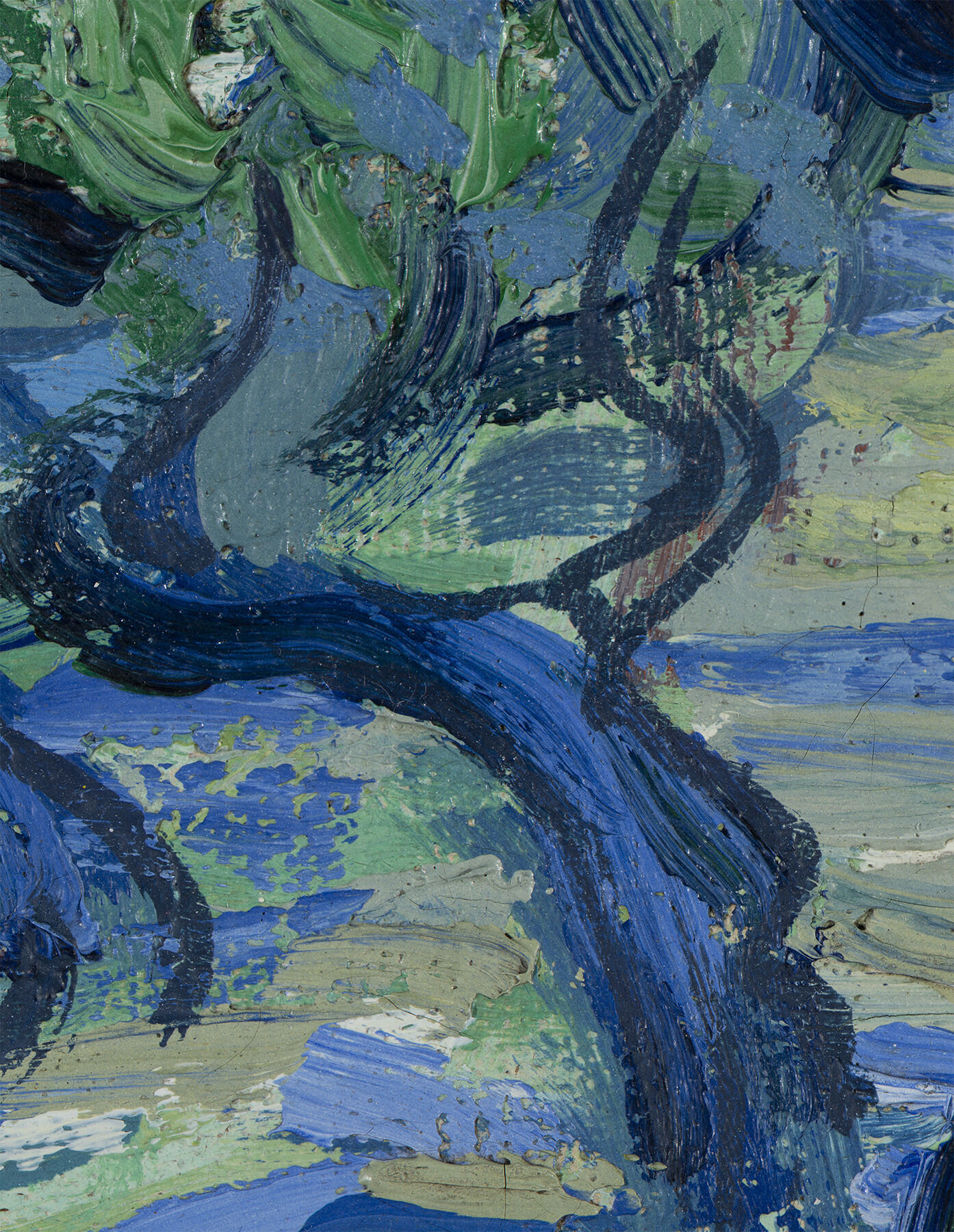 Fig. 9. Detail of a red-violet stroke in the lower layers, visible beneath the blue-gray outline of a distant tree, Olive Trees (1889). Courtesy of R. Bruce North.
Fig. 9. Detail of a red-violet stroke in the lower layers, visible beneath the blue-gray outline of a distant tree, Olive Trees (1889). Courtesy of R. Bruce North.
Above the ground, Van Gogh’s first paint applications included an initial lay-in of color to the foreground and painted lines that position several compositional elements.3No underdrawing was detected using magnified inspection or infrared imaging conducted in the infrared spectrum between wavelengths of 700 – 2200 nanometers. Using thin, pale green paint and loose brushwork, Van Gogh roughly blocked in the lower half of the painting without a reservereserve: An area of the composition left unpainted with the intention of inserting a feature at a later stage in the painting process. for the path, left foliage grouping, or the base of the central trees (Fig. 5). The ground layer remains exposed in the foreground, confirming that this pale green, which varies slightly in color, was not applied as a continuous layer. A number of guiding strokes of fluid, blue paint were used to loosely outline the upper trees. Many of these blue strokes lie on top of light blue sky, indicating that passages of sky were also established in this early stage of painting (Fig. 6). Evidence from XRF elemental mappingX-ray fluorescence spectrometry elemental mapping (MA-XRF) or XRF elemental mapping: A non-destructive technique that entails collecting thousands of X-ray fluorescence spectra at regular intervals across a painting to build an alternate set of images depicting the locations and amounts of different elements. Although the information is fundamentally the same as measurements gathered from a single-point XRF, the graphical nature of the result is often a more powerful technique for understanding trends in an artist’s use of materials. The high number of spectra allows statistical manipulations of the elemental information to locate correlations between different pigments that would not be possible from a small number of tests. For example, the consistent occurrence of mercury along with chromium, and iron along with copper, could show that vermilion was used to mute the chrome green and red ocher was similarly employed in a mixture that includes emerald green. The resulting correlation maps then serve to show where the two cases occur in the composition. MA-XRF can also reveal preliminary paint applications that became covered as the composition was completed, thereby disclosing aspects of the painter’s method. suggests that additional components of the composition, now covered by subsequent paint, were similarly outlined.4X-ray fluorescence spectrometry elemental mapping was undertaken as part of a collaboration with the Laboratory of Molecular and Structural Archaeology, directed by Philippe Walter (CNRS/Pierre and Marie Curie University, Paris) by which their instrument design and operational software was provided to the authors. The centermost trunk of the central olive tree, for instance, was initially painted with two linear strokes of cobalt blue, before Van Gogh transformed the trunk into a more angular, twisting form, with final outlines in Prussian blue (Fig. 7). XRF mapping also confirms that a painted line of cobalt blue marked the sweeping, outer edge of the path at the lower left (Fig. 8). Although the upper half of Olive Trees is more densely covered by overlapping strokes, there are occasional glimpses of underlying paint that range in color from pinkish-gray to brighter red. These paint strokes may relate to early positioning of the upper trees and the base of the central tree (Fig. 9). For example, a forked shape beneath the paint of the distant trees may correspond to a tree trunk that was never fully realized.
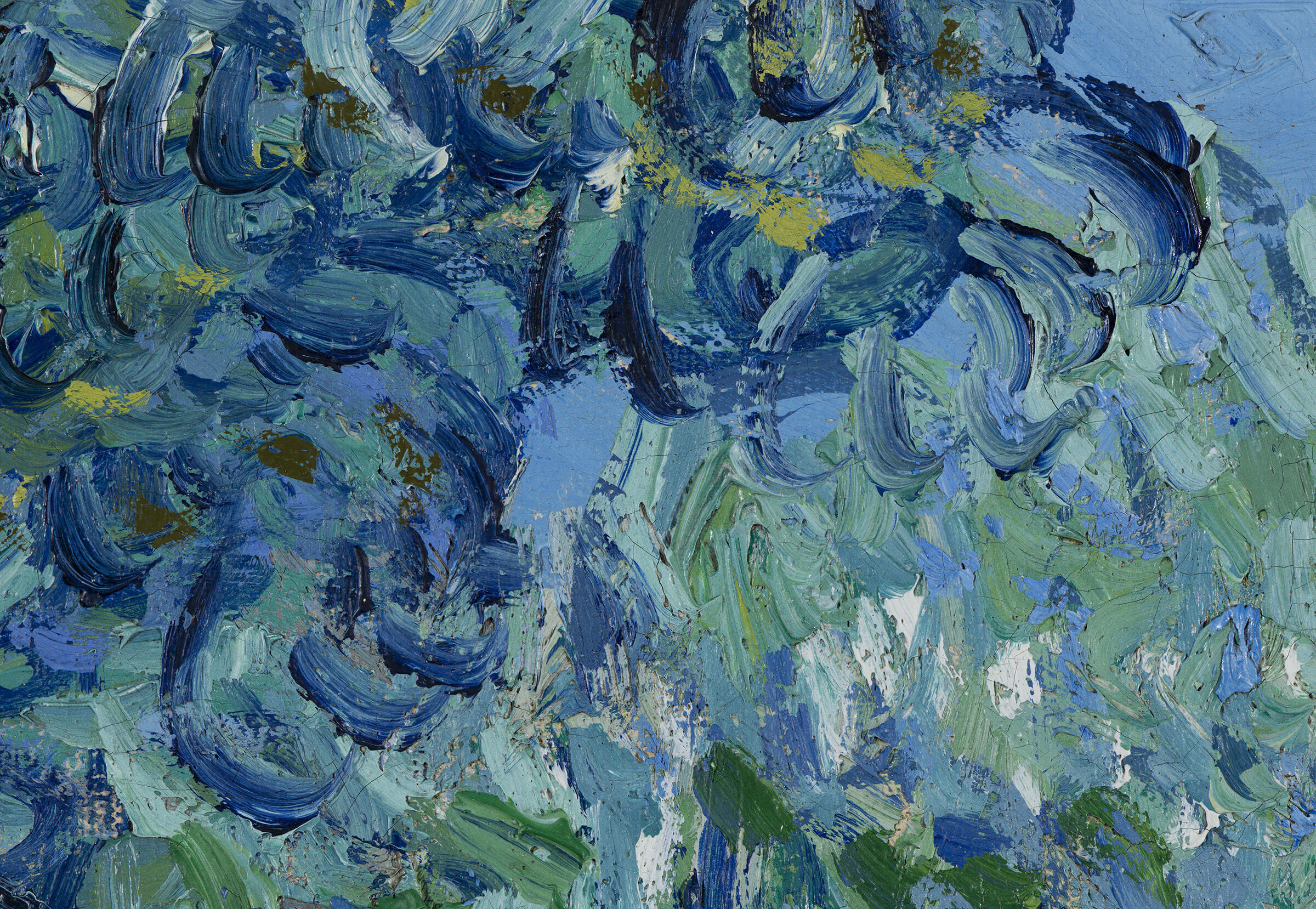 Fig. 10. Detail of the energetic, curving paint strokes that make up the upper trees, Olive Trees (1889)
Fig. 10. Detail of the energetic, curving paint strokes that make up the upper trees, Olive Trees (1889)
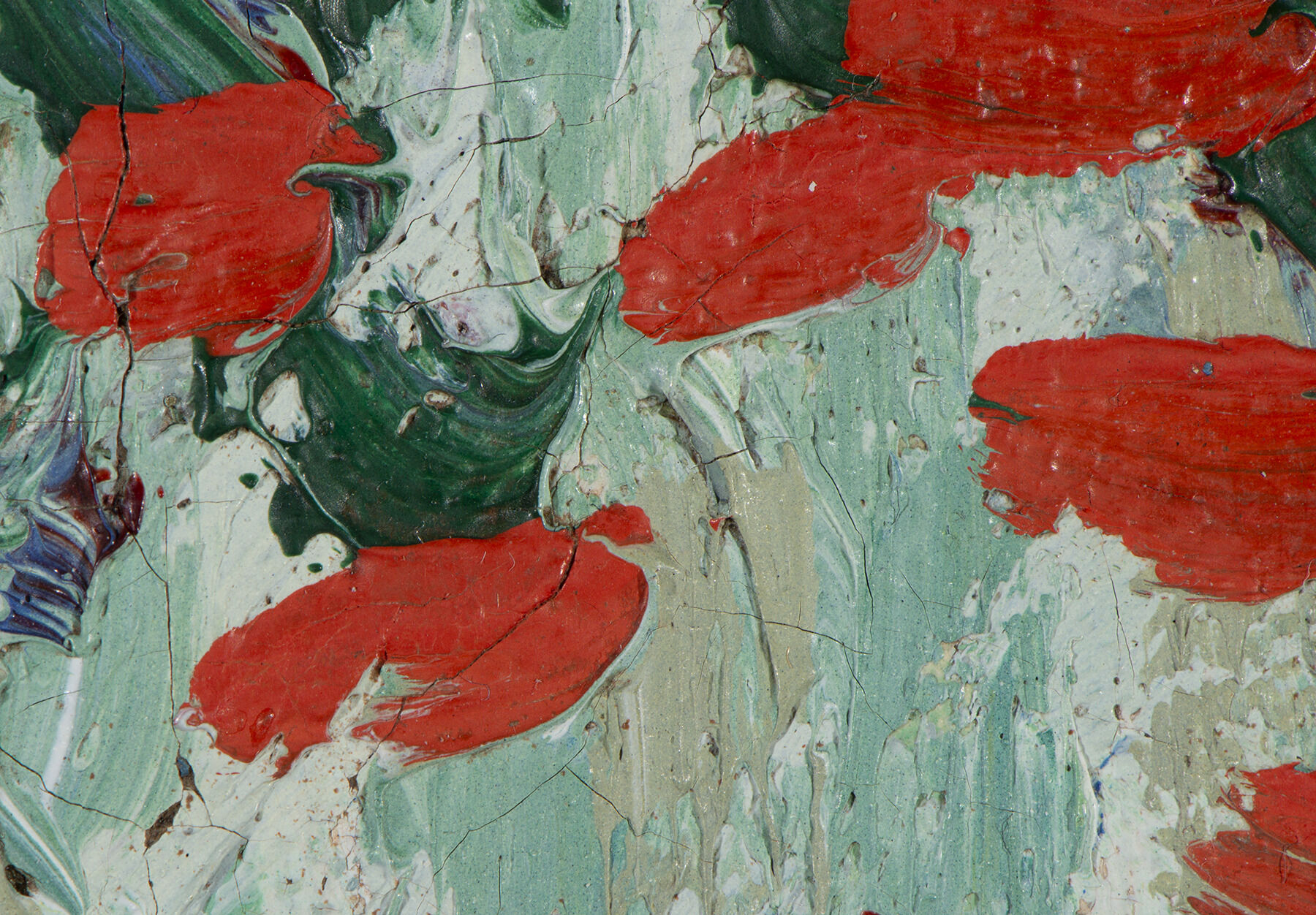 Fig. 11. Detail of wet-over-wet paint applications in the vermilion poppies at the left edge of Olive Trees (1889). Courtesy of R. Bruce North.
Fig. 11. Detail of wet-over-wet paint applications in the vermilion poppies at the left edge of Olive Trees (1889). Courtesy of R. Bruce North.
Using loose, painterly brushwork and thick, viscous paint, Van Gogh produced a lively, tactile surface in his representation of the olive grove (Fig. 10). Wet-over-wetwet-over-wet: An oil painting technique which involves drawing a stroke of one color across the wet paint of another color. paint applications are evident throughout the landscape (Fig. 11). While there is intermingling of colors that occurred during their separate applications to the canvas, there are also paint mixtures that were incompletely blended on the palette prior to being applied on the canvas together. The foreground was constructed using somewhat linear, directional strokes whose angles create movement and depict an undulating terrain. The winding path at lower left is indicated similarly. The viewer’s eye is drawn forward along the path and deeper into the trees by their trajectories, creating a sense of perspective in the absence of straight lines or planes. Short, horizontal strokes in the middle distance produce the alternating patches of sunlight and shadow that lie across the ground. The upper trees consist of long, curving strokes, often applied in groupings of a single color (Fig. 10). Dark blue painted outlines, a mixture of ultramarine and Prussian blue, appear to have been added to reinstate definition that had become less distinct over the course of painting (Fig. 6). Collectively, the extensive wet-over-wet brushwork and the presence of debris lodged in the paint indicate that Olive Trees was, at least initially, painted en plein airen plein air (adjective: plein-air): French for “outdoors.” The term is used to describe the act of painting quickly outside rather than in a studio.. Plant material encased in paint is evident in several locations (Fig. 12), and a tiny grasshopper is visible on the lower foreground with the aid of magnification (Fig. 13).5The authors are grateful to paleo-entomologist, Dr. Michael S. Engel, senior curator and university distinguished professor, University of Kansas, and associate, American Museum of Natural History, NY. Dr. Engel determined that the disarticulated body fragments (head and hind leg) lodged in the wet paint of Olive Trees point to an already dead nymph or a shed exuvium. This fact prohibited the use of the annual seasonal cycle of grasshoppers in the region during 1889 to gain more specificity as to the months in which Van Gogh completed the landscape.
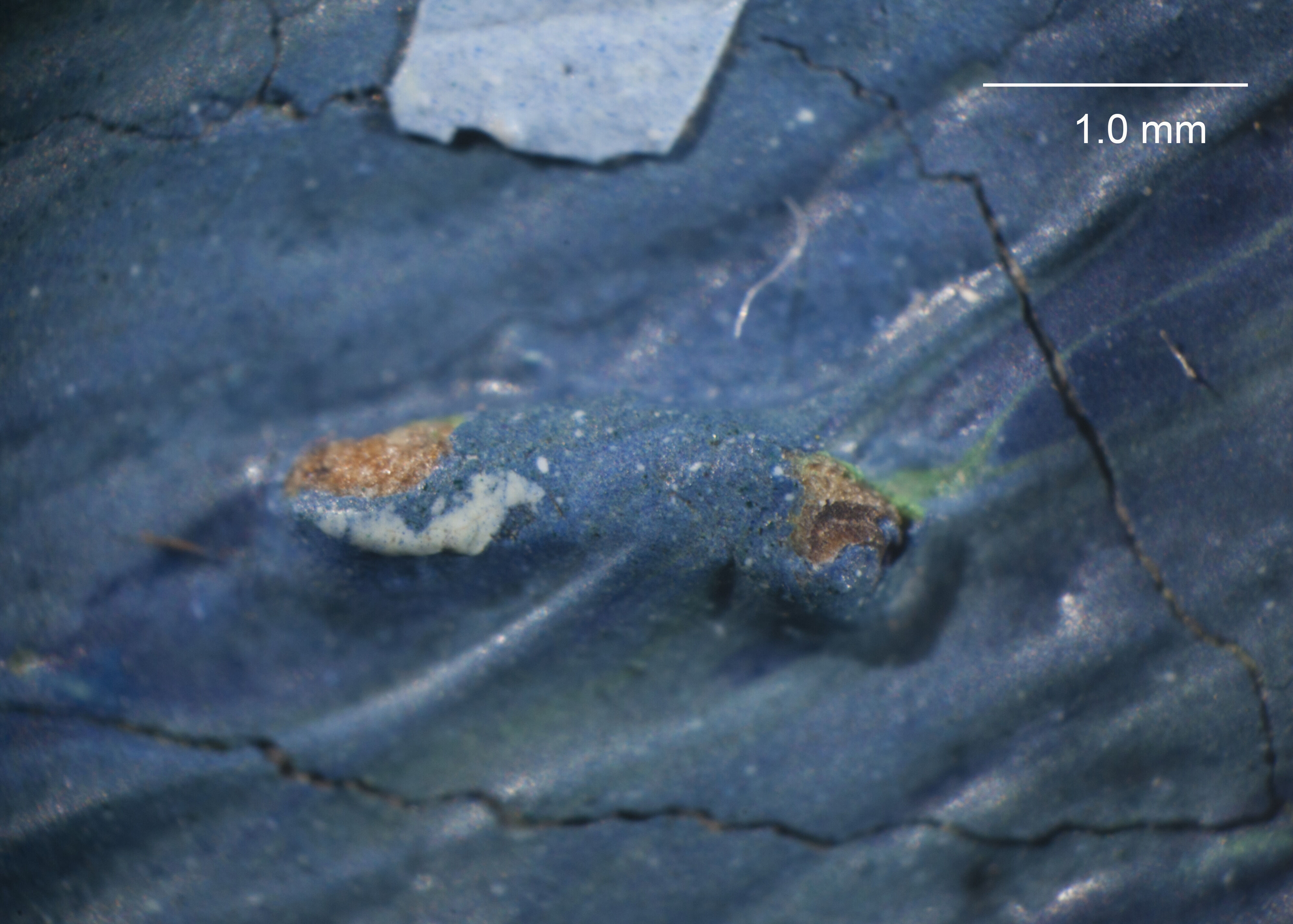 Fig. 12. Photomicrograph of plant material encased in paint, Olive Trees (1889)
Fig. 12. Photomicrograph of plant material encased in paint, Olive Trees (1889)
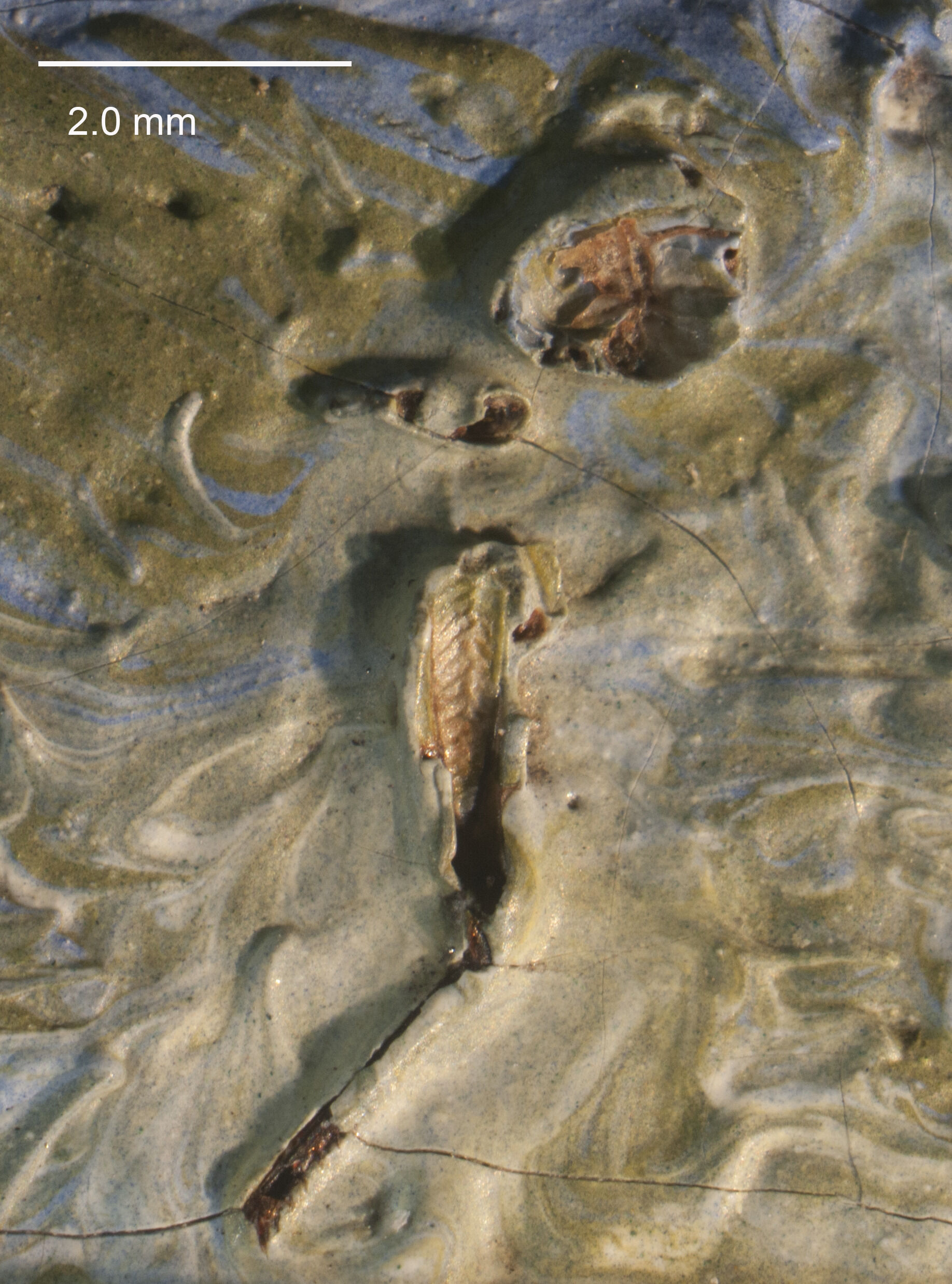 Fig. 13. Photomicrograph of a grasshopper embedded in the paint of the foreground, Olive Trees (1889)
Fig. 13. Photomicrograph of a grasshopper embedded in the paint of the foreground, Olive Trees (1889)
Over the course of painting,
Van Gogh made several modifications to the composition. He applied light blue paint
on top of existing trees to add or expand areas of the sky, and the width of the
lower right tree was cropped on its left side. Distant trees, located near the
left horizon line and continuing toward the central trees, were reinforced and
adjusted with gray-blue outlines, applied wet-over-drywet-over-dry: An oil painting technique that involves layering paint over an already dried layer, resulting in no intermixing of paint or disruption to the lower paint strokes. (Fig. 9).
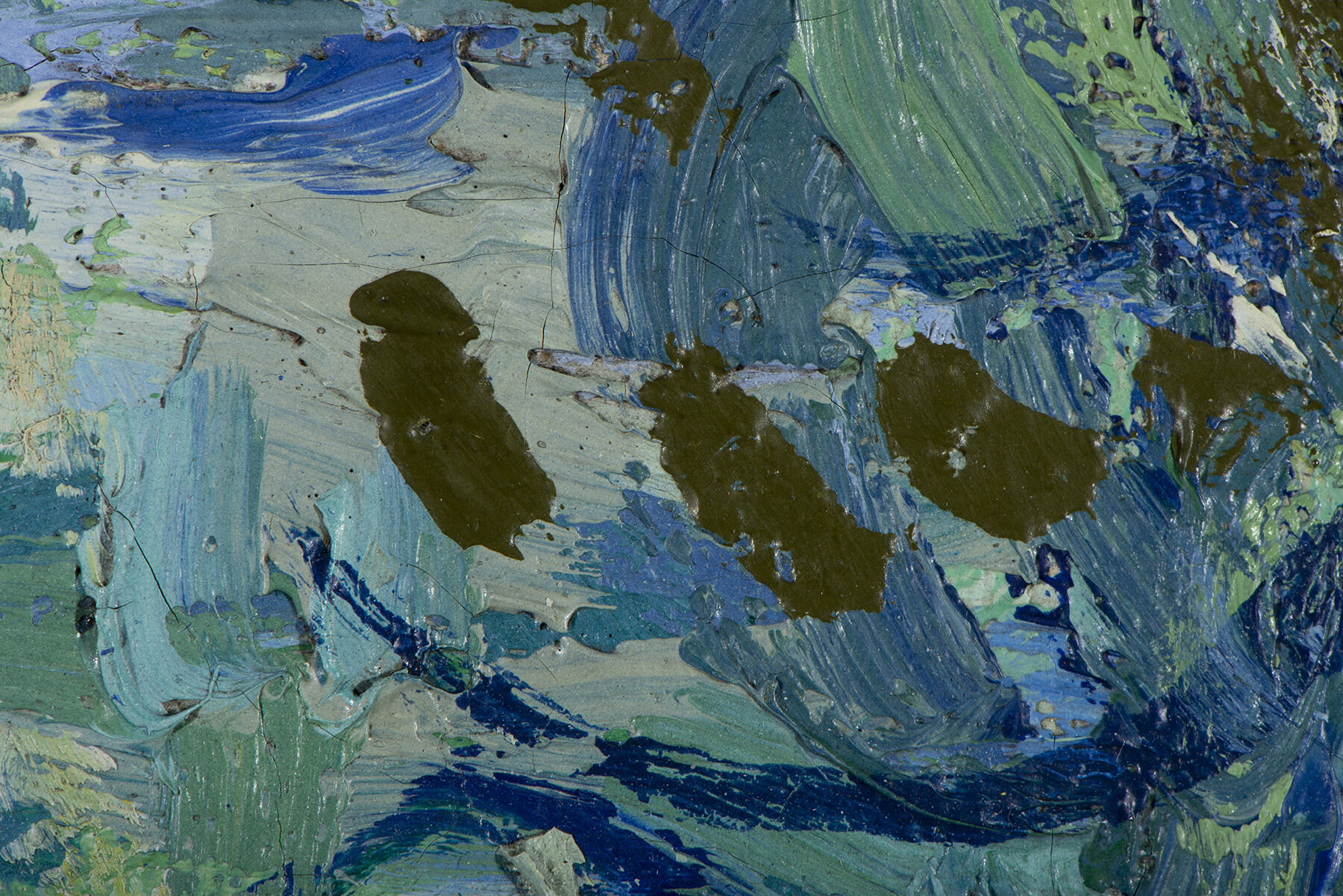 Fig. 14. Detail of dark olive green, applied wet-over-dry, in the second phase of painting, Olive Trees (1889). Courtesy of R. Bruce North.
Fig. 14. Detail of dark olive green, applied wet-over-dry, in the second phase of painting, Olive Trees (1889). Courtesy of R. Bruce North.
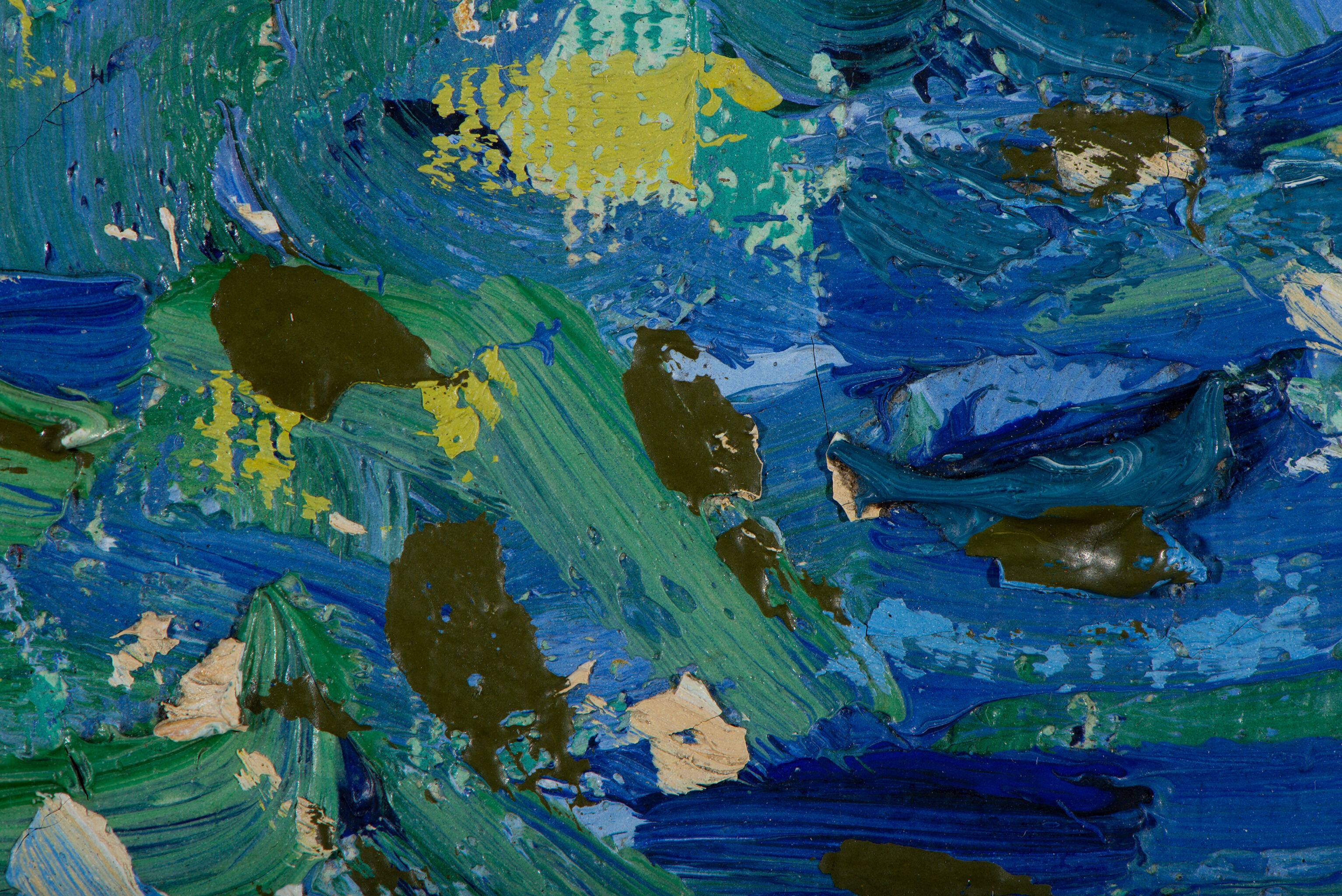 Fig. 15. Detail of numerous paint losses among the right trees, Olive Trees (1889). Courtesy of R. Bruce North.
Fig. 15. Detail of numerous paint losses among the right trees, Olive Trees (1889). Courtesy of R. Bruce North.
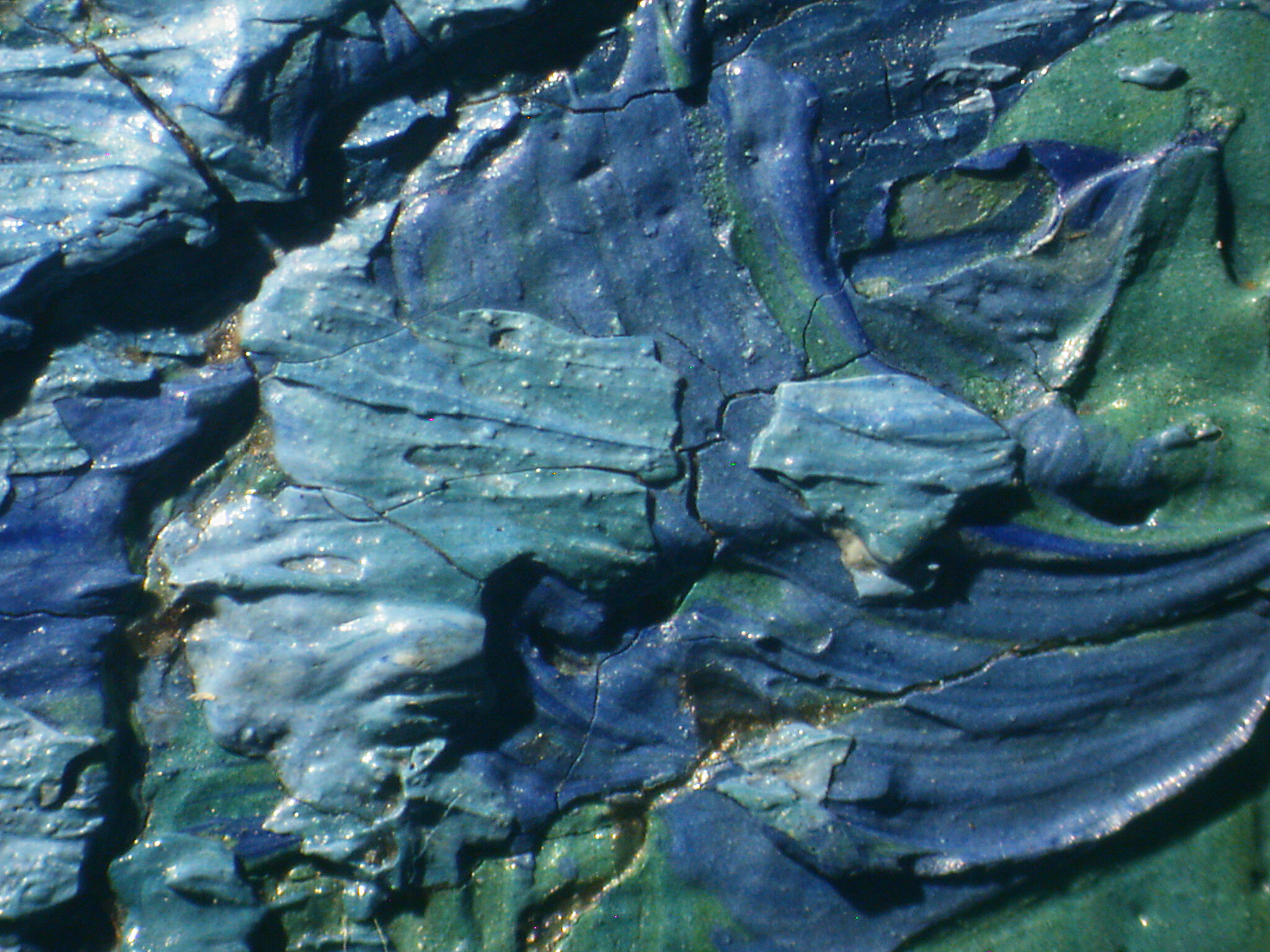 Fig. 16. Photomicrograph of a paint loss and the gritty appearance of the second phase paint, Olive Trees (1889), 6x
Fig. 16. Photomicrograph of a paint loss and the gritty appearance of the second phase paint, Olive Trees (1889), 6x
Other significant artist changes occurred during a later stage of painting. Although Van Gogh began this landscape in June of 1889,6See the accompanying catalogue essay by Aimee Marcereau DeGalan. the presence of numerous wet-over-dry additions, paint losses, and a stylistic shift in Van Gogh’s brushwork suggest that Olive Trees was painted in two distinct sessions and completed in the fall.7The findings presented include those from an earlier 2012 study with curatorial contributions by Nicole R. Myers, former associate curator, European paintings and sculpture, The Nelson-Atkins Museum of Art. These later additions had no effect on the impastoimpasto: A thick application of paint, often creating texture such as peaks and ridges. of the earlier paint strokes, indicating that the paint surface was solidly dry by the time Van Gogh returned to the canvas (Fig. 14). Poor adhesion between the first and second phase paint is also prevalent (Fig. 15), resulting in losses which expose underlying paint colors. Light-colored mixtures associated with the second phase paint are also characterized by a gritty texture (Fig. 16).8The underlying cause of this granular appearance has not been definitively identified. This distinctive texture is most prevalent among the lighter paint mixtures, and although zinc-fatty acid soap formations are widespread within the paints of both phases, the formations do not protrude through or disrupt the paint surface in those locations where they have been found inside samples. Zinc-fatty acid soaps, formed by reactions between zinc white and free fatty acids present in the oil paint, have been widely cited as a cause of adhesion loss between successive applications of oil paints based on zinc white, as in the case of Olive Trees. Crystalline zinc soaps have been found at the interface between the delaminating paint layers in various paintings based on zinc white. See for example L. Raven, M. Bisschoff, M. Leeuwestein, M. Geldof, J.J. Hermans, M. Stols-Witlox, and K. Keune, “Delamination Due to Zinc Soap Formation in an Oil Painting by Piet Mondrian (1872–1944): Conservation Issues and Possible Implications for Treatment,” in Metal Soaps in Art: Conservation and Research, ed. F. Casadio, K. Keune, P. Noble, A. Van Loon, E. Hendriks, S.A. Centeno, and G. Osmond (Springer Cultural Heritage Science Series, 2019), 343–58. While second phase painting in the foreground introduced additions of white, pale blue, yellow, and dark teal, there is no noticeable shift in brushwork from one phase to the next. In the trees, however, Van Gogh disrupted the long curving strokes with later dabs or dashes of paint, a manner of painting that resembles the tighter brushwork and smaller dabs of paint found among his later olive tree paintings produced in the fall of 1889 (Fig. 17).
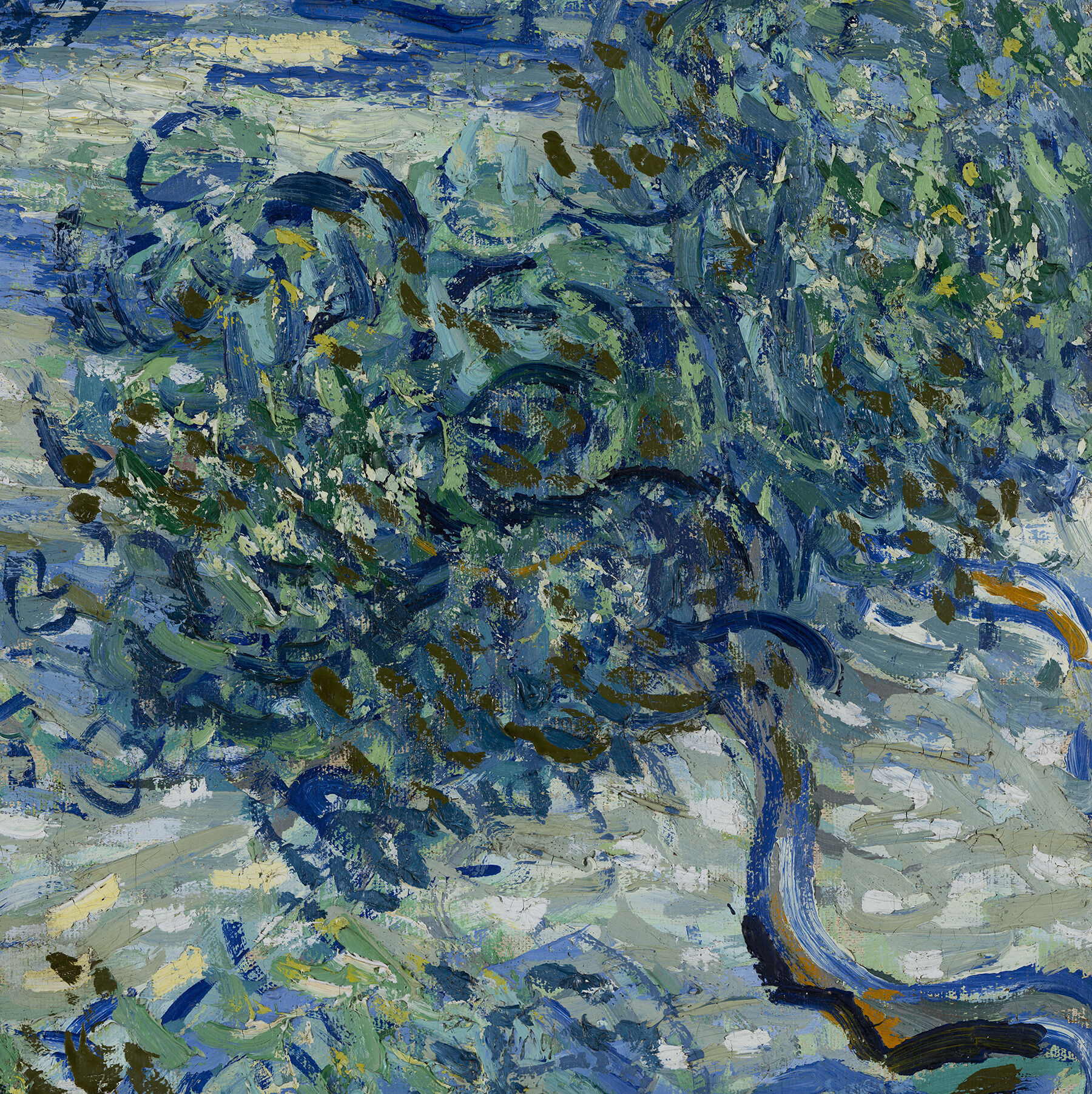 Fig. 17. Detail of the lower right tree, showing the dabs of paint added in the second phase of painting, Olive Trees (1889). Courtesy of R. Bruce North.
Fig. 17. Detail of the lower right tree, showing the dabs of paint added in the second phase of painting, Olive Trees (1889). Courtesy of R. Bruce North.
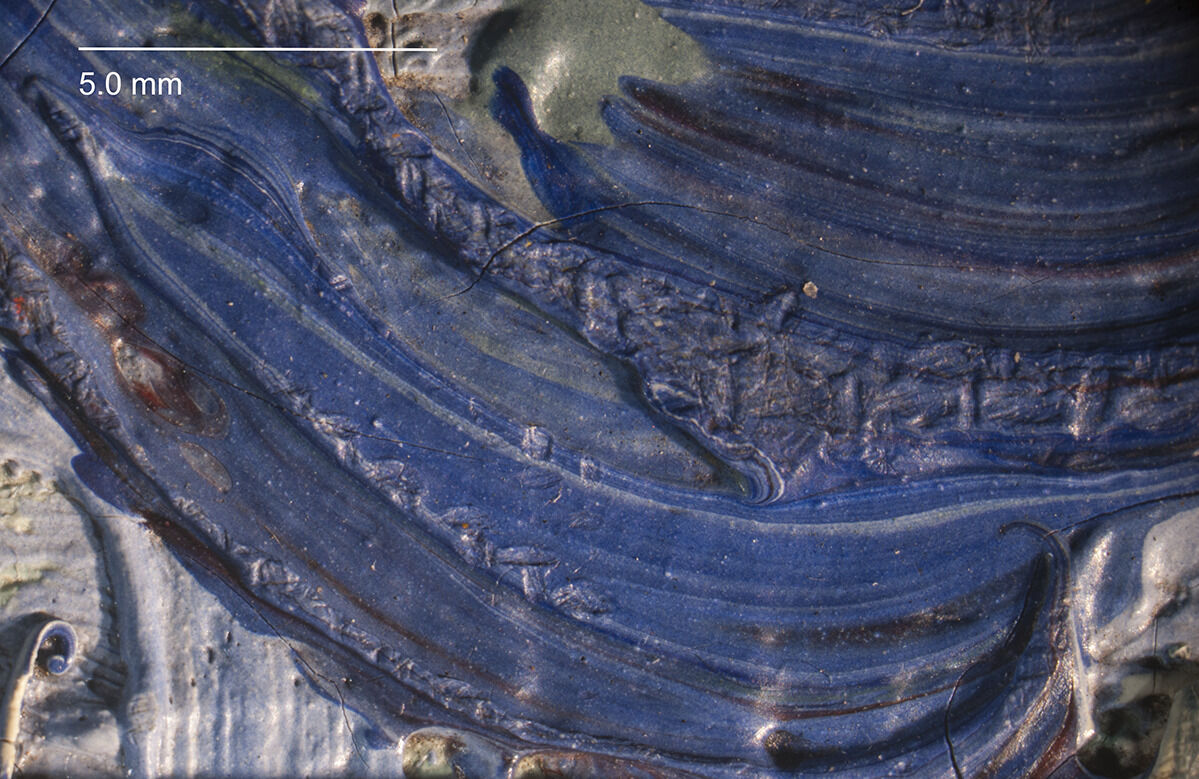 Fig. 18. Photomicrograph of a weave impression made in the first phase paint, located in the shadow of the central tree, Olive Trees (1889)
Fig. 18. Photomicrograph of a weave impression made in the first phase paint, located in the shadow of the central tree, Olive Trees (1889)
Several canvas weave impressions in the impasto indicate that the painting was rolled or stacked with other works before its surface was fully dry (Fig. 18). These impressions seem to occur exclusively in the first phase paint, reinforcing the observation that Van Gogh set Olive Trees aside and resumed painting at a later date. The evidence of two painting phases strengthens the possibility that the Nelson-Atkins painting was shipped with a later consignment of canvases sent to Theo van Gogh in September of 1889.9Vincent van Gogh to Theo van Gogh, September 28, 1889, in Van Gogh Museum, Amsterdam, no. b656 V/1962; published in Leo Jansen, Hans Luijten, and Nienke Bakker, eds., Vincent van Gogh: The Letters (Amsterdam and The Hague: Van Gogh Museum and Huygens, 2009), no. 806, http://www.vangoghletters.org/vg/letters/let806/letter.html. All English translations are from this publication. In footnote 8, the Nelson-Atkins painting is suggested to be the olive grove described in relation to this shipment.,10A collaborative research project, led by the Dallas Art Museum and Van Gogh Museum, to study all fifteen paintings that comprise the olive tree series is underway and may clarify the chronology and shipment dates of the entire series. Nienke Bakker and Nicole R. Myers, eds., Van Gogh and the Olive Groves (Dallas: Dallas Museum of Art; Amsterdam: Van Gogh Museum, forthcoming).
Van Gogh’s palette for Olive Trees included geranium lake,11“Lake” pigment is produced by the combination of a soluble dye color with a soluble, usually colorless inorganic compound to produce a colored precipitate that can be handled like a dry pigment and thereafter combined with oil. In some cases, the precipitation was carried out in the presence of a colored carrier so that the dye precipitate coats a particle of another pigment. In 1889 eosin lakes of several varieties were available, including some that were precipitated on red lead for their combined color. However, Van Gogh employed the “geranium” lake whose color was solely that of its eosin content. Eosin was synthesized in 1871. See M.J. Depierre, “Note on the Application of Eosin,” American Chemist 6–7 (New York: C.F. & W. H. Chandler, 1875), 217. red lead oxide, vermilion, chrome yellow and chrome orange, viridian (hydrated chrome oxide), emerald green (copper acetoarsenite), synthetic ultramarine, cobalt blue, Prussian blue, and zinc white (see Table 1). Although his paint mixtures for works in the olive trees series incorporated both zinc white and lead white,12Kathryn A. Dooley, Annalisa Chieli, Aldo Romani, Stijn Legrand, Costanza Miliani, Koen Janssens, and John K. Delaney, “Molecular Fluorescence Imaging Spectroscopy for Mapping Low Concentrations of Red Lake Pigments: Van Gogh’s Painting The Olive Orchard,” Angewandte Chemie 59, no. 15 (April 6, 2020): 6046–53. he used zinc white almost exclusively in this case. Lead white occurrences are so finely dispersed as to suggest that it was a manufacturer’s additive in some of the tube colors, probably to enhance the drying of the oils with slow drying pigments, such as ultramarine. Calcite, gypsum, and white clay also occur as additives rather than primary white pigments. Charcoal is used very sparingly in drab greens. Several other pigments are notable for their absence. For example, cadmium yellow was not used, and yellow ocher is encountered only in very dilute yellow mixtures. Red lakes involving alizarin or carmine that he used in other works of the period were omitted.13Dooley et al., “Molecular Fluorescence Imaging Spectroscopy,” 6050. Tin and calcium associated with these lakes were not associated with the red lake in the Nelson-Atkins Olive Trees.
In addition to producing violet colors, geranium lake was added to blue-green mixtures to render them nearly black. However, it was not the sole means of producing violet shades in a painting that employed no violet pigments. Red lead, used sparingly in the painting, was mixed to produce dull violet and gray-violet shades that have not faded like those formulated with geranium lake. Often the red lead occurs in the tree trunks in combination with Prussian blue, a mixture that appears flatter, and more opaque, than the mixtures incorporating geranium lake with ultramarine or cobalt blue.
XRF mapping of individual elements offers insights into Van Gogh’s use of mixtures but often must be supplemented by other techniques such as scanning electron microscopy (SEM)scanning electron microscopy (SEM): Performed on a microsample of paint, the SEM provides a means of studying particle shapes beyond the magnification limits of the light microscope. This becomes increasingly important with the painting materials introduced in the early modern era, which are finer and more diverse than traditional artists’ materials. The SEM is routinely used in conjunction with an X-ray spectrometer, so that elemental identifications can be made selectively on the same minute scale as the electron beam producing the images. SEM methods are particularly valuable in studying unstable pigments, adverse interactions between incompatible pigments, and interactions between pigments and surrounding paint medium, all of which can have profound effects on the appearance of a painting., Raman spectroscopyRaman spectroscopy: A microanalytical technique applicable primarily to pigments and minerals, differentiating them based on both chemical bonding and crystal structure, often with extremely high sensitivity for individual particles. For example, traditional indigo and synthetic phthalocyanine blue are both carbon compounds not well differentiated by other methods utilized here, especially when used dilutely. However, they give unique Raman spectra. Calcium carbonates derived from chalk or pulverized oyster shell of identical chemical compositions can be differentiated based on their crystal structures (calcite and aragonite, respectively)., Fourier-transform infrared spectroscopy (FTIR)Fourier-transform infrared spectroscopy (FTIR): A broadly applicable microanalysis method for the identification of paint media classes such as oils, polysaccharides (gum arabic, etc.), proteins (glue and casein tempera), waxes (medium additions and restoration treatments), resins (varnish components), and synthetic media (restoration acrylics). FTIR is also very important for identifying pigments and fillers, and for differentiating closely-related compounds (e.g. neutral and basic lead carbonates, both of which may be found in lead white)., and polarized light microscopy (PLM)polarized light microscopy (PLM): A method used for the study and differentiation of pigments based on the optical properties of individual particles, including color, refractive index, birefringence, etc. PLM is particularly useful in identifying the presence of organic pigments such as indigo and Prussian blue, which often cannot be differentiated from paint medium in the scanning electron microscopy (SEM); differentiating synthetic pigments from their natural analogs by particle shape or the presence of extraneous mineral matter; and disclosing the presence of pigments with similar composition but differing color, such as red and yellow iron oxides. to differentiate pigments that either share the same elements or are not detectable by XRF mapping (see Table 1). Chromium is present in both chrome yellow and viridian, for example, and a lead response can originate from red lead, lead white, or chrome yellow. Ultramarine, a very important blue within the landscape, has no heavy elements and cannot be mapped under these conditions. PLM was particularly important in locating unfaded remnants of geranium lake.
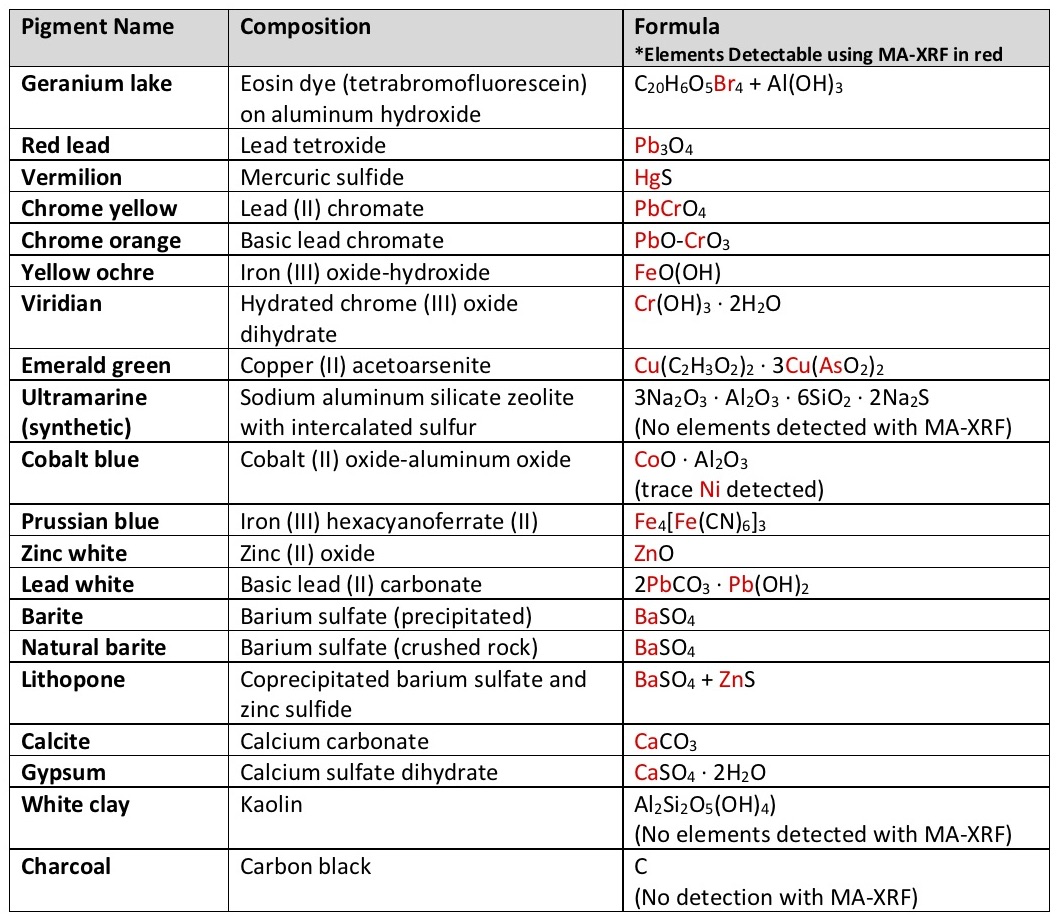
XRF mapping demonstrates that viridian and emerald green were seldom combined in the strongest greens, with most foliage being depicted by clusters of strokes based upon either one or the other (Fig. 19). Another important finding is that greens in Olive Trees were seldom formulated from yellow-blue mixtures. Only drab olive greens were based upon mixtures of chrome yellow and ultramarine (with charcoal and red lead). Because zinc white was used for the principal white pigment rather than lead white, the distribution of lead in the paint correlates most often to chrome yellow. The lead map, therefore, helps to differentiate those greens that were modified by blending chrome yellow with viridian from those in which the chromium was introduced solely with viridian.
 Fig. 19. Element map for copper (left) and chromium (right). Differences in how Van Gogh employed emerald green (copper map) and viridian (chromium map) are evident by comparison with the green paint strokes in the painting.
Fig. 19. Element map for copper (left) and chromium (right). Differences in how Van Gogh employed emerald green (copper map) and viridian (chromium map) are evident by comparison with the green paint strokes in the painting.
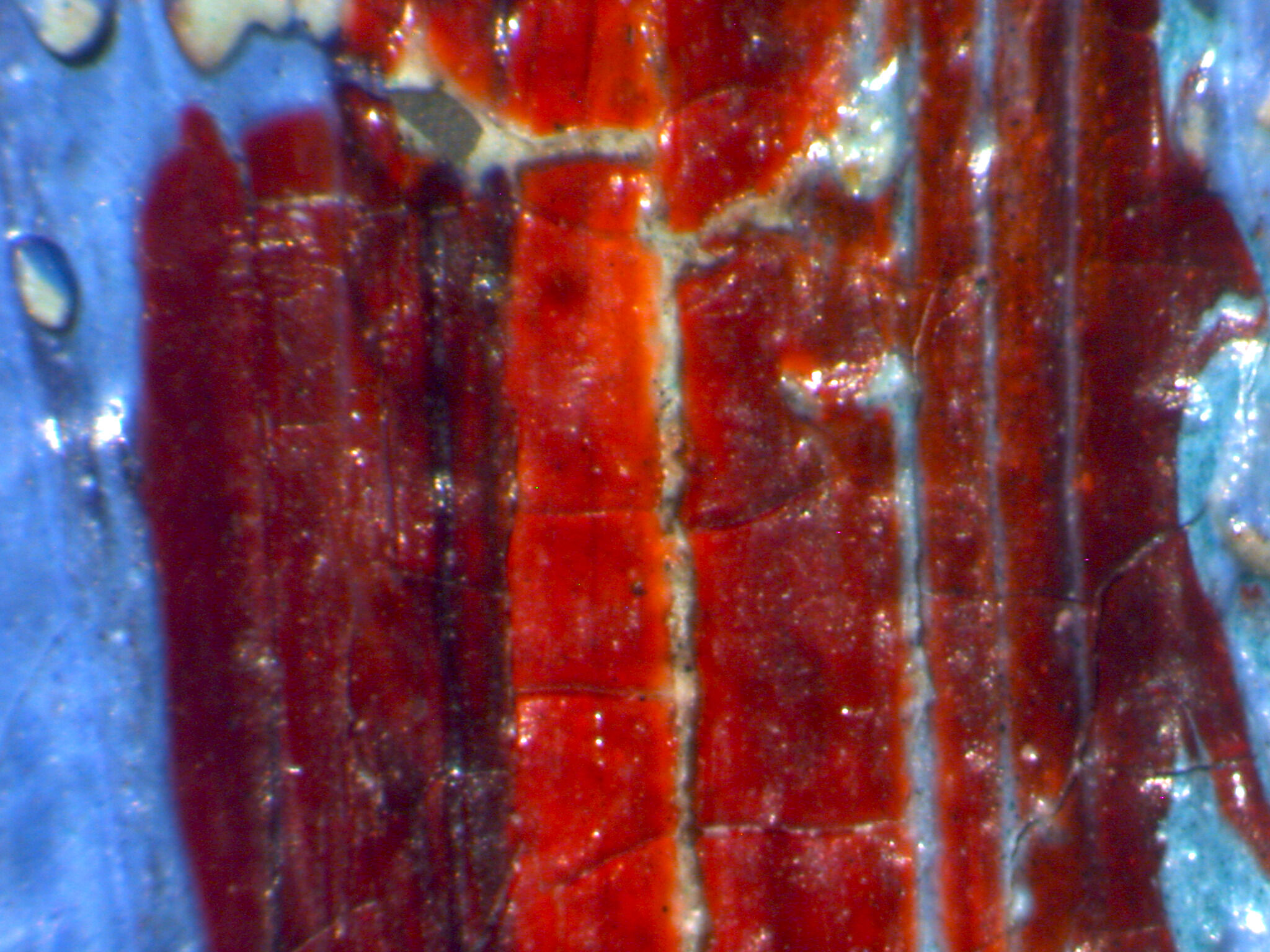 Fig. 20. Photomicrograph of a vertical red stroke of pure geranium lake, Olive Trees (1889), 18x
Fig. 20. Photomicrograph of a vertical red stroke of pure geranium lake, Olive Trees (1889), 18x
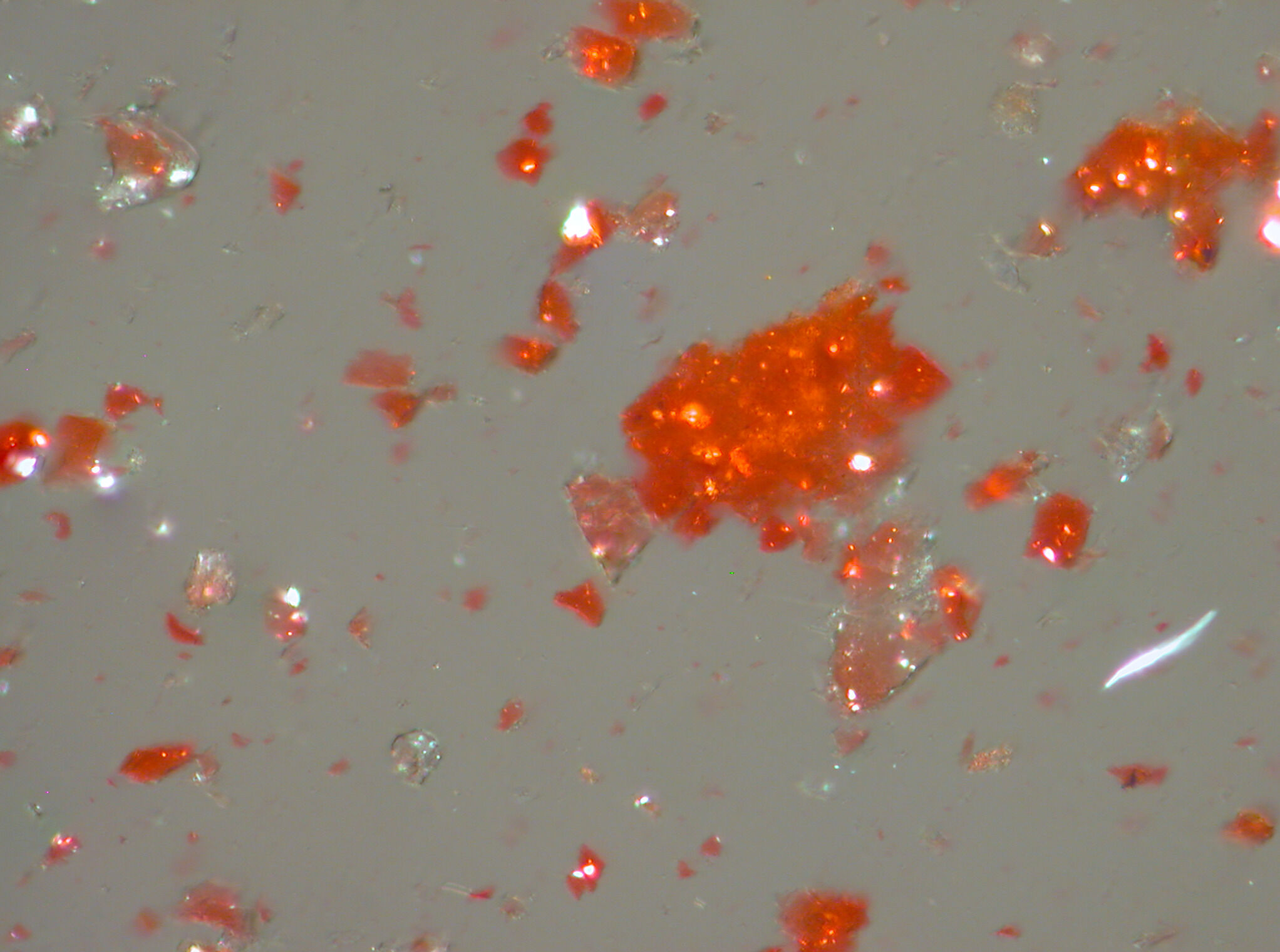 Fig. 21. Dispersed geranium lake with minor lead white additions, transmitted light with crossed polars, 200x
Fig. 21. Dispersed geranium lake with minor lead white additions, transmitted light with crossed polars, 200x
Geranium lake became a component of Van Gogh’s palette following his arrival in Arles in 1888, and the importance of this brilliant red cannot be overstated.14Muriel Geldof, Matthijs de Keijzer, Maarten van Bommel, Kathrin Pilz, Johanna Salvant, Henk van Keulen, and Luc Megens, “Van Gogh’s Geranium Lake,” in Van Gogh’s Studio Practice, ed. Marije Vellekoop, Muriel Geldof, Ella Hendriks, Leo Jansen, and Alberto de Tagle (Brussels: Mercatorfonds, 2013), 285–86. On the Nelson-Atkins painting, geranium lake, formulated with alum, was used in its pure form to depict a few flowers, vertical shoots (Figs. 20, 21), and accents on the trunks of the central tree. The red lake is also visible where it was incompletely mixed with other colors, such as the medium blue paint in the shadows below the central tree (Fig. 22). Pigment microscopy, however, has shown that where Van Gogh used geranium lake in mixtures, it has faded nearly completely due to light exposure, resulting in present-day colors that differ substantially from the artist’s intentions (Figs. 23-25).15All references to specific pigments are based on identification from samples that were examined in the scanning electron microscope, supported with elemental analysis by X-ray spectrometry. Polarized light microscopy was used to screen for compounds not responsive to other tests and to correlate colors to the proportions of mixtures. Confirmatory pigment identifications were carried out with Raman spectroscopy and Fourier transform infrared spectroscopy. They are now dominated by the more stable pigments in the mixture whose colors the geranium lake once modified.
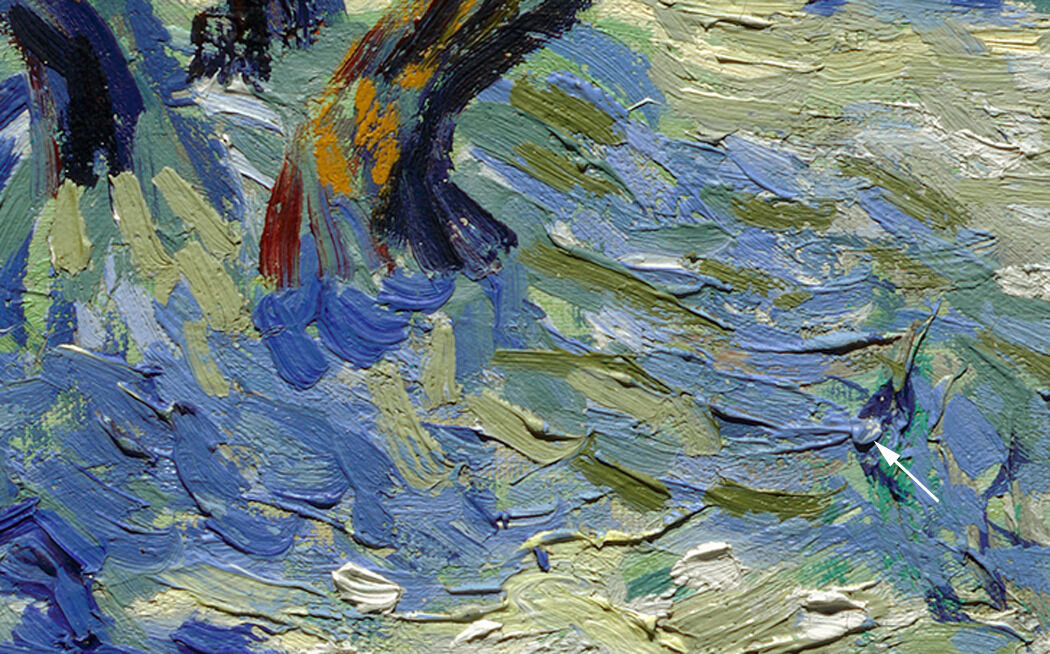 Fig. 22. Detail of blue paint in the shadow to the right of the central tree, Olive Trees (1889)
Fig. 22. Detail of blue paint in the shadow to the right of the central tree, Olive Trees (1889)
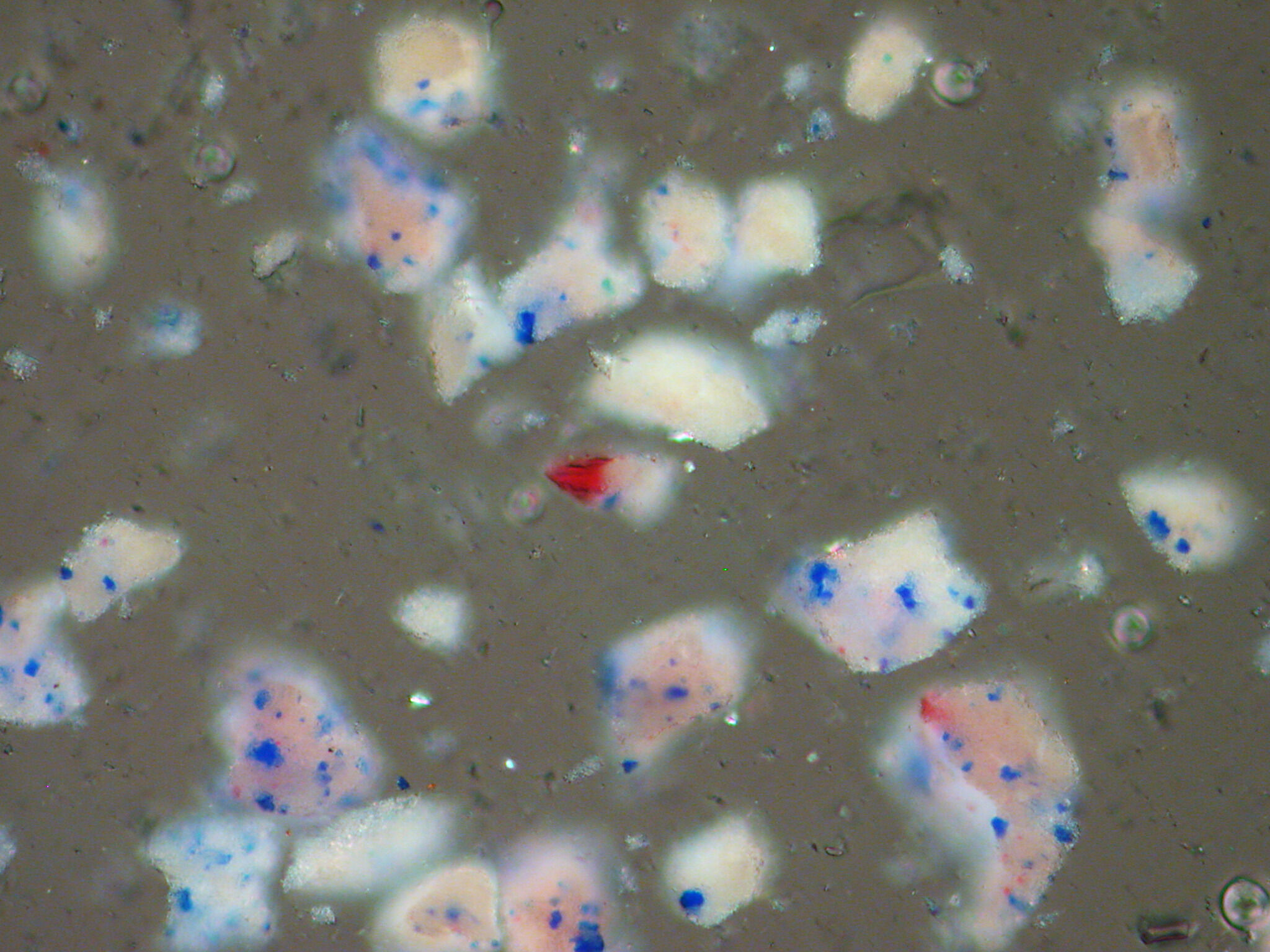 Fig. 23. Dispersed pigments showing ultramarine and geranium lake in zinc white with traces of viridian, used in the shadow strokes in Fig. 22, transmitted light with crossed polars, 200x
Fig. 23. Dispersed pigments showing ultramarine and geranium lake in zinc white with traces of viridian, used in the shadow strokes in Fig. 22, transmitted light with crossed polars, 200x
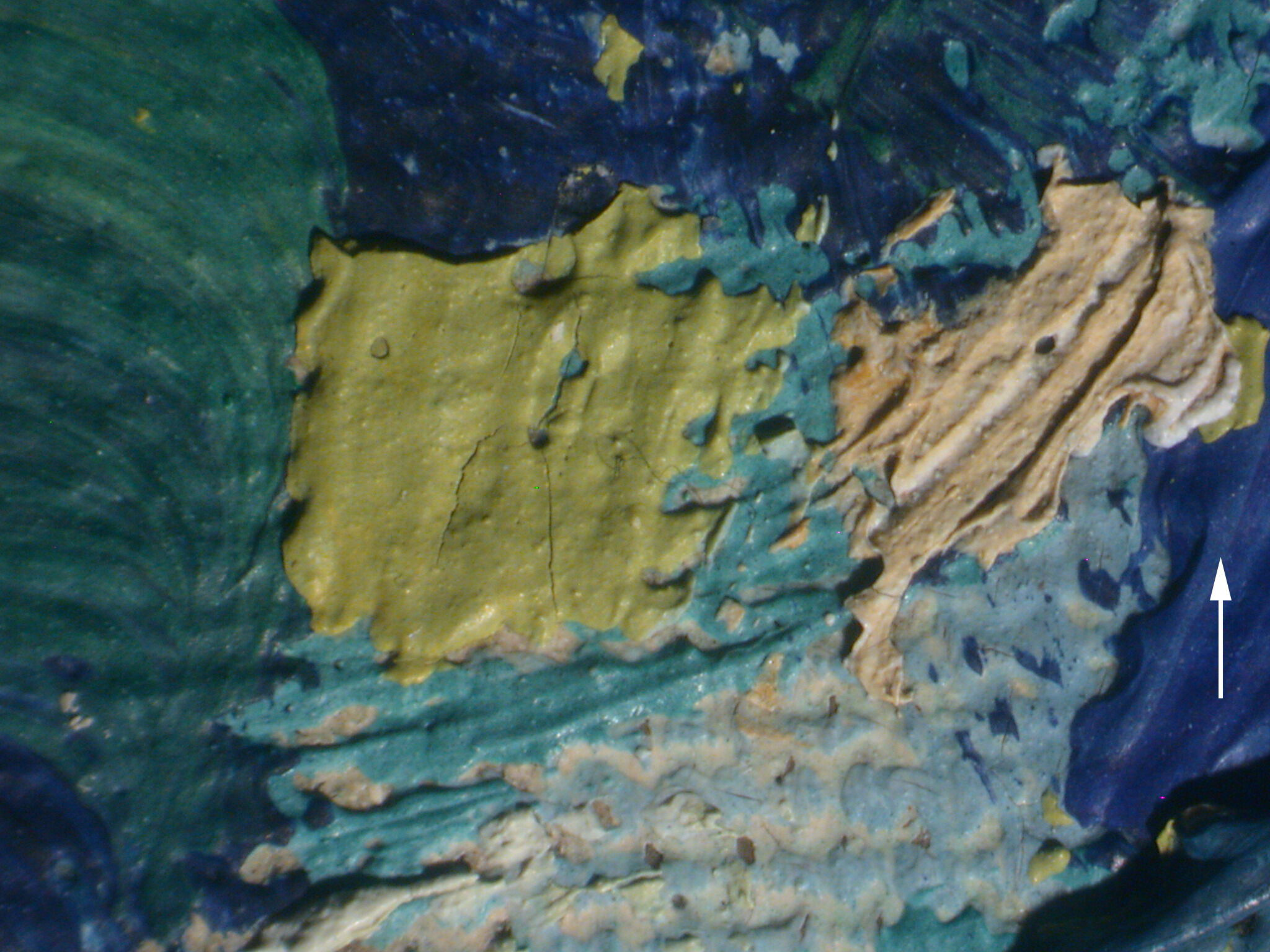 Fig. 24. Photomicrograph of tree foliage on the lower right corner, Olive Trees (1889), 6x
Fig. 24. Photomicrograph of tree foliage on the lower right corner, Olive Trees (1889), 6x
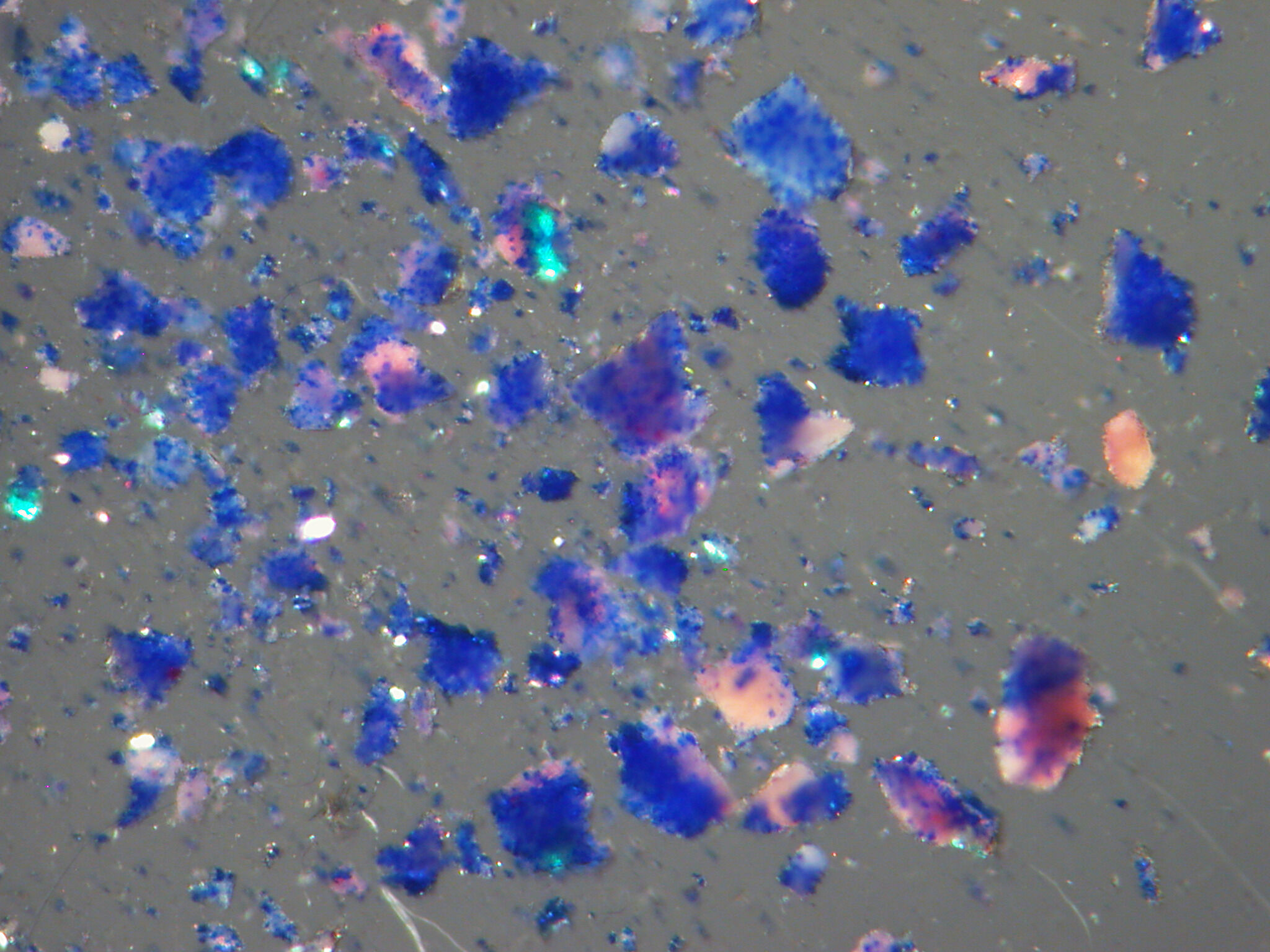 Fig. 25. Partially dispersed pigment from the intense blue stroke in the foliage shown in Fig. 24, a mixture primarily of ultramarine and geranium lake with minor amounts of zinc white and viridian, transmitted light with crossed polars, 100x
Fig. 25. Partially dispersed pigment from the intense blue stroke in the foliage shown in Fig. 24, a mixture primarily of ultramarine and geranium lake with minor amounts of zinc white and viridian, transmitted light with crossed polars, 100x
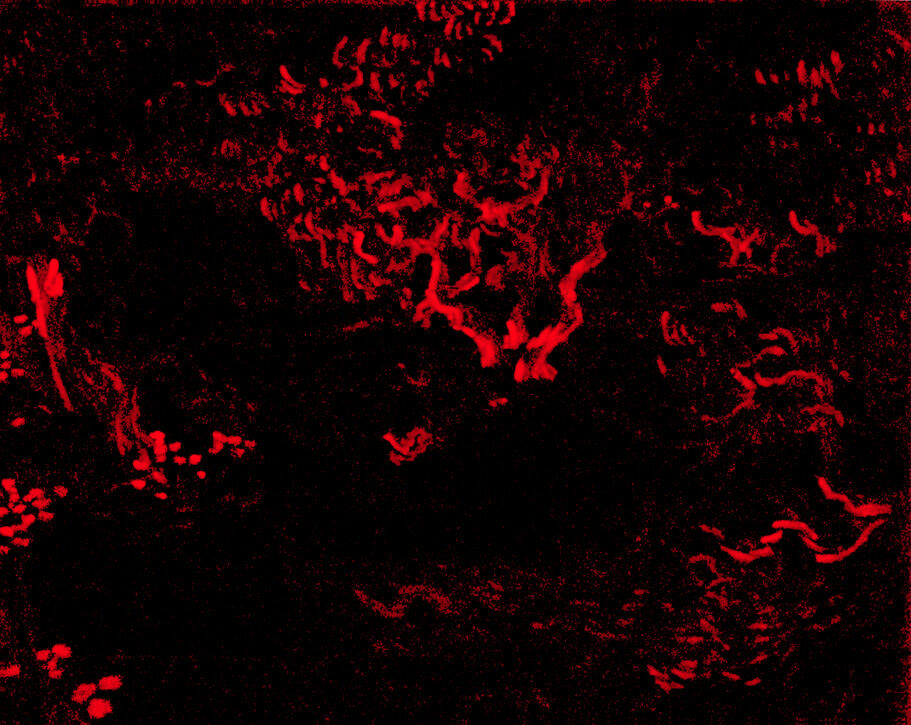 Fig. 26. Elemental map for bromine, showing the distribution of geranium lake, both faded and unfaded, where it can be detected in amounts sufficient to differentiate from admixed pigments.
Fig. 26. Elemental map for bromine, showing the distribution of geranium lake, both faded and unfaded, where it can be detected in amounts sufficient to differentiate from admixed pigments.
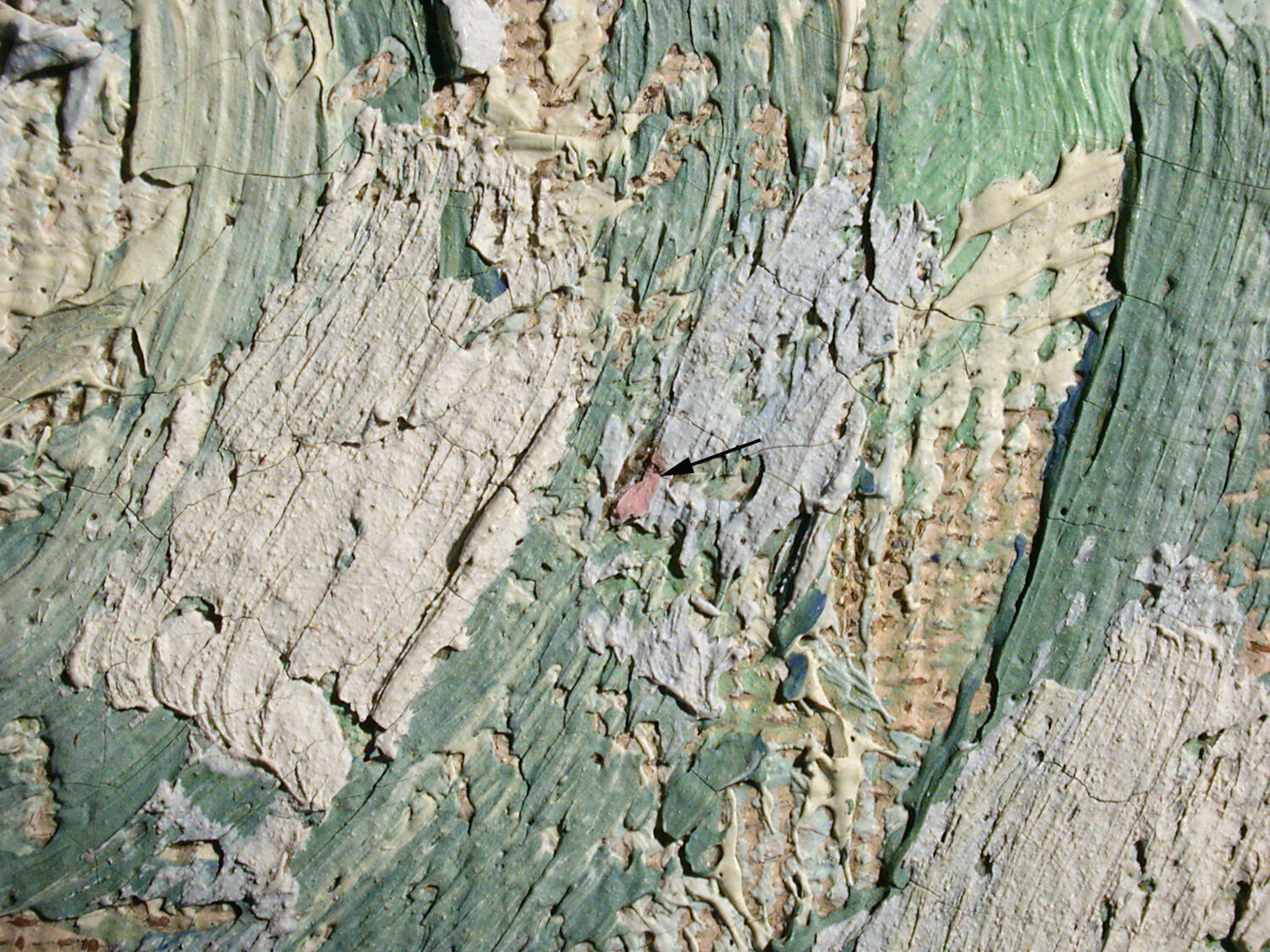 Fig. 27. Detail of the lower right corner, Olive Trees (1889). A loss in the pale blue paint stroke exposes its original, unfaded pink interior.
Fig. 27. Detail of the lower right corner, Olive Trees (1889). A loss in the pale blue paint stroke exposes its original, unfaded pink interior.
Unlike some published examples of Van Gogh’s work in which geranium lake remains protected under the frame edge, from which its color could be virtually extrapolated to other parts of the painting, Olive Trees has no surviving lake mixtures to provide these visual cues. To evaluate the impact of the fading on the color relationships of Olive Trees, XRF elemental mapping was conducted to determine the distribution of bromine across the painting. Bromine, prevalent in the eosin dye16Eosin is a water-soluble, synthetic dye invented in 1871 and soon after adapted to painting use in the form of a “lake” pigment of which there were several varieties. The variety found in Olive Trees contains eosin bound to aluminum ions derived from an alum solution. See A. Baeyer, “Ueber eine neue Klasse von Farbstoffen,” Berichte der Deutschen Chemischen Gesellschaft 4, no. 2 (1871): 555–58; M. J. Depierre,“Note on the Application of Eosin,” 217; A. H. Allen, Commercial Organic Analysis, 2nd ed., vol. 3, part 1 (Philadelphia: P. Blakiston, Son, 1889), 167–73. This “geranium” lake can be markedly faded by light exposure, a detrimental trait already known when employed by Van Gogh. By 1900 its short-lived commercial success was already being referred to in the past tense. See F. H. Jennison, The Manufacture of Lake Pigments from Artificial Colours (London: Scott, Greenwood & Son; New York: Van Nostrand, 1900). molecule that is responsible for the color of geranium lake, remains in place in proportion to its amount in the paint mixture even as the color fades (Fig. 26). Pale blue paint strokes throughout the foreground contain this fugitive red lake, and Figure 27 reveals the preserved pink color beneath the paint surface, beyond the reach of light. The juxtaposition of this now-faded pink among the various green brushstrokes of the foreground would have produced a striking interplay of complementary colors and broken tones.17See the accompanying catalogue essay by Aimee Marcereau DeGalan. For an overview of Van Gogh’s experimentation with color, see Maite van Dijk, “Van Gogh and the Laws of Colour: An Introduction,” in Van Gogh’s Studio Practice, 216–25.
Similarly, the blue shadows at the base of the olive trees were once violet in color, a detail that closely connects the Nelson-Atkins painting to a description in Van Gogh’s June 1889 letter: “I’ve just finished a landscape of an olive grove with gray foliage more or less like that of the willows, their cast shadows violet on the sun-drenched sand.”18Vincent van Gogh to Willemien van Gogh, June 16, 1889 in Van Gogh Museum, Amsterdam, no. b.712 V/1962; as cited in Jansen et al., Letters, http://www.vangoghletters.org/vg/letters/let780/letter.html. These violet shadows would have heightened the yellow tonalities on the adjacent sun-splashed ground.
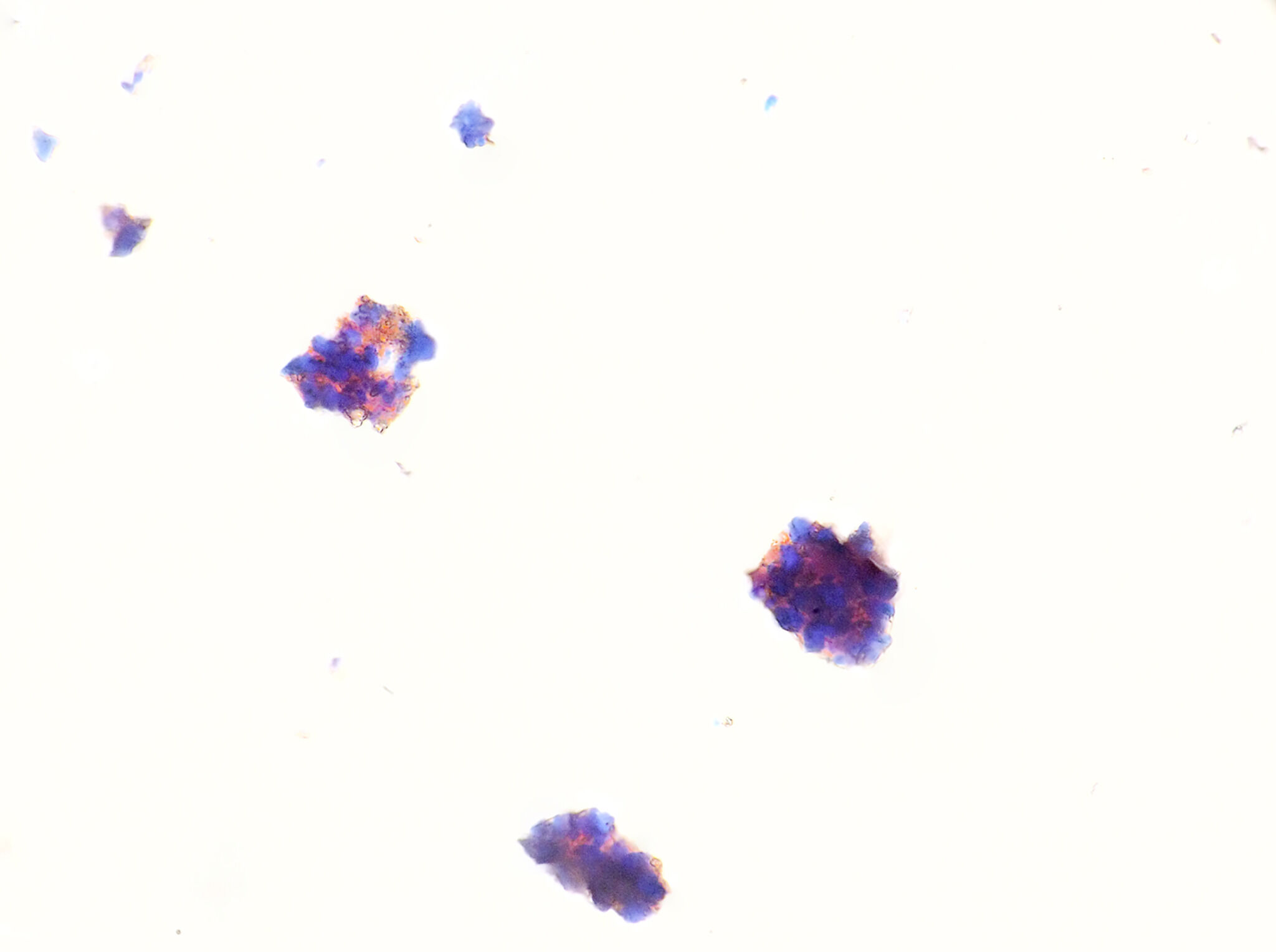
The fading of the red lake from the paint surface also affects the dark blue paint strokes of the central trees at the top edge, which contain mixtures of ultramarine and geranium lake in nearly equal proportions. This blue color was once dark violet (Fig. 28). The use of complementary colors to achieve a sense of vibrancy is evident in the tree trunks where pure chrome yellow was placed beside a violet mixture of ultramarine and geranium lake with a small amount of viridian (Fig. 29). Fading of the lake has diminished the optical effect, as ultramarine blue is the dominate color today. A microsample of the violet paint, sheltered from fading by the overlying chrome yellow, reveals its original color (Fig. 30).
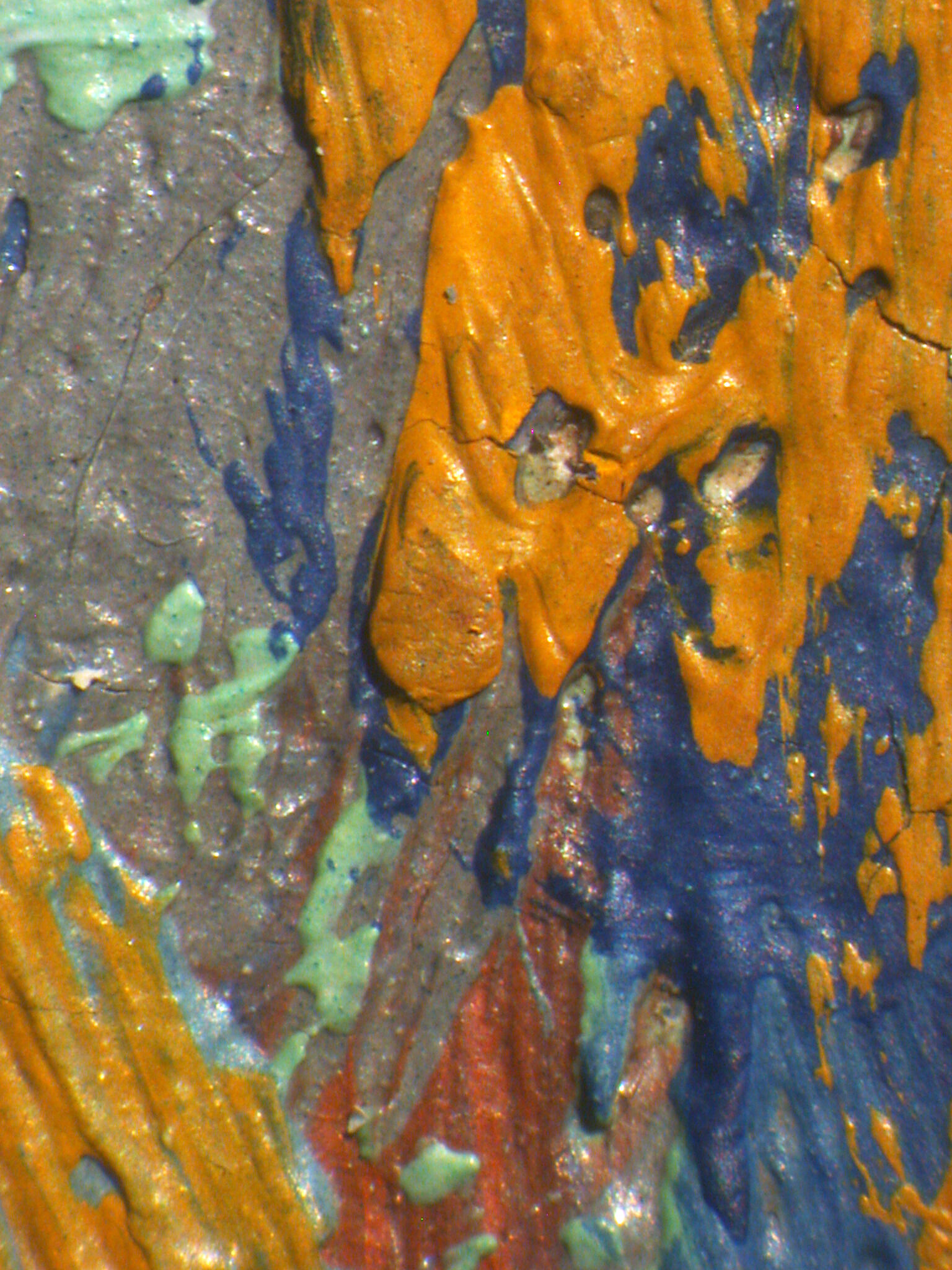 Fig. 29. Photomicrograph of rightmost trunk of the central tree, Olive Trees (1889), 12x
Fig. 29. Photomicrograph of rightmost trunk of the central tree, Olive Trees (1889), 12x
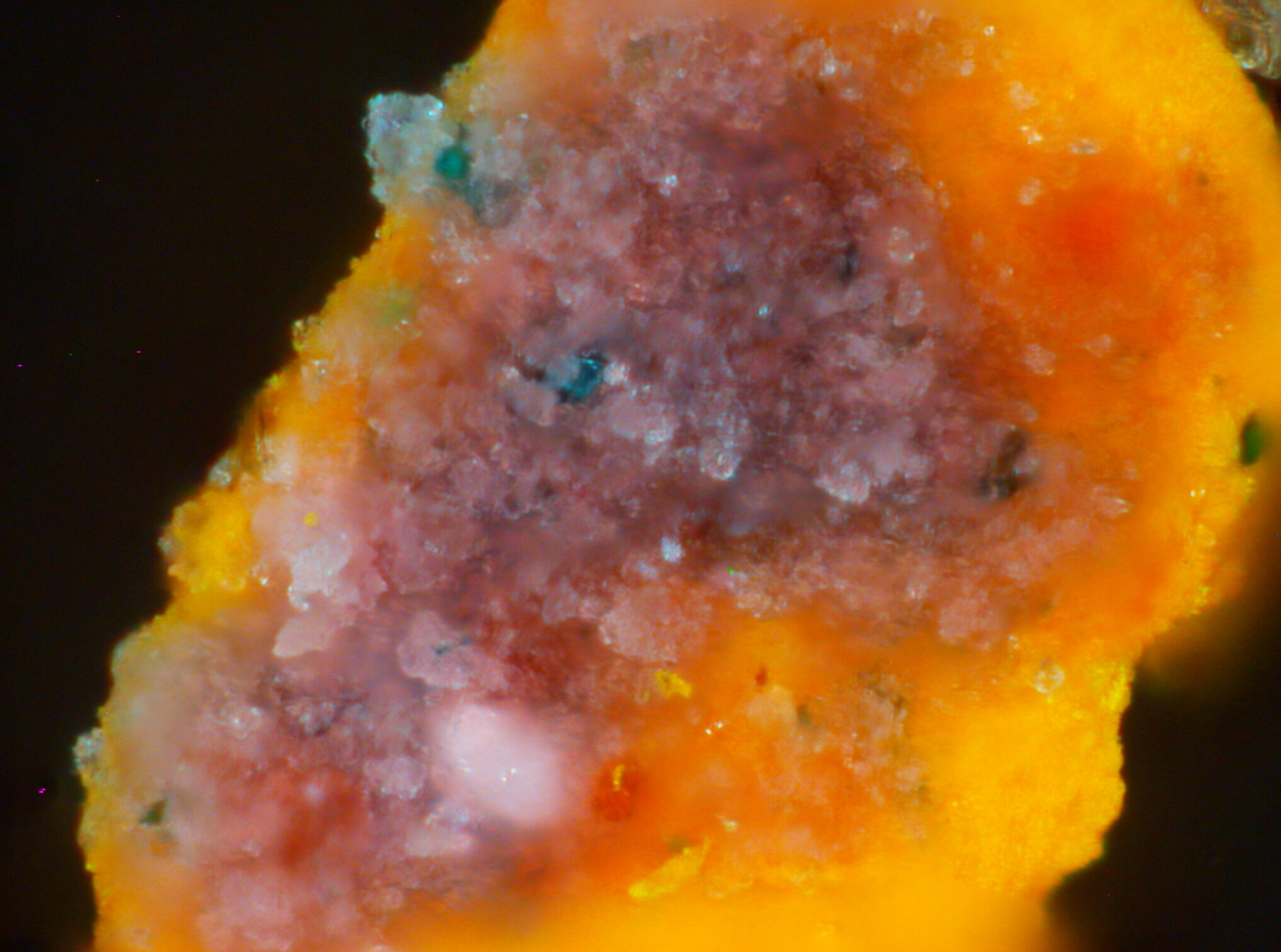 Fig. 30. Microsample of the gray paint protected by the overlapping orange stroke on the central tree trunk, revealing the unfaded, complementary violet color, reflected light, 200x
Fig. 30. Microsample of the gray paint protected by the overlapping orange stroke on the central tree trunk, revealing the unfaded, complementary violet color, reflected light, 200x
Numerous paint losses, the majority of which are part of the second phase of painting, are evident across the landscape, concentrated in the lower foreground and upper and right trees. In some cases, the detachment of the paint caused the loss of multiple strokes applied during the second phase (Fig. 15). The highly textured surface of Olive Trees effectively distracts from these paint losses, but like the faded geranium lake, their loss impacts the appearance of the landscape. The losses expose underlying paint colors that were not meant to be visible. For example, paint loss in a large section of expanded blue sky on the upper left has exposed the underlying green paint of the trees, effectively undoing this modification by the artist (Fig. 31).
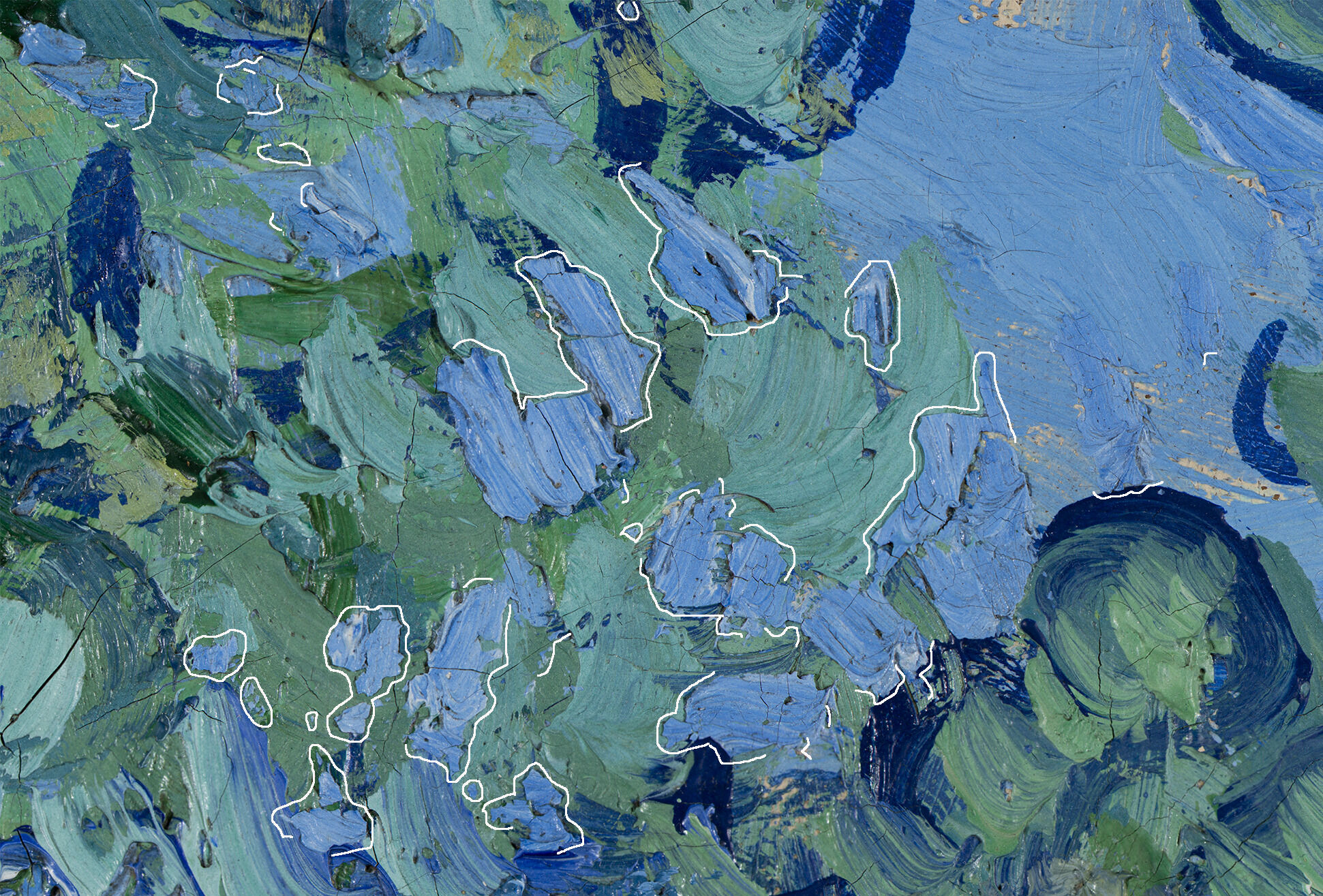
Despite the important instances of paint loss and color fading, the painting is in stable condition today. Wax fillsfill material: A material added to a loss of paint and/or ground to create an area level with the surrounding original paint. and retouchingretouching: Paint application by a conservator or restorer to cover losses and unify the original composition. Retouching is an aspect of conservation treatment that is aesthetic in nature and that differs from more limited procedures undertaken solely to stabilize original material. Sometimes referred to as inpainting or retouch. cover its worn, outermost edges and corners. The thin ground layer is abradedabrasion: A loss of surface material due to rubbing, scraping, frequent touching, or inexpert solvent cleaning. in many areas where it was left exposed in the composition, revealing the upper peaks of the canvas weave. When the painting was last treated in 2005, a low concentration of Regalrez varnish was brush-applied to the paint surface, followed by removal of much of the varnish with a dry brush, in an effort to reach an appropriate saturation level while maintaining an unvarnished appearance.19Scott Heffley, December 8, 2005, treatment report, NAMA conservation file, no. 32-2.
Notes
-
Anthea Callen, The Art of Impressionism: Painting Technique and the Making of Modernity (London: Yale University Press, 2000), 15.
-
The scientific study of Olive Trees was supported by an endowment from the Andrew W. Mellon Foundation for conservation science at The Nelson-Atkins Museum of Art.
-
No underdrawing was detected using magnified inspection or infrared imaging conducted in the infrared spectrum between wavelengths of 700 – 2200 nanometers.
-
X-ray fluorescence spectrometry elemental mapping was undertaken as part of a collaboration with the Laboratory of Molecular and Structural Archaeology, directed by Philippe Walter (CNRS/Pierre and Marie Curie University, Paris) by which their instrument design and operational software was provided to the authors.
-
The authors are grateful to paleo-entomologist, Dr. Michael S. Engel, senior curator and university distinguished professor, University of Kansas, and associate, American Museum of Natural History, NY. Dr. Engel determined that the disarticulated body fragments (head and hind leg) lodged in the wet paint of Olive Trees point to an already dead nymph or a shed exuvium. This fact prohibited the use of the annual seasonal cycle of grasshoppers in the region during 1889 to gain more specificity as to the months in which Van Gogh completed the landscape.
-
See the accompanying catalogue essay by Aimee Marcereau DeGalan.
-
The findings presented include those from an earlier 2012 study with curatorial contributions by Nicole R. Myers, former associate curator, European paintings and sculpture, The Nelson-Atkins Museum of Art.
-
The underlying cause of this granular appearance has not been definitively identified. This distinctive texture is most prevalent among the lighter paint mixtures, and although zinc-fatty acid soap formations are widespread within the paints of both phases, the formations do not protrude through or disrupt the paint surface in those locations where they have been found inside samples. Zinc-fatty acid soaps, formed by reactions between zinc white and free fatty acids present in the oil paint, have been widely cited as a cause of adhesion loss between successive applications of oil paints based on zinc white, as in the case of Olive Trees. Crystalline zinc soaps have been found at the interface between the delaminating paint layers in various paintings based on zinc white. See for example L. Raven, M. Bisschoff, M. Leeuwestein, M. Geldof, J.J. Hermans, M. Stols-Witlox, and K. Keune, “Delamination Due to Zinc Soap Formation in an Oil Painting by Piet Mondrian (1872–1944): Conservation Issues and Possible Implications for Treatment,” in Metal Soaps in Art: Conservation and Research, ed. F. Casadio, K. Keune, P. Noble, A. Van Loon, E. Hendriks, S.A. Centeno, and G. Osmond (Springer Cultural Heritage Science Series, 2019), 343–58.
-
Vincent van Gogh to Theo van Gogh, September 28, 1889, in Van Gogh Museum, Amsterdam, no. b656 V/1962; published in Leo Jansen, Hans Luijten, and Nienke Bakker, eds., Vincent van Gogh: The Letters (Amsterdam and The Hague: Van Gogh Museum and Huygens, 2009), no. 806, http://www.vangoghletters.org/vg/letters/let806/letter.html. All English translations are from this publication. In footnote 8, the Nelson-Atkins painting is suggested to be the olive grove described in relation to this shipment.
-
A collaborative research project, led by the Dallas Art Museum and Van Gogh Museum, to study all fifteen paintings that comprise the olive tree series is underway and may clarify the chronology and shipment dates of the entire series. Nienke Bakker and Nicole R. Myers, eds., Van Gogh and the Olive Groves (Dallas: Dallas Museum of Art; Amsterdam: Van Gogh Museum, forthcoming).
-
“Lake” pigment is produced by the combination of a soluble dye color with a soluble, usually colorless inorganic compound to produce a colored precipitate that can be handled like a dry pigment and thereafter combined with oil. In some cases, the precipitation was carried out in the presence of a colored carrier so that the dye precipitate coats a particle of another pigment. In 1889 eosin lakes of several varieties were available, including some that were precipitated on red lead for their combined color. However, Van Gogh employed the “geranium” lake whose color was solely that of its eosin content. Eosin was synthesized in 1871. See M.J. Depierre, “Note on the Application of Eosin,” American Chemist 6–7 (New York: C.F. & W. H. Chandler, 1875), 217.
-
Kathryn A. Dooley, Annalisa Chieli, Aldo Romani, Stijn Legrand, Costanza Miliani, Koen Janssens, and John K. Delaney, “Molecular Fluorescence Imaging Spectroscopy for Mapping Low Concentrations of Red Lake Pigments: Van Gogh’s Painting The Olive Orchard,” Angewandte Chemie 59, no. 15 (April 6, 2020): 6046–53.
-
Dooley et al., “Molecular Fluorescence Imaging Spectroscopy,” 6050. Tin and calcium associated with these lakes were not associated with the red lake in the Nelson-Atkins Olive Trees.
-
Muriel Geldof, Matthijs de Keijzer, Maarten van Bommel, Kathrin Pilz, Johanna Salvant, Henk van Keulen, and Luc Megens, “Van Gogh’s Geranium Lake,” in Van Gogh’s Studio Practice, ed. Marije Vellekoop, Muriel Geldof, Ella Hendriks, Leo Jansen, and Alberto de Tagle (Brussels: Mercatorfonds, 2013), 285–86.
-
All references to specific pigments are based on identification from samples that were examined in the scanning electron microscope, supported with elemental analysis by X-ray spectrometry. Polarized light microscopy was used to screen for compounds not responsive to other tests and to correlate colors to the proportions of mixtures. Confirmatory pigment identifications were carried out with Raman spectroscopy and Fourier transform infrared spectroscopy.
-
Eosin is a water-soluble, synthetic dye invented in 1871 and soon after adapted to painting use in the form of a “lake” pigment of which there were several varieties. The variety found in Olive Trees contains eosin bound to aluminum ions derived from an alum solution. See A. Baeyer, “Ueber eine neue Klasse von Farbstoffen,” Berichte der Deutschen Chemischen Gesellschaft 4, no. 2 (1871): 555–58; M. J. Depierre,“Note on the Application of Eosin,” 217; A. H. Allen, Commercial Organic Analysis, 2nd ed., vol. 3, part 1 (Philadelphia: P. Blakiston, Son, 1889), 167–73. This “geranium” lake can be markedly faded by light exposure, a detrimental trait already known when employed by Van Gogh. By 1900 its short-lived commercial success was already being referred to in the past tense. See F. H. Jennison, The Manufacture of Lake Pigments from Artificial Colours (London: Scott, Greenwood & Son; New York: Van Nostrand, 1900).
-
See the accompanying catalogue essay by Aimee Marcereau DeGalan. For an overview of Van Gogh’s experimentation with color, see Maite van Dijk, “Van Gogh and the Laws of Colour: An Introduction,” in Van Gogh’s Studio Practice, 216–25.
-
Vincent van Gogh to Willemien van Gogh, June 16, 1889 in Van Gogh Museum, Amsterdam, no. b.712 V/1962; as cited in Jansen et al., Letters, http://www.vangoghletters.org/vg/letters/let780/letter.html.
-
Scott Heffley, December 8, 2005, treatment report, NAMA conservation file, no. 32-2.
Documentation
Citation
Chicago:
Meghan Gray, “Vincent van Gogh, Olive Trees, June/September 1889,” documentation in ed. Aimee Marcereau DeGalan French Paintings and Pastels, 1600–1945: The Collections of the Nelson-Atkins Museum of Art (Kansas City: The Nelson-Atkins Museum of Art, 2021), https://doi.org/10.37764/78973.5.738.4033
MLA:
Gray, Meghan. “Vincent van Gogh, Olive Trees, June/September 1889,” documentation. French Paintings and Pastels, 1600–1945: The Collections of the Nelson-Atkins Museum of Art, edited by Aimee Marcereau DeGalan, The Nelson-Atkins Museum of Art, 2021. doi: 10.37764/78973.5.738.4033.
Provenance
Citation
Chicago:
Meghan Gray, “Vincent van Gogh, Olive Trees, June/September 1889,” documentation in ed. Aimee Marcereau DeGalan French Paintings and Pastels, 1600–1945: The Collections of the Nelson-Atkins Museum of Art (Kansas City: The Nelson-Atkins Museum of Art, 2021), https://doi.org/10.37764/78973.5.738.4033
MLA:
Gray, Meghan. “Vincent van Gogh, Olive Trees, June/September 1889,” documentation. French Paintings and Pastels, 1600–1945: The Collections of the Nelson-Atkins Museum of Art, edited by Aimee Marcereau DeGalan, The Nelson-Atkins Museum of Art, 2021. doi: 10.37764/78973.5.738.4033.
With the artist, Saint-Rémy-de-Provence, France, until September 20 or 28, 1889 [1];
To his brother, Theo van Gogh (1857–91), Paris, 1889–January 25, 1891 [2];
Inherited by his widow, Johanna van Gogh-Bonger (1862–1925), Bussum and Amsterdam, The Netherlands, stock no. 147, as Oliviers /30/effet du matin, 1891–May 25/June 1905 [3];
Purchased from Bonger by Kunstsalon Paul Cassirer, Berlin, stock no. 6588, as Olivenbaume, May 25/June 1905 [4];
Purchased from Cassirer by Carl Moll (1861–1945) for the Galerie H. O. Miethke, Vienna, May 25, 1905–at least January 1906 [5];
Purchased from the Galerie Miethke by Baron Adolf Kohner (1865/6–1937), Budapest, inventory no. K. 27, as Olajerdő, by April 24, 1910–October 7, 1930 [6];
[Possibly purchased from Kohner by] Paul Rosenberg and Co., Inc., Paris, London, and New York, no. 2854, as Les oliviers, by October 7, 1930–January 23, 1932 [7];
Purchased half-share from Rosenberg by Durand-Ruel, Paris, for Durand-Ruel, New York, stock no. 5169, as Les Oliviers, October 7, 1930–January 23, 1932 [8];
Purchased remainder of share from Rosenberg by Durand-Ruel, New York, January 23, 1932 [9];
Purchased from Durand-Ruel, through Harold Woodbury Parsons and Effie Seachrest, by The Nelson-Atkins Museum of Art, Kansas City, MO, 1932 [10].
Notes
[1] The artist may have sent the painting to his brother and dealer on or about September 20 or more likely on September 28, 1889. Letters from Vincent van Gogh, Saint-Rémy-de-Provence, to his brother, Theo van Gogh, on or about September 20, 1889, and September 28, 1889, Van Gogh Museum, Amsterdam, inv. nos. b655 a-b V/1962 and b656 V/1962; pub. in Leo Jansen, Hans Luijten, and Nienke Bakker, eds., Vincent Van Gogh: The Letters; The Complete Illustrated and Annotated Edition, vol. 5 (London: Thames and Hudson, 2009), letter nos. 805 and 806, pp. 100–11.
[2] Van Gogh viewed the consignments of paintings he sent to his brother and dealer, Theo van Gogh, as remuneration for the latter’s financial support. Letter from Vincent van Gogh, Nuenen, to his brother, Theo van Gogh, on or about March 20, 1884, Van Gogh Museum, Amsterdam, inv. nos. b398 V/1962 (sheet 1) and b397 d V/1962 (sheet 2); pub. in Leo Jansen, Hans Luijten, and Nienke Bakker, eds., Vincent Van Gogh: The Letters; The Complete Illustrated and Annotated Edition, vol. 3 (London: Thames and Hudson, 2009), letter no. 440, pp. 138–40.
[3] Although, formally speaking, Vincent Willem van Gogh (1890–1978) was joint owner of the Van Gogh collection from 1891, his mother, Johanna van Gogh-Bonger, managed the collection until her death in 1925. See the inventory of van Gogh’s works then in van Gogh-Bonger’s collection, Andries Bonger, “Catalogue des œuvres de Vincent van Gogh,” 1891, Brieven en Documenten, b 3055 V/1962 (document),Van Gogh Museum, Amsterdam, no. 147, as Oliviers /30/effet du matin. For the Cassirer exhibition, see Johanna van Gogh-Bonger, “List of 30 titles and prices of paintings by Vincent van Gogh, made for Cassirer, April 1905,” Van Gogh Museum, Amsterdam, Brieven en Documenten, 1905 b 2185 V/1982 (document, inkt, potlood, papier), no. 14-147, as Olijfbomen. Cassirer records the purchase of the canvas from Johanna on May 25, 1905 [see note 4], but Johanna records the sale of the canvas to Cassirer in her account book for the month of June 1905; see Theo van Gogh and Johanna van Gogh-Bonger, “Account book of Theo van Gogh and Johanna van Gogh-Bonger, May 21 1889–January 25, 1925,” Van Gogh Museum, Amsterdam, Brieven en Documenten, b 2205 V/1982 (boek, inkt op papier), p. 14 line no. 10, stock no. 4, as Olijven, and p. 89 line no. 21, as “ontvangen van Paul Cassirer te Berlijn voor 8 gr. En 1 kl. schilderij.” Copies in NAMA curatorial files.
[4] See Kunstsalon Paul Cassirer Berlin, Einkaufsbücher (3) 1903–1919 [book of purchases], May 25, 1905, Paul Cassirer-Walter Feilchenfeldt Archiv, Zurich, p. 44, stock no. 6588, as Olivenbäume. Kunstsalon Paul Cassirer Berlin, Verkaufsbuch (1) October 2, 1903–April 28, 1910 [stock book of sales], May 1905, Paul Cassirer-Walter Feilchenfeldt Archiv, Zurich, p. 102?, stock no. 6588?.
[5] Call Moll was the artistic director of Galerie H. O. Miethke from 1904–12.
[6] According to the verso of Kohner’s stock card (in a private collection, Hungary), the painting was “Vétetett a bécsi Galerie Miethke-cégtől.” We take this to mean that Kohner bought the painting from Galerie Miethke in Vienna. See correspondence from Péter Molnos, art historian, Budapest, to Meghan Gray, NAMA, October 4, 2017, NAMA curatorial file. See also inventory case K. 27, inventory loose card reproduced in Judit Geskó, ed., Van Gogh in Budapest, exh. cat. (Budapest: Museum of Fine Arts, 2006), 149. Kohner was a regular patron of Galerie Miethke and sold his Old Master collection in March 1908 in order to collect modern artists.
Kohner’s birthdate is unclear: The year 1866 is given in Péter Molnos, Lost Heritage: Hungarian Art Collectors in the Twentieth Century (Budapest: Kieselbach Gallery and Auction House, 2018), 92; the year 1865 is given in Ilona Sármány-Parsons, “Notes on Patronage of Modernism in the Fine Arts in Vienna and Budapest at the Turn of the Century,” CEU History Department Yearbook (1993): 151.
In his 1928 catalogue raisonné, J. B. de la Faille erroneously lists Galerie d’Art Barbazanges, Paris, as a constituent, an error that has persisted in other catalogues. See L’Œuvre de Vincent Van Gogh: Catalogue Raisonné (Paris: Éditions G. Van Oest, 1928), no. 715, pp. 1:203. The Galerie operated from ca. 1910/1911 until ca. 1929, during the time that Adolf Kohner is documented to have owned the painting.
[7] According to Péter Molnos, the painting was exported from Budapest on October 8, 1930, and was likely sent to Paul Rosenberg in Paris. See Péter Molnos, Aranykorok Romjain: Tanulmányok A Modern Magyar Festészet és Műgyűjtés Történetéből a Kieselbach Galéria Alapításának Huszadik Évfordulójá (Budapest: Kieselbach Galéria Kereskedelmi Kft., 2015), 107. See also no. 362, Central Archives, Museum of Fine Arts, Budapest, list of items exported from Budapest, no. 1930/ 3-23., 8 October 1930. Thanks to Péter Molnos for providing a scan of this document, which says, “Bejelentése alapján / K. föigazgató ni. 362. Dr. Kohner Adolf br. (Damjanich-n. / 20.) Izignálatlan Van Gogh-féle Olajerdő / c. festményre (Franciaországba ?) x/8”. See The Paul Rosenberg Archives, a Gift of Elaine and Alexandre Rosenberg, III.D, Rosenberg Galleries: Miniature Photo and Card Index, ca. 1910–87, and IV.A.I.a, Liste de Photographies, Paris, [1917–39] [1940–present], The Museum of Modern Art, New York. According to Ilda François, secretary to Elaine Rosenberg, Paul Rosenberg must have purchased the painting between June 1929 and November 1930; the exact purchase date is unknown. See also email from Paul-Louis Durand-Ruel and Flavie Durand-Ruel, Durand-Ruel et Cie., Paris, to Nicole Myers, NAMA, January 11, 2016, NAMA curatorial file. Durand-Ruel says that Rosenberg purchased the painting for 104,000 Pengos, which was the official Hungarian currency; therefore it is possible that Rosenberg purchased the painting directly from Kohner.
[8] See email from Paul-Louis Durand-Ruel and Flavie Durand-Ruel, Durand-Ruel et Cie., Paris, to Nicole Myers, NAMA, January 11, 2016, NAMA curatorial file. Durand-Ruel erroneously records the purchase of the painting by the Kansas City Art Institute. Actually, the painting was sent on approval to NAMA from March 18, 1931 until its purchase in January 1932, where it was placed on view at the Kansas City Art Institute since the museum was not yet built. At this time, a petition spearheaded by local dealer Effie Seachrest (1869–1952) was signed by about 135 people encouraging the museum to purchase the work. See “Petition to purchase Van Gogh Olive Orchards,” ca. April 21, 1931, NAMA Archives, William Rockhill Nelson Trust Office Records (RG 80/05), Series II: Objects Offered, 1926–33, box 7, folder 12, Durand-Ruel, 1931–32; and letter from J. C. Nichols to Sybil Brelsford, July 21, 1931, NAMA Archives, William Rockhill Nelson Trust Office Records (RG 80/05), Series I: General Correspondence and Records, 1926–33, box 6, folder 21, University Trustees 1931, f. 2. See also “Pictures remaining in the Art Institute after May 20, 1932,” May 20, 1932, NAMA Archives, William Rockhill Nelson Trust Office Records 1926–33, RG 80/05, Series I, box 02, folder 17, Exhibition at the Kansas City Art Institute, 1932.
[9] See email from Paul-Louis Durand-Ruel and Flavie Durand-Ruel, Durand-Ruel et Cie., Paris, to Meghan Gray, NAMA, February 5, 2016, NAMA curatorial file.
[10] “The offer [to Durand-Ruel] was made in answer to petitions to the Trustees signed by at least two hundred admirers urging the purchase of this picture” [see footnote 8]. See “University Trustees Meeting Minutes,” January 12, 1932, NAMA Archives, William Rockhill Nelson Trust Office Records (RG 80/05), Series I: General Correspondence and Records, 1926–33, box 6, folder 20, University Trustees 1932.
Related Works
Citation
Chicago:
Meghan Gray, “Vincent van Gogh, Olive Trees, June/September 1889,” documentation in ed. Aimee Marcereau DeGalan French Paintings and Pastels, 1600–1945: The Collections of the Nelson-Atkins Museum of Art (Kansas City: The Nelson-Atkins Museum of Art, 2021), https://doi.org/10.37764/78973.5.738.4033
MLA:
Gray, Meghan. “Vincent van Gogh, Olive Trees, June/September 1889,” documentation. French Paintings and Pastels, 1600–1945: The Collections of the Nelson-Atkins Museum of Art, edited by Aimee Marcereau DeGalan, The Nelson-Atkins Museum of Art, 2021. doi: 10.37764/78973.5.738.4033.
Vincent van Gogh, Olive Grove, June 1889, oil in canvas, 28 3/8 x 36 1/4 in. (72 x 92 cm), Kröller-Müller Museum, Otterlo.
Vincent van Gogh, Olive Grove, June 1889, oil on canvas, 17 3/8 x 23 1/4 in. (44 x 59 in.), Van Gogh Museum, Amsterdam.
Vincent van Gogh, The Olive Trees, June-July, 1889, oil on canvas, 28 5/8 x 36 in. (72.6 x 91.4 cm), Museum of Modern Art, New York.
Vincent van Gogh, Olive Orchard, September 1889, oil on canvas, 21 1/4 x 25 5/8 in. (53.5 x 64.5 cm), private collection, Switzerland.
Vincent van Gogh, Olive Trees, November 1889, oil on canvas, 28 5/8 x 36 1/4 in. (72.7 x 92.1 cm), Metropolitan Museum of Art, New York.
Vincent van Gogh, Olive Trees, November 1889, oil on canvas, 19 1/4 x 24 3/4 in. (51 x 65.2 cm), National Galleries Scotland, Edinburgh.
Vincent van Gogh, Olive Grove, Saint-Rémy, second half of November 1889, oil on canvas, 29 1/8 x 36 5/8 in. (74 x 93 cm), Göteborgs Konstmuseum, Göteborg, Sweden.
Vincent van Gogh, Olive Trees, second half of November 1889, oil on canvas, 29 x 36 1/2 in. (73.7 x 92.7 cm), The Minneapolis Institute of Arts.
Vincent van Gogh, Olive Grove, November–December 1889, oil on canvas, 28 5/8 x 36 5/8 in. (73 x 92.5 cm), Van Gogh Museum, Amsterdam.
Vincent van Gogh, Olive Trees on a Hillside, November–December 1889, oil on canvas, 13 x 15 3/4 in. (33 x 40 cm), Van Gogh Museum, Amsterdam.
Vincent van Gogh, Olive Grove with Two Olive Pickers, December 1889, oil on canvas, 28 3/4 x 36 1/4 in. (73 x 92 cm), Kröller-Müller Museum, Otterlo.
Vincent van Gogh, Women Picking Olives, December 15–20, 1889, oil on canvas, 28 3/4 x 35 in. (73 x 89 cm), Basil P. and Elise Goulandris, Lausanne.
Vincent van Gogh, Women Picking Olives, ca. December 20, 1889, oil on canvas, 28 5/8 x 36 in. (72.7 x 91.4 cm), Metropolitan Museum of Art, New York.
Vincent van Gogh, The Olive Orchard, ca. December 20, 1889, oil on canvas, 28 3/4 × 36 1/4 in. (73 × 92 cm ), National Gallery of Art, Washington DC.
Preparatory Works
Citation
Chicago:
Meghan Gray, “Vincent van Gogh, Olive Trees, June/September 1889,” documentation in ed. Aimee Marcereau DeGalan French Paintings and Pastels, 1600–1945: The Collections of the Nelson-Atkins Museum of Art (Kansas City: The Nelson-Atkins Museum of Art, 2021), https://doi.org/10.37764/78973.5.738.4033
MLA:
Gray, Meghan. “Vincent van Gogh, Olive Trees, June/September 1889,” documentation. French Paintings and Pastels, 1600–1945: The Collections of the Nelson-Atkins Museum of Art, edited by Aimee Marcereau DeGalan, The Nelson-Atkins Museum of Art, 2021. doi: 10.37764/78973.5.738.4033.
Vincent van Gogh, Olive Grove, June 1889, reed pen and brown ink on paper, 19 5/8 x 25 5/8 in. (50 x 65 cm), Van Gogh Museum, Amsterdam.
Vincent van Gogh, Olive Trees in a Mountain Landscape, second half of June 1889, pencil, pen, and reed pen on paper, 18 1/2 x 24 5/8 in. (47 x 62.5 cm), Museum of Modern Art, New York.
Vincent van Gogh, Olive Trees with the Alpilles in the Background, before June 18, 1889, reed pen, brush and black and brown inks over black graphite on bluish laid paper, 9 5/8 x 15 9/16 in. (24.5 x 39.5 cm), Private Collection, France.
Vincent van Gogh, Olive Trees with the Alpilles in the Background, June 17 or 18, 1889, black chalk, brush, brown ink on paper, 19 5/8 x 25 5/8 in. (50 x 65 cm), Van Gogh Museum, Amsterdam.
Vincent van Gogh Three Olive Trees with the Alpilles and Rising Sun I, October–November 1889, reed pen and brown ink on bluish laid paper, 9 5/8 x 15 9/16 in. (24.5 x 39.5 cm), Private Collection, France.
Vincent van Gogh, Three Olive Trees with the Alpilles and Rising Sun II, October–November 1889, reed pen and brown ink on bluish laid paper, 9 11/16 x 15 9/16 in. (24.6 x 39.5 cm), Private Collection, France.
Vincent van Gogh, Three Olive Trees with the Alpilles and Rising Sun III, October–November 1889, reed pen and brown ink on bluish laid paper, 9 5/8 x 15 9/16 in. (24.5 x 39.5 cm), Private Collection, France.
Vincent van Gogh, Olive Grove with Four Pickers, December 1889, reed pen and brown ink on bluish laid paper, 9 11/16 x 15 9/16 in. (24.6 x 39.5 cm), Private collection, France.
Vincent van Gogh, Women Picking Olives, May–June 1890, pencil on paper, 5 1/4 x 3 3/8 in. (13.4 x 8.5 cm), Van Gogh Museum, Amsterdam.
Exhibitions
Citation
Chicago:
Meghan Gray, “Vincent van Gogh, Olive Trees, June/September 1889,” documentation in ed. Aimee Marcereau DeGalan French Paintings and Pastels, 1600–1945: The Collections of the Nelson-Atkins Museum of Art (Kansas City: The Nelson-Atkins Museum of Art, 2021), https://doi.org/10.37764/78973.5.738.4033
MLA:
Gray, Meghan. “Vincent van Gogh, Olive Trees, June/September 1889,” documentation. French Paintings and Pastels, 1600–1945: The Collections of the Nelson-Atkins Museum of Art, edited by Aimee Marcereau DeGalan, The Nelson-Atkins Museum of Art, 2021. doi: 10.37764/78973.5.738.4033.
Possibly paintings by Vincent van Gogh, Theo van Gogh’s apartment, 8, Cité Pigalle, Paris, end of 1890.
Vincent Van Gogh, Museum van Oudheden, Groningen, Netherlands, February 21–26, 1896, no. 40, as Oliviers.
van Gogh exhibition, Galerie Vollard, Paris, ca. December 1896–February 1897, no cat., no. 21, as Jardin des Oliviers.
VII. Jahrgang Frühjahr 1905: VII. Ausstellung, Galerie Paul Cassirer, Berlin, April 29–ca. May 25, 1905, no. 23, as Olivenbäume.
Vincent van Gogh: Kollektiv-Ausstellung, Galerie H. O. Miethke, Vienna, January 6–31, 1906, no. 44, as Olivenhain.
Internationalen Kunstschau, Vienna, May–October 1909, room 14, no. 2, as Olivenhain.
Művészház nemzetközi impresszionista kiállításához, Művészház, Budapest, April 24–June 19, 1910, room 7, no. 4, as Oliva-erdő.
Die Neue Kunst, Galerie Miethke, Vienna, January–February 9, 1913, no. 19, as Olivenbäume.
A Köztulajdonba vett Műkincsek Elsö Kiállitása, Műcsarnok, Budapest, May–July 1919, room 6, no. 7, as Olajerdö.
One Hundred Years of French Painting 1820–1920, The Nelson-Atkins Museum of Art, Kansas City, MO, March 31–April 28, 1935, no. 64, as The Olive Grove.
Possibly Vincent Van Gogh, The Nelson-Atkins Museum of Art, Kansas City, MO, June 12–July 10, 1936, hors cat., as Olive Grove.
The Art and Life of Vincent van Gogh: A Loan Exhibition in Aid of American and Dutch War Relief, Wildenstein, New York, October 6–November 7, 1943, no. 48, as The Olive Trees.
Paintings by Vincent Van Gogh, John Herron Museum of Art, Indianapolis, November 14–December 12, 1943, hors cat.
Loan Exhibition of Great Paintings: Five Centuries of Dutch Art [Exposition de Tableaux Célèbres: Cinq Siècles d’Art Hollandais], Art Association of Montreal, Canada, March 9–April 9, 1944, no. 129, as The Olive Trees, Les Oliviers.
Revolutionaries in Art: 1846–1946, Denver Art Museum, November 8–30, 1946, no cat.
A Loan Exhibition of Six Masters of Post-Impressionism: Benefit of Girl Scout Council of Greater New York, Wildenstein, New York, April 8–May 8, 1948, no. 67, as The Olive Grove.
Work by Vincent Van Gogh, Cleveland Museum of Art, November 3–December 12, 1948, no. 22, as The Olive Trees (Les Oliviers).
Twentieth Anniversary Exhibition: The Beginnings of Modern Painting, France 1800–1910, Joslyn Memorial Art Museum, Omaha, NE, October 4–November 4, 1951, unnumbered, as The Olive Grove.
Twenty Years of Collecting, The Nelson-Atkins Museum of Art, Kansas City, MO, December 11–31, 1953, no cat.
Painters’ Painters, Buffalo Fine Arts Academy, Albright Art Gallery, Buffalo, NY, April 16–May 30, 1954, no. 29, as The Olive Grove.
Van Gogh: Loan Exhibition For the Benefit of The Public Education Association, Wildenstein, New York, March 24–April 30, 1955, no. 51, as The Olive Trees.
Possibly Cubists, Fauves, and Impressionists, Denver Art Museum, October 1–November 18, 1956, no cat.
Vincent Van Gogh: A Loan Exhibition of Paintings and Drawings, Los Angeles Municipal Art Gallery, July 3–August 4, 1957, no. 14, as The Olive Trees.
An Inaugural Exhibition: El Greco, Rembrandt, Goya, Cézanne, Van Gogh, Picasso, Milwaukee Art Institute, September 12–October 20, 1957, no. 79, as Olive Grove.
Twenty–fifth Anniversary Exhibition, The Nelson-Atkins Museum of Art, Kansas City, MO, December 1958, hors cat.
The Logic of Modern Art: An Exhibition Tracing the Evolution of Modern Painting from Cezanne to 1960, The Nelson-Atkins Museum of Art, Kansas City, MO, January 19–February 26, 1961, no. 7, as The Olive Grove.
Homage to Effie Seachrest, The Nelson-Atkins Museum of Art, Kansas City, MO, August 25–October 9, 1966, no. 10, as The Olive Grove.
Vincent van Gogh Exhibition, The National Museum of Western Art, Tokyo, October 12–December 8, 1985; Nagoya-City Museum, December 19, 1985–February 2, 1986, no. 82, as Olive Orchard.
Van Gogh in Saint-Rémy and Auvers, The Metropolitan Museum of Art, New York, November 25, 1986–March 22, 1987, no. 12, as Olive Orchard.
Impressionism: Selections from Five American Museums, The Carnegie Museum of Art, Pittsburgh, November 4–December 31, 1989; The Minneapolis Institute of Arts, January 27–March 25, 1990; The Nelson-Atkins Museum of Art, Kansas City, MO, April 21–June 17, 1990; The Saint Louis Art Museum, July 14–September 9, 1990; The Toledo Museum of Art, September 30–November 25, 1990, no. 36, as Olive Orchard.
Vincent van Gogh and the Painters of the Petit Boulevard, The Saint Louis Art Museum, February 17–May 13, 2001; Städelsches Kunstinstitut und Städtische Galerie, Frankfurt, June 8–September 2, 2001, unnumbered, as Olive Orchard.
l’Oro e l’Azzurro: I colori del Sud da Cézanne a Bonnard, Casa dei Carraresi, Treviso, October 10, 2003–March 7, 2004, no. 23, as Ulivi.
Gauguin and the Origins of Symbolism, Museo Thyssen-Bornemisza, Madrid, September 28, 2004–January 9, 2005, no. 70, as Olive Grove [Les oliviers].
Van Gogh: Heartfelt Lines, Albertina, Vienna, September 5–December 8, 2008, no. 115, as Olive Orchard.
Vincent Van Gogh: Between Earth and Heaven; The Landscapes, Kunstmuseum Basel, Switzerland, April 26–September 27, 2009, no. 51, as Olive Orchard.
References
Citation
Chicago:
Meghan Gray, “Vincent van Gogh, Olive Trees, June/September 1889,” documentation in ed. Aimee Marcereau DeGalan French Paintings and Pastels, 1600–1945: The Collections of the Nelson-Atkins Museum of Art (Kansas City: The Nelson-Atkins Museum of Art, 2021), https://doi.org/10.37764/78973.5.738.4033
MLA:
Gray, Meghan. “Vincent van Gogh, Olive Trees, June/September 1889,” documentation. French Paintings and Pastels, 1600–1945: The Collections of the Nelson-Atkins Museum of Art, edited by Aimee Marcereau DeGalan, The Nelson-Atkins Museum of Art, 2021. doi: 10.37764/78973.5.738.4033.
Possibly Frederik van Eeden, “Kunst: Vincent van Gogh,” De Nieuwe Gids, year 6, vol. 1, issue 2 (December 1890): 268–69 [repr. in Frederik van Eeden, Studies, tweede reeks (Amsterdam: W. Versluys, 1894), 107].
Vincent van Gogh, exh. cat. ([Groningen: Museum van Oudheden], 1896), 2, as Oliviers.
VII. Jahrgang Frühjahr 1905: VII. Ausstellung, exh. cat. (Berlin: Paul Cassirer, 1905), unpaginated, as Olivenbäume.
E[gbert] D[elpy], “Salon Cassirer,” Berliner Lokal-Anzeiger, no. 233 (May 16, 1905), as Olivenbäume.
August Endell, “Vincent van Gogh,” Freistatt, no. 24 (June 17, 1905): 379, as Olivenwald [repr. in Susan Alyson Stein, ed., Van Gogh: A Retrospective (New York: Hugh Lauter Levin Associates, 1986), 331].
Hugo von Habermann, Vincent van Gogh: Kollektiv-Ausstellung, exh. cat. (Vienna: Galerie H. O. Miethke, 1906), 15, as Olivenhain.
L[udwig] H[eves]i, “Aus dem Wiener kunstleben: Vincent van Gogh; Die Scholle,” Pester Lloyd, no. 15 (January 18, 1906): 5, as Olivenhain.
Ludwig Hevesi, Altkunst-Neukunst: Wien 1894–1908 (1909; repr., Klagenfurt, Austria: Ritter Verlag, 1986), 527–29, as Olivenhain.
Katalog der Internationalen Kunstschau Wien 1909, exh. cat. (Vienna: Arbeitsausschuss der Internationalen Kunstschau, 1909), 27, as Olivenhain.
Miklós Rózsa, ed., Kalauz a Művészház nemzetközi impresszionista kiállításához, exh. cat. (Budapest: Művészház, 1910), 51, (repro.), as Oliva-erdő.
h. ö, “Budapesti magángyűjtemények. I. Dr. Kohner Adolf [Private Collections in Budapest. I. Dr. Adolf Kohner],” Pesti Napló (April 22, 1910): 12, as Tájkép [repr., Péter Molnos, Lost Heritage: Hungarian Art colelctors in the Twentieth Century (Budapest: Kieselbach Gallery and Auction House, 2018), 136, as Landscape].
Simon Meller, “Kohner Adolf Művészeti Gyűjteménye,” Vasárnapi Ujság 58, no. 18 (April 30, 1911): 354, 363, (repro.), as olivaerdejével.
Didier Rózsaffy, “Une visite à la Collection de M. le Dr. Kohner,” Revue de Hongrie 7, no. 6 (June 15, 1911): 711, as Forêt d’oliviers.
Hugo Haberfield, “Die französischen Bilder der Sammlung Kohner,” Der Cicerone: Halbmonatsschrift für die Interessen des Kunstforschers und Sammlers 3, no. 15 (August 1911): 589, as Olivengarten.
“Magyar amatőrök I. Dr. Kohner Adolf,” Interieur: a kávéház és lakóház: szak-és iparművészeti képes folyóirat 1, no. 4 (March 15, 1912), 5.
Die Neue Kunst, exh. cat. (Vienna: Galerie Miethke, 1913), unpaginated, as Olivenbäume.
József Patai, “Báró dr. Kohner Adolf műgyűjteménye,” Múlt és Jövő 4 (July 1914): 361, 375, (repro.).
A Köztulajdonba vett Műkincsek Elsö Kiállitása, exh. cat. (Budapest: Műcsarnok, 1919), 44, as Olajerdö.
Éber László, “Van Gogh tragikuma,”Ars Una: Müvészeti szemle 1, no. 1 (October 1923): 27, (repro.), as Olajerdö.
Éber László, Vincent Van Gogh Levelei (Budapest: Amicus Kiadás, 1924), (repro.).
Ferenc Lehel, Ecce Criticus: Kritikakritika (Budapest: Ferenc Lehel, 1924), (repro.), as Kert Olajfákkal.
Possibly “Courrier de la Presse: Van Gogh a [sic] l’asile de Saint-Rémy,” Le Bulletin de la vie artistique 7, no. 16 (August 15, 1926): 251.
François Lehel, Notre Art Dément: Quatre Études sur l’Art Pathologique (Paris: J. Povolozky et Cie, 1926), (repro.).
J.-B. De La Faille, L’Œuvre de Vincent Van Gogh: Catalogue Raisonné (Paris: Éditions G. Van Oest, 1928), no. 715, pp. 1:203, 2pt2: (repro.), as Les oliviers.
Chroniquer, “A műgyűjtő: Báró Kohner Adolf gyűjteménye,” Képzőművészet 3, no. 16 (January 1929): 9–17.
Elek Petrovics, “Báró Kohner Adolf Gyüjteménye,” Magyar Müvészet 5, no. 6 (1929): 319, 321, (repro.), as Olajerdő.
“Dine with Art Trustees: Institute Board Bids Others to Annual Meeting Tonight,” Kansas City Times 94, no. 81 (April 4, 1931): 2.
“In Gallery and Studio,” Kansas City Star 51, no. 199 (April 4, 1931): E.
“Buys an 1889 Painting: Nelson Gallery Gets its First ‘Modern’ Canvas,” Kansas City Star 52, no. 155 (February 19, 1932): 2, as The Olive Grove.
Art News 30, no. 21 (February 20, 1932): 10, (repro.), as Les Oliviers.
“The First Modern Master,” Kansas City Star 52, no. 156 (February 20, 1932): D, as The Olive Grove.
“Nelson Trust Buys a van Gogh,” New York Times 81, no. 27,056 (February 21, 1932): 1–10, as Les Oliviers.
“Kansas City Acquires a Memorable Van Gogh,” Art Digest, 6, no. 11 (March 1, 1932): 8, (repro.), as Les Oliviers.
M[inna] K. P[owell], “Art: Mr. Parsons Will Be Heard Thursday Night on ‘The Italian Renaissance;’ What Is to Be Seen in the Group of Recently Acquired Paintings for the William Rockhill Nelson Gallery of Art Was Told the Hospitality Committee Yesterday by Him,” Kansas City Times 95, no. 88 (April 12, 1932): 10.
“Kansas City Adds Important Works to its Holdings,” Art News 30, no. 30 (April 23, 1932): 8, as Les Oliviers.
W. Scherjon, Catalogue des Tableaux par Vincent Van Gogh décrits dans ses lettres—Périodes: St. Rémy et Auvers sur Oise (Utrecht: Société d’Editions A. Oosthoek, 1932), 20, 55–56, 78, 80–81, (repro.), as Oliviers.
“In Gallery and Studio,” Kansas City Star 53, no. 266 (June 10, 1933): 4.
M[inna] K. P[owell], “In Gallery and Studio,” Kansas City Star 54, no. 62 (November 18, 1933): 12.
Mrs. Henry Field, “‘the social whirl’…” Chicago Herald and Examiner 52, no. 173 (November 30, 1933): 25.
Thomas Carr Howe, “Kansas City Has Fine Art Museum: Nelson Gallery Ranks with the Best,” [unknown newspaper] (ca. December 1933), clipping, scrapbook, NAMA Archives, vol. 5, p. 6.
“Nelson Gallery of Art Special Number,” Art Digest 8, no. 5 (December 1, 1933): 14, 22–23, (repro.), as The Olive Grove and Les Oliviers.
Pierre Domène, “Le nouveau musée de Kansas City,” Beaux-Arts 72, no. 48 (December 1, 1933): 2.
“The William Rockhill Nelson Gallery of Art, Kansas City Special Number,” Art News 32, no. 10 (December 9, 1933): 28, 30, 46, (repro.), as Olive Grove and Les Oliviers.
Minna K. Powell, “The First Exhibition of the Great Art Treasures: Paintings and Sculpture, Tapestries and Panels, Period Rooms and Beautiful Galleries Are Revealed in the Collections Now Housed in the Nelson-Atkins Museum,” Kansas City Star 54, no. 84 (December 10, 1933): 4C, as The Olive Orchard.
“$15,000,000 Nelson Art Gallery Opens: Gift of Kansas City Star Publisher,” Boston Evening Transcript 104, no. 288 (December 11, 1933): 11.
“Art Critics View Nelson Gallery: Preview of Edifice, Costing $15,000,000 With Contents, Held at Kansas City,” New York Times 83, no. 27,715 (December 11, 1933): 24.
“Nelson Gallery of Art Opened at Kansas City: $14,000,000 Gift of ‘Star’ Publisher and His Heirs Already Fully Furnished,” New York Herald Tribune 93, no. 31,802 (December 11, 1933): 12.
Luigi Vaiani, “Art Dream Becomes Reality with Official Gallery Opening at Hand: Critic Views Wide Collection of Beauty as Public Prepares to Pay its First Visit to Museum,” Kansas City Journal-Post 80, no. 187 (December 11, 1933): 7, as Olive Grove.
George H. Leonard, “Art and Life,” Holyoke (MA) Daily Transcript; The Holyoke Telegram, no. 16,200 (December 16, 1933): 8.
“Nelson Gallery of Art Opens,” Editor and Publisher 66, no. 31 (December 16, 1933): 10.
Paul V. Beckley, “Art News,” Kansas City Journal Post 80, no. 193 (December 17, 1933): 2C.
The William Rockhill Nelson Gallery of Art and Mary Atkins Museum of Fine Arts, Handbook of the William Rockhill Nelson Gallery of Art (Kansas City, MO: William Rockhill Nelson Gallery of Art and Mary Atkins Museum of Fine Arts, 1933), 55, (repro.), as The Olive Grove.
A. J. Philpott, “Kansas City Now in Art Center Class: Nelson Gallery, Just Opened, Contains Remarkable Collection of Paintings, Both Foreign and American,” Boston Sunday Globe 125, no. 14 (January 14, 1934): 16.
“A Gift to Art Gallery,” Kansas City Star 54, no. 119 (January 14, 1934): 12A, as Olive Grove.
M[inna] K. P[owell], “Cezanne [sic] and the Patches of Color by Which He Transformed Modern Art,” Kansas City Star 54, no. 120 (January 15, 1934): [16]D, as Olive Grove.
Jenő Bálint, “Kohner Adolf teljesen összetört …,” [or title might be “Báró Kohner Adolf európai hírű műkincsei az árverelő kalapács alatt… ,”] A Reggel 13 (February 19, 1934): [7–8?].
Imre Fazekas, “Beszélgetés báró Kohner Adolffal-a Kohner-aukció után,” Pesti Napló (March 4, 1934): 8.
“Form Lost in Paintings: Paul Gardner Explains Work of the Impressionists,” Kansas City Times 97, no. 64 (March 15, 1934): 9, as The Olive Orchard.
“Art Talk to Teachers: Value of the Nelson Gallery to Kansas City Is Stressed,” Kansas City Star 54, no. 217 (April 22, 1934): 5B, Olive Grove.
“A Thrill to Art Expert: M. Jamot is Generous in his Praise of Nelson Gallery,” Kansas City Times 97, no. 247 (October 15, 1934): 7.
“In Gallery and Studio: News and Views of the Week in Art,” Kansas City Star 55, no. 32 (October 19, 1934): 18, as Olive Grove.
“Museums, Art Associations and Other Organizations,” in “For the Year 1933,” American Art Annual 30 (1934): 175, as The Olive Grove.
One Hundred Years French Painting, 1820–1920, exh. cat. (Kansas City, MO: William Rockhill Nelson Gallery of Art and Mary Atkins Museum of Fine Arts, 1935), unpaginated, as Olive Grove.
“The Olive Grove,” News Flashes (The William Rockhill Nelson Gallery of Art and Atkins Museum of Fine Arts) 1, no. 8 (March 10–30, 1935): 2, as The Olive Grove.
“Van Gogh’s ‘The Olive Grove’ Is the Masterpiece for Week,” Kansas City Journal-Post 81, no. 183 (March 24, 1935): 8-B, (repro.), as The Olive Grove.
P[aul] V. B[eckley], “Art News,” Kansas City Journal-Post 81, no. 197 (April 7, 1935): 8-B, as Olive Grove.
P[aul] V. B[eckley], “Art News,” Kansas City Journal-Post 81, no. 211 (April 21, 1935): 8-B, as Olive Orchard.
“French Loan Exhibition Last Call,” News Flashes (The William Rockhill Nelson Gallery of Art and Atkins Museum of Fine Arts) 1, no. 10 (April 21–May 3, 1935): 1, as The Olive Grove.
M[inna] K. P[owell], “In Gallery and Studio: News and Views of the Week in Art,” Kansas City Star 55, no. 221 (April 26, 1935): 15, as The Olive Grove.
“News from Abroad,” News Flashes (The William Rockhill Nelson Gallery of Art and Atkins Museum of Fine Arts) 1, no. 14 (September 1935): 3, as Olive Orchard.
“Moe Makers Are Busy: A Hundred Beaming Faces Hover Over Notebooks,” Kansas City Star 56, no. 35 (October 22, 1935): 1, as Olive Grove.
“Gallery Links Abroad: Paul Gardner Tells of his Discoveries in Brussels,” Kansas City Times 98, no. 261 (October 31, 1935): 3.
Alfred H. Barr, Jr., ed., Vincent van Gogh: With an introduction and notes selected from the letters of the artist, exh. cat., 3rd ed. (New York: Museum of Modern Art, 1936), 47, as Olive Trees.
“Van Gogh Exhibition,” The Missouri Club Woman 11, no. 6 (June 1936): 11, as Olive Orchard.
“Van Gogh Exhibition,” Clinton County Democrat 71, no. 10 (June 5, 1936): 1, as Olive Orchard.
“Van Gogh Art is Here: Million-Dollar Display Arrives Under Guard,” Kansas City Star 56, no. 263 (June 6, 1936): 2, as The Olive Grove.
“Van Gogh Exhibition,” News Flashes (The William Rockhill Nelson Gallery of Art and Atkins Museum of Fine Arts) 2, no. 13 (July 1–31, 1936): 1, as Olive Grove.
M[inna] K. P[owell], “Art: Van Gogh Paintings Will Remain One More Week at the Nelson Gallery Before Being Shipped to Minneapolis,” Kansas City Times 99, no. 161 (July 6, 1936): 6, as The Olive Grove.
W. Scherjon and Jos. de Gruyter, Vincent van Gogh’s Great Period: Arles, St. Rémy and Auvers sur Oise (Complete Catalogue) (Amsterdam: De Spieghel, 1937), part 2, St. Rémy no. 76, pp. 251, 268, 270–71, (repro.), as Olive Trees.
“Museum Directors Have to Play Detective Now and Then,” Kansas City Star 58, no. 210 (April 15, 1938): 14.
“Club Women to Gallery: Art Collection Wins Praise of 745 Visitors,” Kansas City Times 101, no. 116 (May 16, 1938): 8, as The Olive Grove.
“Important Gauguin Goes to Missouri Museum,” Art Digest 13, no. 3 (November 1, 1938): 13, as Olive Grove.
“Footnotes,” Lincoln (NE) Evening State Journal (December 2, 1938): 8.
J. D. W., “A Happier View of Van Gogh as Artist Absorbed in Work,” Kansas City Star 59, no. 191 (March 27, 1939): D[16], as The Olive Grove.
J.-B. de la Faille, Vincent Van Gogh, trans. Prudence Montagu-Pollock (New York: French and European Publications, 1939), no. 641, p. 441, (repro.), as The Olive-Trees.
“Fun in a New Art Game: Children at Nelson Gallery Delight in Innovation,” Kansas City Star 60, no. 364 (September 15, 1940): 6C, as The Olive Orchard.
H. C. H., “Art Judgments Are Governed Purely by Personal Factors: New Biographer of Vlaminck Points Out Fallacy of Expecting the Same Emotional Response from Different Individuals,” Kansas City Star 62, no. 72 (November 28, 1941): 16, as Olive Orchard.
The William Rockhill Nelson Gallery of Art and Mary Atkins Museum of Fine Arts, The William Rockhill Nelson Collection, 2nd ed. (Kansas City, MO: William Rockhill Nelson Gallery of Art and Mary Atkins Museum of Fine Arts, 1941), 41, 53, 168, (repro.), as The Olive Grove.
Georges de Batz, ed., The Art and Life of Vincent Van Gogh: Loan Exhibition in Aid of American and Dutch War Relief, exh. cat. (New York: Wildenstein, 1943), 36, 89, (repro.), as The Olive Trees.
“Gallery Changes: Gallery 19,” Gallery News (The William Rockhill Nelson Gallery of Art and Mary Atkins Museum of Fine Arts Museum) vol. 10, no. 3 (November 1943): 5.
Loan Exhibition of Great Paintings: Five Centuries of Dutch Art [Exposition de Tableaux Célèbres: Cinq Siècles d’Art Hollandais], exh. cat. (Montreal: Art Association of Montreal, 1944), 58, 91, (repro.), as The Olive Trees, Les Oliviers.
Marco Valsecchi, Disegni di Vincent Van Gogh, 2nd ed. (Milan: Ulrico Hoepli, 1944), 19.
Edward Alden Jewell, Vincent Van Gogh (New York: Hyperion Press and Duell, Sloan and Pearce, 1946), 44, (repro.), as The Olive Grove.
Carl Nordenfalk, Vincent van Gogh: en livsväg, 2nd ed. (Stockholm: P.A. Norstedt och Söners Forlag, 1946), 150.
Eduard Briner, Vincent van Gogh: sechs farbige Wiedergaben seiner Werke (Zurich: Rascher, 1947), 15–16.
A Loan Exhibition of Six Masters of Post-Impressionism: Benefit of Girl Scout Council of Greater New York, exh. cat. (New York: Wildenstein, 1948), 67, 73, (repro.), as The Olive Grove.
Howard Devree, “Modern Retrospect: Work by Post-Impressionist Masters,” New York Times 97, no. 32,950 (April 11, 1948): X 11, as Olive Grove.
“Gallery Notes,” Gallery News (The William Rockhill Nelson Gallery of Art and Mary Atkins Museum of Fine Arts) 14, no. 7 (May 1948): unpaginated, as Olive Grove.
Work by Vincent van Gogh, exh. cat. (Cleveland: Cleveland Museum of Art, 1948), 20, (repro.), as The Olive Trees (Les Oliviers).
The William Rockhill Nelson Gallery of Art and Mary Atkins Museum of Fine Arts, The William Rockhill Nelson Collection, 3rd ed. (Kansas City, MO: William Rockhill Nelson Gallery of Art and Mary Atkins Museum of Fine Arts, 1949), 67, (repro.), as The Olive Grove.
“Special Sunday Lecture,” Gallery News (The William Rockhill Nelson Gallery of Art and Mary Atkins Museum of Fine Arts) 18, no. 10 (November 1951): unpaginated, as Olive Grove.
Twentieth Anniversary Exhibition: The Beginnings of Modern Painting, France 1800–1910, exh. cat. (Omaha: Joslyn Memorial Art Museum, 1951), unpaginated, as The Olive Grove.
Winifred Shields, “The Twenty Best, a Special Exhibition at Nelson Gallery: Anniversary Will Be Observed by Showing of Paintings, Some Acquired Recently, Others Even Before the Institution Opened Two Decades Ago,” Kansas City Star 74, no. 78 (December 4, 1953): 36, as The Olive Grove.
Painters’ Painters, exh. cat. (Buffalo: Buffalo Fine Arts Academy, 1954), 41, 64–65, (repro.), as The Olive Grove.
Van Gogh: Loan Exhibition For the Benefit of The Public Education Association, exh. cat. (New York: Wildenstein, 1955), 23, 58, (repro.), as The Olive Trees.
Winfred Shields, “Special Showing Is Planned For Van Gogh Movie Here,” Kansas City Star 76, no. 363 (September 14, 1956): 24, as The Olive Grove.
Ross E. Taggart, “Kansas City Art,” Library Journal 82, no. 12 (June 15, 1957): 1596.
Vincent Van Gogh: A Loan Exhibition of Paintings and Drawings, exh. cat. (Los Angeles: Los Angeles Municipal Art Department, 1957), 17, 28, (repro.), as The Olive Trees.
An Inaugural Exhibition: El Greco, Rembrandt, Goya, Cézanne, Van Gogh, Picasso, exh. cat. (Milwaukee: Milwaukee Art Institute, 1957), 49, 54, (repro.), as Olive Grove.
Paul Mahlberg, Vincent van Gogh (1853–1890): Leben und Schaffen, exh. cat. (Essen, Germany: Villa Hügel, 1957), unpaginated.
Ross E. Taggart, ed., Handbook of the Collections in the William Rockhill Nelson Gallery of Art and Mary Atkins Museum of Fine Arts, 4th ed. (Kansas City, MO: William Rockhill Nelson Gallery of Art and Mary Atkins Museum of Fine Arts, 1959), 125, (repro.), as The Olive Grove.
The Logic of Modern Art: An Exhibition Tracing the Evolution of Modern Painting from Cezanne to 1960, exh. cat. (Kansas City, MO: Nelson-Atkins Museum of Art, 1961), 6, 16, (repro.), as The Olive Grove.
Robert Pearman, “Van Gogh Art Arrives,” Kansas City Times 126, no. 26 (January 30, 1963): 8, (repro.), as The Olive Grove.
Homage to Effie Seachrest, exh. cat. (Kansas City, MO: Nelson Gallery-Atkins Museum, 1966), 4–5, 11, 13, (repro.), as The Olive Grove.
“Homage to Effie Seachrest,” Gallery Events (The William Rockhill Nelson Gallery of Art and Mary Atkins Museum of Fine Arts) (July–August 1966): unpaginated, as The Olive Grove.
The Independent 67, no. 34 (August 20, 1966): 19, as The Olive Grove.
Donald L. Hoffmann, “Effie Seachrest, a Little Lady Who Brought Great Art Here,” Kansas City Star 86, no. 345 (August 28, 1966): 1E, as The Olive Grove.
F. Gribling, Detailed catalogue with full documentation of 272 works by Vincent van Gogh belonging to the collection of the State Museum Kröller-Müller, Otterlo, rev. ed. (Otterlo: State Museum Kröller-Müller, 1966), 95.
Paolo Lecaldano, L’opera pittorica completa di Van Gogh e i suoi nessi grafici, new series, vol. 2 (1966, 1971; repr., Milan: Rizzoli Editore, 1977), no. 734, pp. 222, 224, 237, (repro.), as Oliveto (con viottolo).
Marc-Edo Tralbaut, “Comment identifier Van Gogh?” Bulletin des Archives internationales de van Gogh, no. 1 (1967): 8, as Les oliviers.
Alan Bowness, Vincent van Gogh: Paintings and drawings from the collection of the Vincent van Gogh Foundation, Amsterdam, exh. cat. (London: Arts Council of Great Britain, Hayward Gallery, 1968), 111, 115.
Jean Leymarie, Who Was Van Gogh?, James Emmons, trans. (Geneva: Editions d’Art Albert Skira, 1968), 164.
J.-B. de la Faille, The Works of Vincent van Gogh: His Paintings and Drawings, rev. ed. (Amsterdam: Meulenhoff International, 1970), no. F 715 [H 641], pp. 276–77, 639, (repro.), as Olive Trees.
Mark Roskill, Van Gogh, Gauguin and French Painting of the 1880s: A Catalogue Raisonné of Key Works (Ann Arbor, MI: University Microfilms, 1970), 97.
Donald Hoffmann, “The Nelson Gallery: 40 Years (and More) Seeking Beauty,” Kansas City Star 94, no. 83 (December 9, 1973): 1E, as Olive Grove.
Ross E. Taggart and George L. McKenna, eds., Handbook of the Collections in The William Rockhill Nelson Gallery of Art and Mary Atkins Museum of Fine Arts, Kansas City, Missouri, vol. 1, Art of the Occident, 5th ed. (Kansas City, MO: William Rockhill Nelson Gallery of Art and Mary Atkins Museum of Fine Arts, 1973), 164, (repro.), as The Olive Grove.
Jacques Lassaigne, Les impressionistes, vol. 1, Vincent Van Gogh (Milan: Fratelli Fabbri Editori, 1974), 95.
Jan Hulsker, Van Gogh en zijn weg: Al zijn tekeningen en schilderijen in hun samenhang en ontwikkeling (Amsterdam: Meulenhoff International bv, 1977), no. 1759, pp. 400, 403, 406–07, (repro.), as Olijfgaarde.
Robert H. Terte, “The Phenomenal Nelson Gallery,” Antiques World 1, no. 3 (January 1979): 46.
Evert van Uitert, “Vincent van Gogh and Paul Gauguin in competition: Vincent’s original contribution,” Simiolus: Netherlands quarterly for the history of art 11, no. 2 (1980): 103n83.
Paul Aletrino, Tout Van Gogh 1888–1890, trans. Sylvie Desmaison (Paris: Flammarion, 1980), 50, 54, (repro.), as Les oliviers.
Jan Hulsker, The Complete Van Gogh: Paintings, Drawings, Sketches (New York: Harry N. Abrams, 1980), no. 1759, pp. 400, 406–07, 485n11a, (repro.), as Olive Orchard.
Éva Karádi, “Bankárok, filozófusok, forradalmárok: Eberhard Gothein levelei 1918-ból,” Historia, no. 4 (1981): 26–28.
Bill Marvel, “How good is the Nelson?,” STAR Magazine, supplement, Kansas City Star 103, no. 186 (April 24, 1983): 9, as Olive Grove.
Vincent van Gogh Exhibition, exh. cat. (Tokyo: Tokyo Shimbun, 1985), 199, 202, 226–27, 266, (repro.), as Olive Orchard.
Cathy Johnson, “Young at Art: Learning from the Masters,” Artist’s Magazine 3, no. 11 (November 1986): 86, (repro.), as Olive Grove.
Ronald Pickvance, Van Gogh in Saint-Rémy and Auvers, exh. cat. (New York: Harry N. Abrams, 1986), 16, 98–100, 102, 297–98, (repro.), as Olive Orchard.
Peter C. Sutton, A Guide to Dutch Art in America (Washington, DC: Netherlands-American Amity Trust, 1986), 122, 127, (repro.), as Olive Grove.
Donald Hoffmann, “Lucid artistry fled a mind’s torment,” Kansas City Star 107, no. 138 (March 1, 1987): 8F, as The Olive Orchard.
“Museums to Sports, KC Has It All,” American Water Works Association Journal 79, no. 4 (April 1987): 133.
Stefano De Luca, ed., Vincent Van Gogh, exh. cat. (Milan: Arnoldo Mondadori Editore, 1988), unpaginated.
Walter Feilchenfeldt, Vincent van Gogh and Paul Cassirer, Berlin: The Reception of Van Gogh in Germany from 1901 to 1914 (Zwolle, The Netherlands: Uitgeverij Waanders, 1988), 18–19, 22, 55, 58, 60, 63, 80, 115, 145, 147, 149, 155, 158, (repro.), as Olive Trees.
Ellen R. Goheen, The Collections of the Nelson-Atkins Museum of Art (New York: Harry N. Abrams, 1988), 109–10, (repro.), as The Olive Grove.
Colin B. Bailey, Joseph J. Rishel, and Mark Rosenthal, Masterpieces of Impressionism and Post-Impressionism: The Annenberg Collection, exh. cat. (Philadelphia: Philadelphia Museum of Art, 1989), 105, 193n1.
Marc S. Gerstein, Impressionism: Selections from Five American Museums, exh. cat. (New York: Hudson Hills Press, 1989), 20, 94–96, (repro.), as Olive Orchard.
David Lewis, “Museum Impressions,” Carnegie Magazine 59, no. 12 (November–December 1989): 15, 46, (repro.), as Olive Orchard.
Jan Hulsker, Van Gogh en zijn weg: Het complete werk, 6th ed., rev. and expanded (Amsterdam: Meulenhoff Nederland bv, 1989), no. 1759, pp. 400, 403, 406–07, 488n11a, (repro.), as Olijfgaarde.
Toni Wood, “The impressionists broke all the rules: Modern viewers love impressionism,” Kansas City Star 110, no. 184 (April 15, 1990): H-4, as Olive Trees.
Bruce Bernard, “Vincent Victorious,” Independent Magazine, no. 99 (July 28, 1990), 34–35, (repro.), as Olive Orchard.
Roland Dorn et al., Vincent van Gogh en de moderne kunst, 1890–1914 (Zwolle: Waander Uitgevers, 1990), 261, as Olijfgaard.
Tsukasa Kōdera, Vincent Van Gogh: Christianity Versus Nature (Amsterdam: John Benjamins, 1990), 145.
Giovanni Testori and Luisa Arrigoni, Van Gogh: catalogo completo dei dipinti (Firenze: Cantini, 1990), 295, 297, 302, (repro.), as Oliveto.
Vincent van Gogh and the Modern Movement, 1890–1914, exh. cat. (Freren, Germany: Luca Verlag, 1990), 412, 414, 416, as Olive Trees.
Ingo F. Walther and Rainer Metzger, Vincent van Gogh: The Complete Paintings, part 2 (1990; repr., Cologne: Taschen GmbH, 2012), 522, (repro.), as Olive Grove.
Johannes van der Wolk, Ronald Pickvance, and E. B. F. Pey, Vincent van Gogh: Drawings, exh. cat. (Milan: Arnoldo Mondadori Arte, 1990), 286.
Russell Ash, Van Gogh’s Provence (New York: Knopf, 1990), 58.
Manfred Koch-Hillebrecht, Museen in den USA: Gemälde (Munich: Hirmer Verlag, 1992), 244, as Olivenhain in Saint-Remy.
Ronald de Leeuw et al., Vincent Van Gogh and Japan, exh. cat. (Tokyo: TV Asahi, 1992), 106.
Alice Thorson, “The Nelson Celebrates its 60th: Museum built its reputation, collection virtually ‘from scratch’,” Kansas City Star 113, no. 304 (July 18, 1993): J4.
Vojtĕch Jirat-Wasiutyński, “Vincent van Gogh’s Paintings of Olive Trees and Cypresses from St.-Rémy,” Art Bulletin 75, no. 4 (December 1993): 651, as Olive Trees.
Michael Churchman and Scott Erbes, High Ideals and Aspirations: The Nelson-Atkins Museum of Art, 1933–1993 (Kansas City, MO: Nelson-Atkins Museum of Art, 1993), 26, 76, 80n15, as The Olive Grove.
Bernard Denvir, The Chronicle of Impressionism: An Intimate Diary of the Lives and World of the Great Artists (London: Thames and Hudson, 1993), 279.
Jan Hulsker, Vincent Van Gogh: A Guide to His Work and Letters (Amsterdam: Van Gogh Museum, 1993), 41, 55, 61, 76.
Roger Ward and Patricia J. Fidler, eds., The Nelson-Atkins Museum of Art: A Handbook of the Collection (New York: Hudson Hills Press, in association with Nelson-Atkins Museum of Art, 1993), 47, 277, (repro.), as Olive Orchard.
Derek Fell, The Impressionist Garden: Ideas and Inspiration from the Gardens and Paintings of the Impressionists (London: Frances Lincoln, 1994), 98, (repro.), as Olive Orchard.
Imre Soós, “Van Gogh Képek Egykor Magyarországon (A magyar műgyűjtés történetéből),” Művészet és Barátai 5, no. 4 (September–October 1995): 16–17, 19, (repro.), as Olajerdő.
Matthias Arnold, Vincent van Gogh: Werk und Wirkung (Munich: Kindler, 1995), 516–18, 571, 822n143, 823n168.
“96 Music Teachers National Association National Convention, March 23–27, 1996, Kansas City, Missouri,” American Music Teacher 45, no. 4 (February–March 1996): 23.
Jan Hulsker, The New Complete Van Gogh: Paintings, Drawings, Sketches; Revised and Enlarged Edition of the Catalogue Raisonné of the Works of Vincent Van Gogh, rev. ed. (Amsterdam: J. M. Meulenhoff, 1996), no. 1759, pp. 406–07, (repro.), as Olive Orchard.
Christian Kennert, Paul Cassirer und sein Kreis: Ein Berliner Wegbereiter der Moderne (Frankfurt am Main: Peter Lang, 1996), 60, 206n45, as Olivenbäume.
Ronald de Leeuw, Van Gogh at the Van Gogh Museum (Zwolle: Waanders, 1996), 141.
Alice Thorson, “Uncover the painting, discover the past; Restoring artwork can be touchy job for this conservator,” Kansas City Star (June 9, 1998): E1, as Olive Orchard.
Naomi Margolis Maurer, The Pursuit of Spiritual Wisdom: The Thought and Art of Vincent van Gogh and Paul Gauguin (Madison, NJ: Fairleigh Dickinson University Press, 1998), 90–91, (repro.), as Olive orchard.
“Recent Acquisitions, A Selection: 1998–1999,” Metropolitan Museum of Art Bulletin 57, no. 2 (Fall 1999): 46.
Ann Dumas and Michael E. Shapiro, Impressionism: Paintings Collected by European Museums (Atlanta: High Museum of Art, 1999), 83–84, 89n37, (repro.), as Olive Grove, Saint-Rémy.
“Behind the Scenes: Museum’s European Paintings in Demand,” Newsletter (The Nelson-Atkins Museum of Art) (October 2000): 4, as Olive Orchard.
Ronald Pickvance, Van Gogh, exh. cat. (Martigny, Switzerland: Fondation Pierre Gianadda, 2000), 35, 89.
Joan E. Greer, “A modern Gethsemane: Vincent van Gogh’s ‘Olive grove’,” Van Gogh Museum Journal (2001): 111.
László Mravik, “Budapest műgyűjteményei a két világháború között,” Budapesti Negyed 32–33 (February–March 2001): unpaginated.
László Mravik, “Őrzők a strázsán: Közgyűjtemények, jogszabályok, esetek,” Mozgó Világ 27, no. 6 (June 2001): 50–51, as Olajerdő.
Cornelia Homburg, Vincent van Gogh and the Painters of the Petit Boulevard, exh. cat. (Saint Louis: Saint Louis Art Museum, 2001), 44–45, 242, (repro.), as Olive Orchard.
Pierre Leprohon, Vincent Van Gogh (Saint-Ouen-l’Aumone, France: Éditions du Valhermeil, 2001), 317.
Marco Goldin, L’impressionismo e l’età di Van Gogh, exh. cat. (Conegliano, Italy: Linea d’ombra libri, 2002), 347, (repro.), as Ulivi.
Edgar Lein, Vincent Van Gogh (Cologne: DuMont monte Verlag, 2002), 193, (repro.), as Olivenhain.
Chris Stolwijk and Han Veenenbos, The account book of Theo van Gogh and Jo van Gogh-Bonger (Amsterdam: Van Gogh Museum, 2002), 20, 32, 49, 124, 145n14/4, 187, (repro.), as Olive orchard.
“Vincent Van Gogh: Honor Anniversary of Modern Master’s Life and Art with a Visit to the Nelson-Akins,” Newsletter (The Nelson-Atkins Museum of Art) (March 2003): 8, as Olive Orchard.
Jos Ten Berge et al., The Paintings of Vincent Van Gogh in the Collection of the Kröller-Müller Museum (Otterlo: Kröller-Müller Museum, 2003), 293.
Judit Geskó, ed., Monet et ses amis, exh. cat. (Budapest: Vince Kiadó, 2003), 24–25, erroneously as De la Faille.
Marco Goldin, l’Oro e l’Azzurro: I colori del Sud da Cézanne a Bonnard, exh. cat. (Conegliano, Italy: Linea d’ombra Libri, 2003), 109, 396, (repro.), as Ulivi.
Tamás Kieselbach, ed., Modern Hungarian Painting 1892–1919 (Budapest: Tamás Kieselbach, 2003), 16, (repro.), as Olive Grove.
Tobias G. Natter, Die Galerie Miethke: Eine Kunsthandlung im Zentrum der Moderne, exh. cat. (Vienna: Jüdisches Museum, 2003), 130n143, 131n147, 132, and 133n154, 164, (repro.), as Olivenhain.
Viviane Rosé, Temps, Affect, Sensation: de Cézanne à Matisse (Lille: Atelier national de reproduction des thèses, 2003), 229n3, as Les Oliviers (avec sentier).
Péter Molnos, “A Kohner-gyűjtemény,” Artmagazin 2, no. 1 (March 2004): 19–22, as Olajerdő.
F. Dózsa Katalin, Az áttörés kora Bécs és Budapest a historizmus és avantgárd között (1873–1920): Klimt, Schiele, Kokoschka és a dualizmus művészete című kiállítás tárgyleírásai, vol. 2 (Budapest: Budapesti Történeti Múzeum, 2004), 95, as Olive Grove és a Saint Rémy.
Kimberly A. Smith, Between Ruin and Renewal: Egon Schiele’s Landscapes (New Haven: Yale University Press, 2004), 33, (repro.), as Olive Trees.
Guillermo Solana, Gauguin and the Origins of Symbolism, exh. cat. (Madrid: Fundación Colección Thyssen-Bornemisza, 2004), 189, 327, (repro.), as Olive Grove [Les oliviers].
Veronika Grodzinski, “French Impressionism and German Jews: The Making of Modernist Art Collectors and Art Collections in Imperial Germany, 1896–1914,” vol. 2, “Illustrations and Appendices” (PhD diss., University College London, 2005), 142, as Olive Trees.
Alessandra Farkas, Pranzo di Famiglia (Milan: Sperling and Kupfer, 2006), 91.
Judit Geskó, ed., Van Gogh in Budapest, exh. cat. (Budapest: Museum of Fine Arts, 2006), 19, 38–39, 57–58, 143, 145–50, 165n36, 180, 348, (repro.), as Olive Orchard.
Jonathan Pascoe Pratt, “Ambroise Vollard: Dealer and Publisher 1893–1900” (PhD diss., The Courtauld Institute of Art, 2006), 311, as Oliviers/niet opgezet.
Ágnes Lampé, “Családregény: Farkas Károly örökségről és háláról,” 168 Óra (July 18, 2007) [repr. in Szombat (July 22, 2007): http://www.szombat.org/archivum/farkas-karoly-oroksegrol-es-halarol-%e2%80%93-csaladregeny-1373029102].
Richard R. Brettell and Joachim Pissarro, Manet to Matisse: Impressionist Masters from the Marion and Henry Bloch Collection, exh. cat. (Kansas City, MO: Nelson-Atkins Museum of Art, 2007), 15–16, as Olive Orchard.
Marije Vellekoop and Roelie Zwikker, Vincent van Gogh Drawings, vol. 4, trans. Diane Webb (Amsterdam: van Gogh Museum, 2007), 225n3.
Regan Palmer, “Muse for the Masses,” Missouri Life Magazine 35 (December 2008): 58, 62–63, (repro.), as Olive Orchard.
Klaus Albrecht Schröder et al., eds., Van Gogh: Heartfelt Lines, exh. cat. (Cologne: DuMont Buchverlag GmbH, 2008), 57, 380–81, (repro.), as Olive Orchard.
Deborah Emont Scott, ed., The Nelson-Atkins Museum of Art: A Handbook of the Collection, 7th ed. (Kansas City, MO: Nelson-Atkins Museum of Art, 2008), X–XI, 35, 124, (repro.), as Olive Orchard.
Kunstmuseum Basel, ed., Vincent van Gogh: Between Earth and Heaven, The Landscapes, exh. cat. (Ostfildern, Germany: Hatje Cantz Verlag, 2009), 46, 239, 248–49, 304, (repro.), as Olive Orchard.
Walter Feilchenfeldt, Vincent van Gogh: Die Gemälde 1886–1890; Händler, Sammler, Ausstellungen, Frühe Provenienzen (Wädenswil, Switzerland: Nimbus, Kunst und Bücher, 2009), 31n38, 211, 288, 321, 324, 327, 329, 331, (repro.), as Die Olivenbäume, Olive Trees.
Leo Jansen, Hans Luijten, and Nienke Bakker, eds., Vincent Van Gogh: The Letters; The Complete Illustrated and Annotated Edition, vol. 5 (2009; repr. online, Amsterdam and The Hague: Van Gogh Museum and Huygens ING), http://vangoghletters.org, letter nos. 780, 783, 789, 805, 806, 823, RM21; pp. 34n1, 41n2, 59n2, 101, 106–07, 154–55, 320, (repro.), as Oliviers [Olive trees].
Susan Alyson Stein and Asher Ethan Miller, eds., The Annenberg Collection: Masterpieces of Impressionism and Post-Impressionism (New York: Metropolitan Museum of Art, 2009), 210n17, 212, 216n1.
András Zwickl, Judit Gömöry, and Nóra Veszprémi, A Művészház 1909–1914: Modern Kiállítások Budapesten, exh. cat. (Budapest: Magyar Nemzeti Galéria, 2009), 61.
Bernhard Echte and Walter Feilchenfeldt, eds., Kunstsalon Paul Cassirer: Die Ausstellungen 1901–1905; “Man steht da und staunt” (Wädenswil, Switzerland: Nimbus. Kunst und Bücher, 2011), 693, 706, 708, 725, (repro.), as Olivenbäume.
“Art Inspires Art: New Work by Composer Adam Schoenberg,” Member Magazine (The Nelson-Atkins Museum of Art) (Fall 2012): 8, (repro.), as Olive Orchard.
Péter Molnos, “The Works of Paul Cézanne in Hungarian Private Collections,” in Judit Geskó, Cézanne and the Past: Tradition and Creativity, exh. cat. (Budapest: Museum of Fine Arts, 2012), 205–08, 515n5, 515n7, as Olive Trees.
Attila Ledényi and Zoltán Somhegyi, eds., Klasszikus magángyűjtemények Magyarországon: válogatás jelentős művészeti gyűjteményekből (Budapest: Art Today Kft., 2012), 42.
Walter Feilchenfeldt, Vincent van Gogh: The Years in France; Complete Paintings 1886–1890: Dealers, Collectors, Exhibitions, Provenance (London: Philip Wilson, 2013), 32n38, 213, 291, 312, 315, 318, 320, 322, (repro.), as Olive Trees.
Samanatha Friedman, Van Gogh, Dalí, and Beyond: The World Reimagined, exh. cat. (New York: Museum of Modern Art, 2013), 15.
Ralph Skea, Vincent’s Trees: Paintings and Drawings by Van Gogh (London: Thames and Hudson, 2013), 87.
Bettina Kaufmann, “Homme de l’art, Kunsthändler, Kunstsachverständiger, Kunstexperte, Provenienzforscher, Kurator…” Du, no. 857 (June 2015), 40, 42–43, 50, (repro.), as Olivenhain.
Péter Molnos, Aranykorok Romjain: Tanulmányok A Modern Magyar Festészet és Műgyűjtés Történetéből a Kieselbach Galéria Alapításának Huszadik Évfordulójá (Budapest: Kieselbach Galéria Kereskedelmi Kft., 2015), 12, 98–99, 100n20, 101–02, 106–08, 144, 182, (repro.), as Olajerdő.
Edwin Mullins, Van Gogh: The Asylum Year (London: Unicorn Press Ltd, 2015), 45–46, 53, 91, 115.
“Nelson-Atkins to unveil renovated Bloch Galleries of European Art in winter 2017,” Artdaily.org (July 20, 2016): https://artdaily.cc/news/88852/Nelson-Atkins-to-unveil-renovated-Bloch-Galleries-of-European-Art-in-winter-2017-#.X5iBsO1OmUk.
Catherine Futter et al., Bloch Galleries: Highlights from the Collection of the Nelson-Atkins Museum of Art (Kansas City, MO: Nelson-Atkins Museum of Art, 2016), 101, (repro.), as Olive Trees.
Bogomila Welsh-Ovcharov, Vincent van Gogh: The Lost Arles Sketchbook (New York: Abrams, 2016), 236n2.
Matt Campbell, “For 128 years, bug stuck in Van Gogh’s painting went unnoticed,” Kansas City Star (November 6, 2017): visual arts, as Olive Trees.
Kathleen Leighton, “Grasshopper Found Embedded in van Gogh Masterpiece,” Nelson-Atkins.org (November 6, 2017): https://nelson-atkins.org/grasshopper-found-embedded-van-gogh-masterpiece/?utm_source=wordfly &utm_medium=email&utm_campaign=WeeklyEvents 11.13.17&utm_content=Grasshopper_version_A&promo=4403, as Olive Trees.
“Grasshopper found embedded in a 100-year-old Vincent van Gogh painting,” CTV News (November 7, 2017): https://www.ctvnews.ca/entertainment/grasshopper-found-embedded-in-a-100-year-old-vincent-van-gogh-painting-1.3666723, as Olive Trees.
“Grasshopper found in van Gogh painting at Kansas City museum,” Seattle Times (November 7, 2017): https://www.seattletimes.com/nation-world/grasshopper-found-in-van-gogh-painting-at-kansas-city-museum/, as Olive Trees.
Barney Henderson, “Grasshopper found embedded in Vincent Van Gogh’s Olive Trees painting,” (London) Telegraph (November 7, 2017): https://www.telegraph.co.uk/news/2017/11/07/grasshopper-found-embedded-vincent-van-goghs-olive-trees-painting/, as Olive Trees.
Kate Brown, “A Very Fancy Grasshopper Was Found in the Paint of a van Gogh Masterpiece,” artnet News (November 8, 2017): https://news.artnet.com/art-world/grasshopper-discovered-in-van-gogh-masterpiece-1142525, as Olive Trees.
Mark Brown, “Dead grasshopper discovered in Vincent van Gogh painting,” Guardian (November 8, 2017): https://www.theguardian.com/artanddesign/2017/nov/08/dead-grasshopper-discovered-in-vincent-van-gogh-painting, as Olive Trees.
Sopan Deb, “A Grasshopper Has Been Stuck in This van Gogh Painting for 128 Years,” New York Times (November 8, 2017): https://www.nytimes.com/2017/11/08/arts/design/grasshopper-vincent-van-gogh-painting.html, as Olive Trees.
Colin Dwyer, “The Grasshopper In The Van Gogh,” KCUR 89.3 (November 8, 2017): http://kcur.org/post/grasshopper-van-gogh, as Olive Trees.
“Grasshopper found in Vincent van Gogh painting at Kansas City museum,” Chicago Tribune (November 8, 2017): http://www.chicagotribune.com/news/nationworld/ct-van-gogh-grasshopper-20171108-story.html, as Olive Trees.
“Van Gogh tablosunda çekirge bulundu,” BBC News Türkçe (November 8, 2017): https://www.bbc.com/turkce/haberler-dunya-41914375, as Zeytin Ağaçları.
Will Pavia, “Grasshopper immortalized under the Vincent van Gogh Olive Trees,” Times (London) (November 9, 2017): https://www.thetimes.co.uk/article/grasshopper-immortalised-under-the-vincent-van-gogh-olive-trees-z5gcnc3hv, as Olive Trees.
Kate Sheridan, “Dead Grasshopper Stuck in van Gogh Painting for 128 Years Sheds Light on Art Mystery,” Newsweek (November 9, 2017): http://www.newsweek.com/dead-grasshopper-stuck-van-gogh-painting-128-years-sheds-light-art-mystery-706541, as Olive Trees.
Sopan Deb, “Patience, Grasshopper: Art’s Long, Life’s Short,” New York Times (November 10, 2017): C3, as Olive Trees.
Cassandra Santiago and Doug Criss, “Dead grasshopper lay hidden in van Gogh painting for 128 years,” Cable News Network (CNN) (November 10, 2017): https://www.cnn.com/2017/11/10/us/van-gogh-painting-dead-grasshopper-trnd/index.html, as Olive Trees.
Gina Kaufmann and Coy Dugger, “History of Primitivo Garcia; Grasshopper Found in van Gogh Painting,” KCUR 89.3 (November 14, 2017): http://kcur.org/post/history-primitivo-garcia-grasshopper-found-van-gogh-painting#stream/0, as Olive Trees.
Martos Gábor, “A Sógornő, Aki Felépítette a van Gogh Nevet,” Artmagazin Hungary (July 25, 2018): 106, (repro.), https://www.artmagazin.hu/articles/archivum/a1c4fda7722fb546a68f696ee1271f84, as Olajfaliget (Le champ d’oliviers).
Péter Molnos, Lost Heritage: Hungarian Art Collectors in the Twentieth Century (Budapest: Kieselbach Gallery and Auction House, 2018), 105–07, 109, 111, 119, 134, 136, 140, 142, 193, (repro.), as Olive Trees.
Jennifer Silvey, “10 Art pieces or galleries to go see in Kansas City this spring,” Fox4KC.com (March 11, 2019): https://fox4kc.com/2019/03/10/10-art-pieces-or-galleries-to-go-see-in-kansas-city-this-spring/.